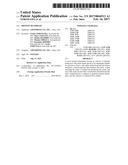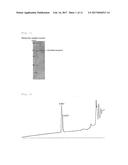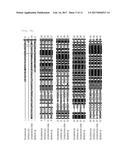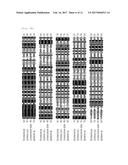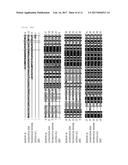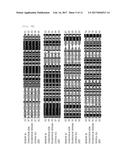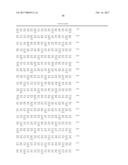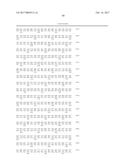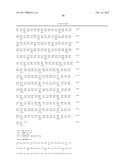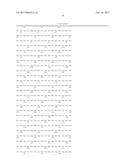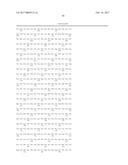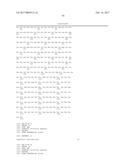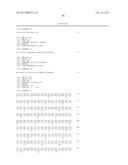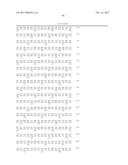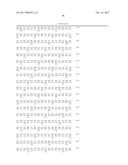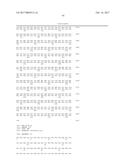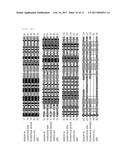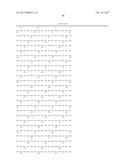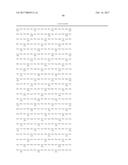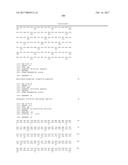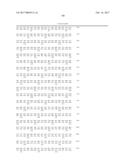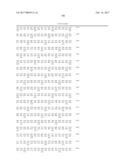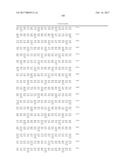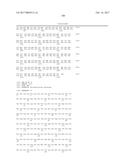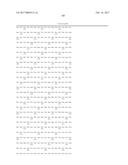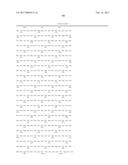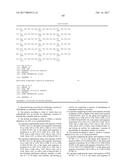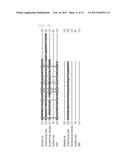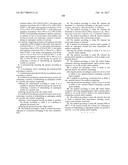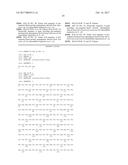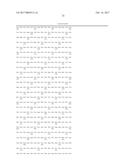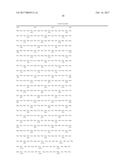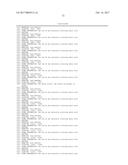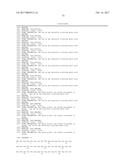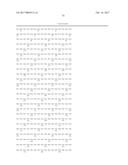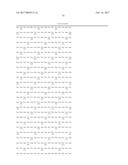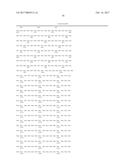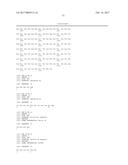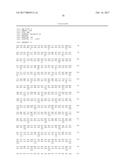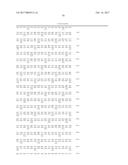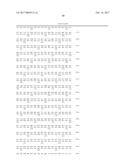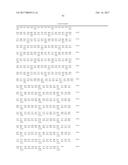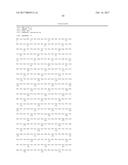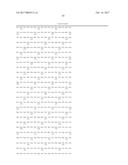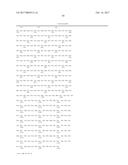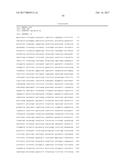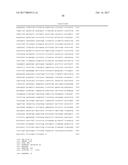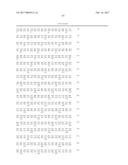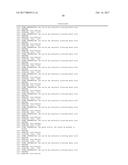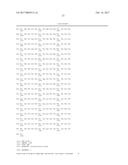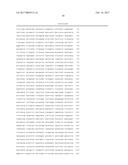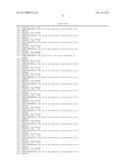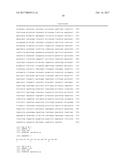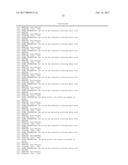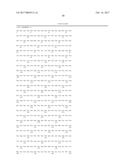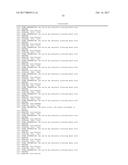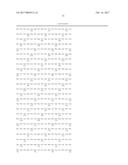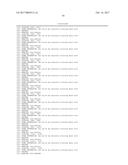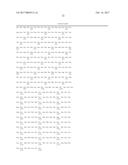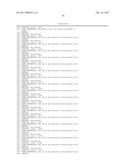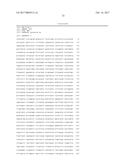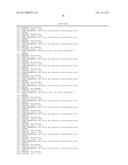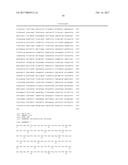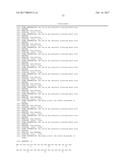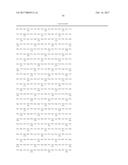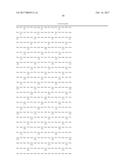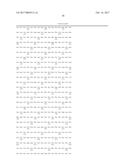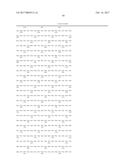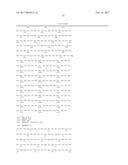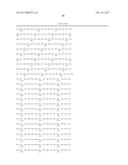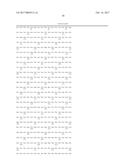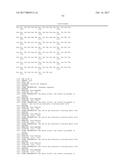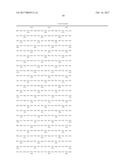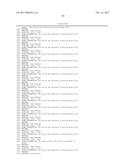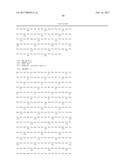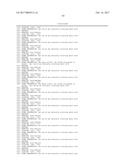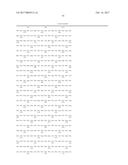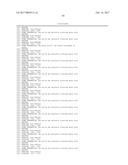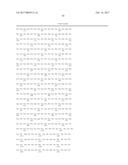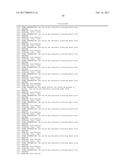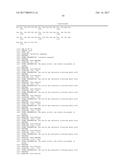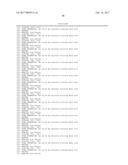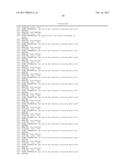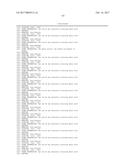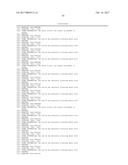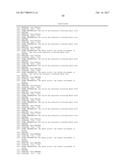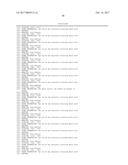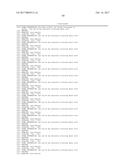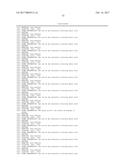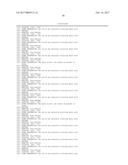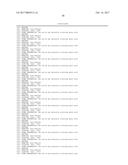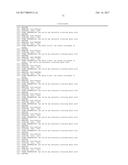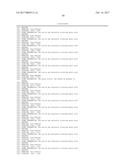Patent application title: PROTEIN DEAMIDASE
Inventors:
Noriko Yokoyama (Kawasaki-Shi, JP)
Mayu Nakano (Kawasaki-Shi, JP)
Shuhei Hashiro (Kawasaki-Shi, JP)
Masako Hiraga (Kawasaki-Shi, JP)
Kazutaka Shimbo (Kawasaki-Shi, JP)
Ayaka Tokunaga (Kawasaki-Shi, JP)
Assignees:
Ajinomoto Co., Inc.
IPC8 Class: AC12N982FI
USPC Class:
1 1
Class name:
Publication date: 2017-02-16
Patent application number: 20170044513
Abstract:
A novel protein deamidase having an activity of directly acting on a side
chain amide group of an asparagine residue in a protein to form a side
chain carboxyl group and release ammonia, a microorganism that produces
the same, a gene encoding the same, a method for producing the same, and
use of the same are provided. A bacterium classified into the class
Actinobacteria is cultured to generate protein deamidase, and the enzyme
is collected from culture.Claims:
1. A protein having an activity for catalyzing a reaction of deamidating
an asparagine residue in a protein.
2. The protein according to claim 1, which does not substantially have an activity for catalyzing a reaction of hydrolyzing a peptide bond in a protein.
3. The protein according to claim 1, which is a protein defined in (A), (B), or (C) mentioned below: (A) a protein comprising the amino acid sequence of SEQ ID NO: 10 or 11, the amino acid sequence of positions 63 to 1260, 245 to 1378, 245 to 1260, or 131 to 1260 of SEQ ID NO: 10, or the amino acid sequence of positions 47 to 1257, 59 to 1258, 96 to 1101, 241 to 1378, 244 to 1258, 244 to 1257, 244 to 1101, 129 to 1258, 120 to 1257, or 120 to 1101 of SEQ ID NO: 11; (B) a protein comprising the amino acid sequence of SEQ ID NO: 10 or 11, the amino acid sequence of positions 63 to 1260, 245 to 1378, 245 to 1260, or 131 to 1260 of SEQ ID NO: 10, or the amino acid sequence of positions 47 to 1257, 59 to 1258, 96 to 1101, 241 to 1378, 244 to 1258, 244 to 1257, 244 to 1101, 129 to 1258, 120 to 1257, or 120 to 1101 of SEQ ID NO: 11 but including substitution, deletion, insertion, or addition of 1 to 10 amino acid residues, and having an activity for catalyzing a reaction of deamidating an asparagine residue in a protein; (C) a protein comprising an amino acid sequence showing an identity of 90% or higher to the amino acid sequence of SEQ ID NO: 10 or 11, the amino acid sequence of positions 63 to 1260, 245 to 1378, 245 to 1260, or 131 to 1260 of SEQ ID NO: 10, or the amino acid sequence of positions 47 to 1257, 59 to 1258, 96 to 1101, 241 to 1378, 244 to 1258, 244 to 1257, 244 to 1101, 129 to 1258, 120 to 1257, or 120 to 1101 of SEQ ID NO: 11, and having an activity for catalyzing a reaction of deamidating an asparagine residue in a protein.
4. The protein according to claim 1, which is a protein defined in (a), (b), or (c) mentioned below: (a) a protein comprising the amino acid sequence of SEQ ID NO: 2, 5, 7, 8, or 9, the amino acid sequence of positions 240 to 1355 of SEQ ID NO: 2, the amino acid sequence of positions 181 to 1180 or 67 to 1180 of SEQ ID NO: 5, the amino acid sequence of positions 193 to 1172 or 70 to 1172 of SEQ ID NO: 7, or the amino acid sequence of positions 146 to 989 or 21 to 989 of SEQ ID NO: 8; (b) a protein comprising the amino acid sequence of SEQ ID NO: 2, 5, 7, 8, or 9, the amino acid sequence of positions 240 to 1355 of SEQ ID NO: 2, the amino acid sequence of positions 181 to 1180 or 67 to 1180 of SEQ ID NO: 5, the amino acid sequence of positions 193 to 1172 or 70 to 1172 of SEQ ID NO: 7, or the amino acid sequence of positions 146 to 989 or 21 to 989 of SEQ ID NO: 8 but including substitution, deletion, insertion, or addition of one or several amino acid residues, and having an activity for catalyzing a reaction of deamidating an asparagine residue in a protein; (c) a protein comprising an amino acid sequence showing an identity of 90% or higher to the amino acid sequence of SEQ ID NO: 2, 5, 7, 8, or 9, the amino acid sequence of positions 240 to 1355 of SEQ ID NO: 2, the amino acid sequence of positions 181 to 1180 or 67 to 1180 of SEQ ID NO: 5, the amino acid sequence of positions 193 to 1172 or 70 to 1172 of SEQ ID NO: 7, or the amino acid sequence of positions 146 to 989 or 21 to 989 of SEQ ID NO: 8, and having an activity for catalyzing a reaction of deamidating an asparagine residue in a protein.
5. A polynucleotide encoding the protein according to claim 1.
6. A recombinant vector containing the polynucleotide according to claim 5.
7. A transformant introduced with the recombinant vector according to claim 6.
8. A method for producing a protein having an activity for catalyzing a reaction of deamidating an asparagine residue in a protein, the method comprising: culturing the transformant according to claim 7 in a medium to generate the protein having the activity for catalyzing a reaction of deamidating an asparagine residue in a protein; and collecting the protein from the culture broth.
9. A method for producing a protein having an activity for catalyzing a reaction of deamidating an asparagine residue in a protein, the method comprising: culturing a microorganism having an ability to produce the protein according to claim 1 in a medium to generate the protein; and collecting the protein from the culture broth.
10. The method according to claim 9, wherein the microorganism is a bacterium belonging to the class Actinobacteria.
11. The method according to claim 10, wherein the bacterium is a bacterium belonging to the genus Luteimicrobium, Agromyces, Microbacterium, or Leifsonia.
12. The method according to claim 11, wherein the bacterium is Luteimicrobium album, Agromyces sp., Microbacterium testaceum, Leifsonia xyli, or Leifsonia aquatica.
13. The method according to claim 8, which comprises treating the protein with a processing enzyme.
14. The method according to claim 13, wherein the processing enzyme is protease.
15. A method for producing a protein and/or peptide of which an asparagine residue has been deamidated, the method comprising: allowing the protein according to claim 1 to act on a protein and/or peptide.
16. The method according to claim 15, wherein the protein and/or peptide is contained in a food or drink or raw material thereof.
17. The method according to claim 15, which further comprises allowing transglutaminase and/or protein glutaminase to act on the protein and/or peptide.
18. A method for reforming a food or drink or raw material thereof, the method comprising: allowing the protein according to claim 1 to act on a food or drink or raw material thereof containing a protein and/or peptide.
19. A method for producing a reformed food or drink or raw material thereof, the method comprising: allowing the protein according to claim 1 to act on a food or drink or raw material thereof containing a protein and/or peptide.
20. The method according to claim 18, which further comprises allowing transglutaminase and/or protein glutaminase to act on the food or drink or raw material thereof containing a protein and/or peptide.
21. The method according to claim 16, wherein the food or drink is selected from mayonnaise, dressing, cream, yogurt, meat product, and bread.
22. The method according to claim 15, wherein 0.001 to 500 U of the protein having the activity for catalyzing a reaction of deamidating an asparagine residue in a protein is used for 1 g of the protein and/or peptide.
Description:
TECHNICAL FIELD
[0001] The present invention relates to a novel protein deamidase, a polynucleotide encoding the enzyme, a recombinant vector containing the polynucleotide, a transformant introduced with the vector, a method for producing the enzyme, and a method for deamidating a protein using the enzyme.
BACKGROUND ART
[0002] Deamidation of a protein improves various functional properties of the protein (Non-patent document 1). Therefore, it is expected that deamidation of a protein expands use of the protein. Among the amino acids that constitute proteins, glutamine and asparagine have an amide group. These are converted into glutamic acid and aspartic acid by deamidation, respectively. By deamidation, the negative charge of a protein is increased, and the isoelectric point of the protein is lowered. The solubility and water dispersibility of the protein are thereby markedly increased. Further, along with an increase of the electrostatic repulsive force, the interaction of proteins, i.e., association property of the proteins, is reduced. It is also known that the tertiary structure of a protein is loosen by deamidation to provide a change of the higher-order structure, so that a hydrophobic region that has been buried in the inside of the protein molecule is exposed on the molecular surface, and therefore the deamidated protein comes to have amphipathy, which results in improvement of the emulsification power, emulsification stability, foamability, and foam stability of the protein.
[0003] Techniques for deamidation of proteins are classified into chemical techniques and enzymatic techniques. As the chemical deamidation techniques, many methods based on a mild acid or alkaline treatment have been reported. However, all of these have problems, such as problems that they are based on nonspecific reactions, peptide bonds are also cleaved under the acidic or alkaline condition, unexpected by-products are produced. Further, they also have problems that they require facilities for using chemical substances, and impose significant environmental loads. The enzymatic techniques can overcome such problems of the chemical techniques. As the enzymatic deamidation techniques, there have been reported, for example, methods of using protein glutaminase (Patent documents 1 and 2, Non-patent document 2), methods of using protease (Non-patent documents 3 and 4), a method of using transglutaminase (Non-patent document 5), methods of using peptide glutaminase (Non-patent documents 6 and 7), and so forth.
[0004] Among these enzymes, protein glutaminase is the only enzyme that can catalyze deamidation reaction of a high molecular protein without accompanying any side reaction. Use of protease, transglutaminase, and peptide glutaminase has problems since the main reaction catalyzed by protease is cleavage of peptide bonds, the main reaction catalyzed by transglutaminase is crosslinking reaction based on formation of isopeptide bonds between glutamine and lysine, and peptide glutaminase is an enzyme that mainly catalyzes deamidation of decomposed low molecular weight peptides. It is considered that protein glutaminase has high practicality as an enzyme having a high deamidation ability for a high molecular weight protein. There have already been reported findings concerning improvement in functions of wheat proteins, milk proteins (casein and whey proteins), and soybean proteins provided by protein glutaminase (Non-patent documents 8 to 11). In patent documents, there have also been reported findings concerning improvement of qualities of actual foods, for example, yogurt, ice cream, coffee whitener, noodles, meat, and so forth provided by protein glutaminase (Patent documents 3 to 7). However, it is definitely described that protein glutaminase uses a glutamine residue in a protein as a substrate, and does not act on asparagine residue at all (Non-patent documents 2 and 12), and hence, effect of the treatment with this enzyme is limited. In fact, amino acids constituting plant and animal proteins contain a large amount of asparagine, and hence, it is preferable to deamidate not only glutamine, but also asparagine, for obtaining further functional reforming effect by deamidation.
[0005] Asparaginase (EC 3.5.1.1) is widely known as an enzyme that catalyzes hydrolysis of asparagine to generate aspartic acid. However, asparaginase is an enzyme that specifically acts on asparagine of the free form, and cannot deamidate an asparagine residue in a peptide or high molecular weight protein. There is also known an enzyme that catalyzes the reaction of deamidating an N-terminus asparagine residue having a free a-amino group is known (Non-patent document 13). However, this enzyme cannot deamidate an asparagine residue in a protein other than N-terminus asparagine residue.
[0006] As described above, any enzyme that deamidates an asparagine residue in a protein (except for N-terminus asparagine residue having a free a-amino group) is not known.
PRIOR ART REFERENCES
Patent documents
[0007] Patent document 1: Japanese Patent Laid-open (Kokai) No. 2001-218590
[0008] Patent document 2: Japanese Patent Laid-open (Kokai) No. 2005-052158
[0009] Patent document 3: WO2011/024994
[0010] Patent document 4: US2013-22710
[0011] Patent document 5: WO2011/108633
[0012] Patent document 6: Japanese Patent Laid-open (Kokai) No. 2009-219419
[0013] Patent document 7: WO2006/075771
Non-Patent Documents
[0014] Non-patent document 1: Hamada J. S., 1994, Critical Reviews in Food Science and Nutrition, 34, 283
[0015] Non-patent document 2: Yamaguchi S, Jeenes D J, and Archer D B, 2001, Eur. J. Biochem., 268(5), 1410
[0016] Non-patent document 3: Kato A., Tanaka A., Matsudomi N., Kobayashi K., 1987, J. Agric. Food Chem., 35, 224
[0017] Non-patent document 4: Kato, A., Tanaka, A., Lee, Y., Matsudomi, N. & Kobayashi, K., 1987, J. Agric. Food Chem. 35, 285
[0018] Non-patent document 5: Motoki M., Seguro K., Nio N., Takinami K., 1986, Agric. Biol. Chem., 50, 3025-3030
[0019] Non-patent document 6: Hamada J. S., Marshall W. E., 1989, J. Food. Sci., 54, 598-601, 635
[0020] Non-patent document 7: Hamada J. S., Marshall W. F., 1988, J. Food. Sci., 53, 1132-1134, 1149
[0021] Non-patent document 8: Suppavorasatit I., De Mejia E. G., Cadwallader K. R., 2011, J. Agric. Food Chem., 59, 11621
[0022] Non-patent document 9: Yong Y. H., Yamaguchi S., Matsumura Y., 2006, J. Agric. Food Chem., 54, 6034
[0023] Non-patent document 10: Miwa, N., Yokoyama, K., Noriki Nio, N., Sonomoto, K., 2013, J. Agric. Food Chem., 61, 2205
[0024] Non-patent document 11: Miwa, N., Yokoyama, K., Wakabayashi, H., Nio, N., 2010, Int. Dairy J., 20, 393
[0025] Non-patent document 12: The Latest Technology and Application of Food Enzymatic Chemistry - Prospects to Food Proteomics, 2004, ISBN 978-4-7813-0127-3, Chapter 3, p.147
[0026] Non-patent document 13: Stewart A E, Arfin S M, Bradshaw R A, 1994, J. Biol. Chem., 1994 Sep. 23; 269(38): 23509-17
SUMMARY OF THE INVENTION
Object to be Achieved by the Invention
[0027] An object of the present invention is to provide a novel protein deamidase (protein asparaginase) that catalyzes the reaction of deamidating an asparagine residue in a protein.
Means for Achieving the Object
[0028] The inventors of the present invention conducted various researches in order to achieve the aforementioned object. As a result, they found microorganisms that produce an enzyme that catalyzes the reaction of specifically deamidating an asparagine residue in a protein without causing decomposition and crosslinking of the protein by using a screening system using a peptide having an asparagine residue as a sole nitrogen source, and accomplished the present invention.
[0029] That is, the present invention can be embodied, for example, as follows.
[0030] [1]
[0031] A protein having an activity for catalyzing a reaction of deamidating an asparagine residue in a protein.
[0032] [2]
[0033] The protein according to [1], which does not substantially have an activity for catalyzing a reaction of hydrolyzing a peptide bond in a protein.
[0034] [3]
[0035] The protein according to [1] or [2], which is a protein defined in (A), (B), or (C) mentioned below:
[0036] (A) a protein comprising the amino acid sequence of SEQ ID NO: 10 or 11, the amino acid sequence of positions 63 to 1260, 245 to 1378, 245 to 1260, or 131 to 1260 of SEQ ID NO: 10, or the amino acid sequence of positions 47 to 1257, 59 to 1258, 96 to 1101, 241 to 1378, 244 to 1258, 244 to 1257, 244 to 1101, 129 to 1258, 120 to 1257, or 120 to 1101 of SEQ ID NO: 11;
[0037] (B) a protein comprising the amino acid sequence of SEQ ID NO: 10 or 11, the amino acid sequence of positions 63 to 1260, 245 to 1378, 245 to 1260, or 131 to 1260 of SEQ ID NO: 10, or the amino acid sequence of positions 47 to 1257, 59 to 1258, 96 to 1101, 241 to 1378, 244 to 1258, 244 to 1257, 244 to 1101, 129 to 1258, 120 to 1257, or 120 to 1101 of SEQ ID NO: 11 but including substitution, deletion, insertion, or addition of 1 to 10 amino acid residues, and having an activity for catalyzing a reaction of deamidating an asparagine residue in a protein;
[0038] (C) a protein comprising an amino acid sequence showing an identity of 90% or higher to the amino acid sequence of SEQ ID NO: 10 or 11, the amino acid sequence of positions 63 to 1260, 245 to 1378, 245 to 1260, or 131 to 1260 of SEQ ID NO: 10, or the amino acid sequence of positions 47 to 1257, 59 to 1258, 96 to 1101, 241 to 1378, 244 to 1258, 244 to 1257, 244 to 1101, 129 to 1258, 120 to 1257, or 120 to 1101 of SEQ ID NO: 11, and having an activity for catalyzing a reaction of deamidating an asparagine residue in a protein.
[0039] [4]
[0040] The protein according to any one of [1] to [3], which is a protein defined in (a), (b), or (c) mentioned below:
[0041] (a) a protein comprising the amino acid sequence of SEQ ID NO: 2, 5, 7, 8, or 9, the amino acid sequence of positions 240 to 1355 of SEQ ID NO: 2, the amino acid sequence of positions 181 to 1180 or 67 to 1180 of SEQ ID NO: 5, the amino acid sequence of positions 193 to 1172 or 70 to 1172 of SEQ ID NO: 7, or the amino acid sequence of positions 146 to 989 or 21 to 989 of SEQ ID NO: 8;
[0042] (b) a protein comprising the amino acid sequence of SEQ ID NO: 2, 5, 7, 8, or 9, the amino acid sequence of positions 240 to 1355 of SEQ ID NO: 2, the amino acid sequence of positions 181 to 1180 or 67 to 1180 of SEQ ID NO: 5, the amino acid sequence of positions 193 to 1172 or 70 to 1172 of SEQ ID NO: 7, or the amino acid sequence of positions 146 to 989 or 21 to 989 of SEQ ID NO: 8 but including substitution, deletion, insertion, or addition of one or several amino acid residues, and having an activity for catalyzing a reaction of deamidating an asparagine residue in a protein;
[0043] (c) a protein comprising an amino acid sequence showing an identity of 90.degree. or higher to the amino acid sequence of SEQ ID NO: 2, 5, 7, 8, or 9, the amino acid sequence of positions 240 to 1355 of SEQ ID NO: 2, the amino acid sequence of positions 181 to 1180 or 67 to 1180 of SEQ ID NO: 5, the amino acid sequence of positions 193 to 1172 or 70 to 1172 of SEQ ID NO: 7, or the amino acid sequence of positions 146 to 989 or 21 to 989 of SEQ ID NO: 8, and having an activity for catalyzing a reaction of deamidating an asparagine residue in a protein.
[0044] [5 ]
[0045] A polynucleotide encoding the protein according to any one of [1] to [4].
[0046] [6]
[0047] A recombinant vector containing the polynucleotide according to [5].
[0048] [7]
[0049] A transformant introduced with the recombinant vector according to [6].
[0050] [8]
[0051] A method for producing a protein having an activity for catalyzing a reaction of deamidating an asparagine residue in a protein, the method comprising:
[0052] culturing the transformant according to [7] in a medium to generate the protein according to any one of [1] to [4]; and
[0053] collecting the protein from the culture broth.
[0054] [9]
[0055] A method for producing a protein having an activity for catalyzing a reaction of deamidating an asparagine residue in a protein, the method comprising:
[0056] culturing a microorganism having an ability to produce the protein according to any one of [1] to [4] in a medium to generate the protein; and
[0057] collecting the protein from the culture broth.
[0058] [10]
[0059] The method according to [9], wherein the microorganism is a bacterium belonging to the class Actinobacteria.
[0060] [11]
[0061] The method according to [10], wherein the bacterium is a bacterium belonging to the genus Luteimicrobium, Agromyces, Microbacterium, or Leifsonia.
[0062] [12]
[0063] The method according to [11], wherein the bacterium is Luteimicrobium album, Agromyces sp., Microbacterium testaceum, Leifsonia xyli, or Leifsonia aquatica.
[0064] [13]
[0065] The method according to any one of [8] to [12], which comprises treating the protein with a processing enzyme.
[0066] [14]
[0067] The method according to [13], wherein the processing enzyme is protease.
[0068] [15]
[0069] A method for producing a protein and/or peptide of which an asparagine residue has been deamidated, the method comprising:
[0070] allowing the protein according to any one of [1] to [4] to act on a protein and/or peptide.
[0071] [16]
[0072] The method according to [15], wherein the protein and/or peptide is contained in a food or drink or raw material thereof.
[0073] [17]
[0074] The method according to [15] or [16], which further comprises allowing transglutaminase and/or protein glutaminase to act on the protein and/or peptide.
[0075] [18]
[0076] A method for reforming a food or drink or raw material thereof, the method comprising:
[0077] allowing the protein according to any one of [1] to [4] to act on a food or drink or raw material thereof containing a protein and/or peptide.
[0078] [19]
[0079] A method for producing a reformed food or drink or raw material thereof, the method comprising:
[0080] allowing the protein according to any one of [1] to [4] to act on a food or drink or raw material thereof containing a protein and/or peptide.
[0081] [20]
[0082] The method according to [18] or [19], which further comprises allowing transglutaminase and/or protein glutaminase to act on the food or drink or raw material thereof containing a protein and/or peptide.
[0083] [21]
[0084] The method according to any one of [16] to [20], wherein the food or drink is selected from mayonnaise, dressing, cream, yogurt, meat product, and bread.
[0085] [22]
[0086] The method according to any one of [15] to [21], wherein 0.001 to 500 U of the protein according to any one of [1] to [4] is used for 1 g of the protein and/or peptide.
BRIEF DESCRIPTION OF THE DRAWINGS
[0087] [FIG. 1] A photograph showing the result of SDS-PAGE of protein asparaginase derived from Luteimicrobium album (Example 2).
[0088] [FIG. 2] A diagram showing the result of HPLC analysis of the insulin B chain treated with protein asparaginase derived from Luteimicrobium album (Example 5).
[0089] [FIG. 3] A photograph showing the results of isoelectric focusing of casein treated with protein asparaginase derived from Luteimicrobium album (Example 6). Control group is a group that used a treatment with water, Test group 1 is a group that used a treatment with protein asparaginase (0.68 U/ml), and Test group 2 is a group that used a treatment with protein asparaginase (2.7 U/ml).
[0090] [FIG. 4] A photograph showing the results of SDS-PAGE of casein treated with various enzymes (Example 6). Control group is a group that used a treatment with water, Test group 2 is a group that used a treatment with protein asparaginase (2.7 U/ml), and Comparative group is a group that used a treatment with protein glutaminase (10 U/ml). "-TG" means that transglutaminase was not used in combination, and "+TG" means that transglutaminase was used in combination.
[0091] [FIG. 5] Diagrams showing the results of HPLC analysis of the insulin B chain treated with protein asparaginase derived from Leifsonia xyli (Example 7).
[0092] [FIG. 6] A photograph showing the results of SDS-PAGE of protein asparaginase derived from Agromyces sp. (Example 9). Lane 1 is for a chromatography-purified fraction, and lanes 2 to 6 are for anion exchange chromatography-purified fractions.
[0093] [FIG. 7] A diagram showing the result of alignment of the sequences of SEQ ID NOS: 2 and 5.
[0094] [FIG. 8] A diagram showing the result of alignment of the sequences of SEQ ID NOS: 2, 5, 7, and 8.
[0095] [FIG. 9] A diagram showing the result of alignment of the sequences of SEQ ID NOS: 2, 5, 7, 8, and 9.
[0096] [FIG. 10] A design drawing of a pro-sequence-fused protein asparaginase.
[0097] [FIG. 11] A photograph showing the results of SDS-PAGE of a pro-sequence-fused protein asparaginase derived from Agromyces sp., which was expressed by secretory expression from Corynebacterium glutamicum (Example 12, <1>). The arrow indicates the position of the target protein.
[0098] [FIG. 12] A photograph showing the results of SDS-PAGE of a pro-sequence-fused protein asparaginase, which was intracellularly expressed in Escherichia coli (Example 12, <2>). The arrows indicate the positions of the target protein.
MODES FOR CARRYING OUT THE INVENTION
<1> Protein Deamidase
[0099] The present invention provides protein deamidase.
[0100] In the present invention, the term "protein deamidase" refers to a protein having an activity for catalyzing a reaction of deamidating an asparagine residue in a protein. This activity is also referred to as "protein asparaginase activity". In the present invention, protein deamidase is also referred to as "protein asparaginase".
[0101] The term "asparagine residue in a protein" means an asparagine residue existing in a protein, except for N-terminus asparagine residue having a free a-amino group. Protein deamidase may or may not have an activity for catalyzing a reaction of deamidating an N-terminus asparagine residue having a free a-amino group, so long as it has an activity for catalyzing a reaction of deamidating such an "asparagine residue in a protein". Protein deamidase may or may not have an activity for catalyzing a reaction of deamidating monomer asparagine.
[0102] In the present invention, a protein to be deamidated by protein deamidase is also referred to as "substrate protein". The length of the substrate protein is not particularly limited so long as the length is 2 residues (dipeptide) or longer. The length of the substrate protein may be, for example, 2 residues (dipeptide) or longer, 3 residues (tripeptide) or longer, 10 residues or longer, 50 residues or longer, or 100 residues or longer. That is, unless otherwise stated, the term "substrate protein" also includes a substance called peptide, such as oligopeptide and polypeptide.
[0103] An asparagine residue is hydrolyzed into an aspartic acid residue and ammonia by deamidation. Therefore, the protein asparaginase activity can be measured on the basis of, for example, generation of ammonia accompanying the deamidation of an asparagine residue. For example, protein deamidase can be allowed to act on a peptide having a length of two or more residues, containing asparagine residue, and not containing glutamine residue (such as Cbz-Asn-Gly) as a substrate, and then the protein asparaginase activity can be calculated on the basis of the amount of released ammonia. Specifically, the protein asparaginase activity can be calculated with, for example, the conditions described in the Examples section. That is, the protein asparaginase activity can be measured by adding 25 .mu.L of an enzyme solution of an appropriate concentration to 125 .mu.L of a 0.2 mol/L phosphate buffer (pH 6.5) containing 30 mmol/L of Cbz-Asn-Gly, incubating the mixture at 37.degree. C. for 60 minutes, then adding 150 .mu.L of a 12% trichloroacetic acid solution to terminate the reaction, and measuring the ammonia concentration in the supernatant. In the present invention, the enzymatic activity for generating 1 .mu.mol of ammonia in 1 minute under these conditions is defined as 1 unit (U) of the protein asparaginase activity.
[0104] It is preferred that protein deamidase does not substantially have an activity for catalyzing the reaction of deamidating a glutamine residue in a protein. This activity is also referred to as "protein glutaminase activity". A glutamine residue is hydrolyzed into a glutamic acid residue and ammonia by deamidation. Therefore, the protein glutaminase activity can be measured on the basis of, for example, generation of ammonia accompanying deamidation of a glutamine residue. For example, protein deamidase can be allowed to act on a peptide having a length of two or more residues, containing glutamine residue, and not containing asparagine residue (such as Cbz-Gln-Gly) as a substrate, and then the protein glutaminase activity can be calculated on the basis of the amount of released ammonia. Specifically, the protein glutaminase activity can be calculated with, for example, the conditions for measuring the protein asparaginase activity described in the Examples section, provided that the enzymatic reaction is performed by using Cbz-Gln-Gly instead of Cbz-Asn-Gly. That is, the protein glutaminase activity can be measured by adding 25 .mu.L of an enzyme solution of an appropriate concentration to 125 .mu.L of a 0.2 mol/L phosphate buffer (pH 6.5) containing 30 mmol/L of Cbz-Gln-Gly, incubating the mixture at 37.degree. C. for 60 minutes, adding 150 .mu.L of a 12% trichloroacetic acid solution to terminate the reaction, and measuring the ammonia concentration in the supernatant. In the present invention, the enzymatic activity for generating 1 pmol of ammonia in 1 minute under these conditions is defined as 1 unit (U) of the protein glutaminase activity. The expression "protein deamidase does not substantially have the protein glutaminase activity" may mean that, for example, the ratio of the protein glutaminase activity to the protein asparaginase activity (namely, specific activity of the protein glutaminase activity/specific activity of the protein asparaginase activity) of protein deamidase is 1/100 or smaller, 1/1000 or smaller, 1/10000 or smaller, or (zero). The ratio of the specific activities can be calculated by measuring the protein asparaginase activity and protein glutaminase activity.
[0105] It is preferred that protein deamidase does not substantially have an activity for catalyzing the reaction of hydrolyzing a peptide bond in a protein. This activity is also referred to as "protease activity". The protease activity can be measured by, for example, a known technique. Specifically, the protease activity can be calculated, for example, by using azocasein as a substrate under the following conditions. That is, 0.5 mL of an enzyme solution of an appropriate concentration is added to 1.0 mL of a 50 mM Tris-hydrochloric acid buffer (pH 8.0) containing 1% azocasein, the mixture is incubated at 37.degree. C. for 30 minutes, and then 2.0 mL of a 12% trichloroacetic acid solution is added to terminate the reaction. The reaction mixture is centrifuged (15,000 rpm, 4.degree. C., 5 minutes), and then A.sub.405 of the supernatant is measured. As controls, the same procedure is performed for a test group in which 0.5 mL of water is added instead of the enzyme solution, and a test group for compensating influence of color of ingredients that may be contained in the enzyme solution, in which 1.0 mL of a 50 mM Tris-HCl buffer (pH 8.0) not containing azocasein is used instead of the 50 mM Tris-HC1 buffer (pH 8.0) containing azocasein, and A.sub.405 of the supernatant is measured for each of the groups. On the basis of these measured values of A.sub.405, an increase of A.sub.405 provided by the enzyme is calculated. In the present invention, the enzymatic activity for increasing A.sub.405 by 0.01 in 1 minute under these conditions is defined as 1 unit (U) of the protease activity. The expression "protein deamidase does not substantially have the protease activity" may mean that, for example, when a protein is treated with protein deamidase so that deamidation of asparagine residues takes place in a desired degree, the protein is not significantly decomposed into lower molecular weight molecules due to cleavage of peptide bonds by the treatment. Also, the expression "protein deamidase does not substantially have the protease activity" may mean that, for example, the ratio of the protease activity to the protein asparaginase activity (namely, specific activity of the protease activity /specific activity of the protein asparaginase activity) of protein deamidase is 1/100 or smaller, 1/1000 or smaller, 1/10000 or smaller, or (zero). The ratio of the specific activities can be calculated by measuring the protein asparaginase activity and protease activity.
[0106] It is preferred that protein deamidase does not substantially have an activity for catalyzing the reaction of crosslinking proteins. This activity is also referred to as "protein crosslinking activity". The protein crosslinking activity can be measured by, for example, a known technique. The expression "protein deamidase does not substantially have the protein crosslinking activity" may mean that, for example, when proteins are treated with protein deamidase so that deamidation of asparagine residues takes place in a desired degree, the proteins are not significantly crosslinked into higher molecular weight molecules due to crosslinking of the proteins caused by the treatment. The expression "protein deamidase does not substantially have the protein crosslinking activity" may specifically mean that, for example, when 25 .mu.L of an enzyme solution adjusted to have 2.7 U/ml of the protein asparaginase activity is added to 500 pL of a 20 mM sodium phosphate buffer (pH 7.0) containing 2% w/v casein sodium, the reaction is performed at 37.degree. C. for 1 hour, and the enzyme is inactivated by a treatment at 100.degree. C. for 5 minutes, the amount of uncrosslinked casein corresponds to 90% or more, or 95% or more of the same of a control group (sample obtained by performing the reaction in the same manner as described above provided that 25 .mu.L of water is added instead of the enzyme solution). The "amount of uncrosslinked casein" can be measured and compared by known techniques. For example, measurement and comparison of the "amount of uncrosslinked casein" may be performed by measuring molecular weight distribution using gel filtration chromatography, or by confirming position and concentration of an objective band in SDS-PAGE.
[0107] Examples of protein deamidase include, for example, protein deamidases of bacteria belonging to the class Actinobacteria. Examples of the bacteria belonging to the class Actinobacteria include bacteria belonging to the family Microbacteriaceae such as Leifsonia bacteria, Microbacterium bacteria, and Agromyces bacteria, and bacteria belonging to an unclassified family such as Luteimicrobium bacteria. Examples of the Leifsonia bacteria include Leifsonia xyli and Leifsonia aquatica. Examples of the Microbacterium bacteria include Microbacterium testaceum. Examples of the Agromyces bacteria include Agromyces sp. obtained in the Examples section mentioned later. Examples of the Luteimicrobium bacteria include Luteimicrobium album. That is, protein deamidase may be, for example, a protein derived from such bacteria.
[0108] The amino acid sequence of protein deamidase of Luteimicrobium album AJ111072 (NITE P-01650) and the nucleotide sequence of the gene encoding it are shown as SEQ ID NOS: 2 and 3, respectively. The amino acid sequence of protein deamidase of Agromyces sp. AJ111073 (NITE BP-01782) and the nucleotide sequence of the gene encoding it are shown as SEQ ID NOS: 5 and 6, respectively. The amino acid sequence of protein deamidase of Microbacterium testaceum is shown as SEQ ID NO: 7. The amino acid sequence of protein deamidase of Leifsonia xyli.quadrature.AJ111071 (NITE P-01649) is shown as SEQ ID NO: 8. The amino acid sequence of protein deamidase of Leifsonia aquatica is shown as SEQ ID NO: 9. That is, protein deamidase may be, for example, a protein having the amino acid sequence of SEQ ID NO: 2, 5, 7, 8, or 9. Protein deamidase may also be, for example, a protein encoded by a gene having the nucleotide sequence shown as SEQ ID NO: 3 or 6. The expression of "having an (amino acid or nucleotide) sequence" includes both cases of "comprising the (amino acid or nucleotide) sequence" and "consisting of the (amino acid or nucleotide) sequence".
[0109] Luteimicrobium album AJ111072 (NITE P-01650) was deposited at the independent administrative agency, National Institute of Technology and Evaluation, Patent Microorganisms Depositary (NPMD) (#122, 2-5-8 Kazusakamatari, Kisarazu-shi, Chiba-ken, 292-0818, Japan) on Jul. 5, 2013, and assigned an accession number of NITE P-01650.
[0110] Agromyces sp. AJ111073 (NITE BP-01782) was deposited at the independent administrative agency, National Institute of Technology and Evaluation, Patent Microorganisms Depositary (NPMD) (#122, 2-5-8 Kazusakamatari, Kisarazu-shi, Chiba-ken, 292-0818, Japan) on Dec. 11, 2013. Then, the deposit was converted to an international deposit under the provisions of the Budapest Treaty on March 4, 2015, and assigned an accession number of NITE BP-01782 (receipt number NITE ABP-01782).
[0111] Leifsonia xyli AJ111071 (NITE P-01649) was deposited at the independent administrative agency, National Institute of Technology and Evaluation, Patent Microorganisms Depositary (NPMD) (#122, 2-5-8 Kazusakamatari, Kisarazu-shi, Chiba-ken, 292-0818, Japan) on Jul. 5, 2013, and assigned an accession number of NITE P-01649.
[0112] The amino acid sequence shown as SEQ ID NO: 2, 5, 7, 8, or 9 may contain a pre-pro-region (pre-sequence and pro-sequence). A protein containing a pre-pro-region is also referred to as "pre-pro-protein". A protein containing a pro-sequence, but not containing pre-sequence is also referred to as "pro-protein". A protein not containing pre-pro-region is also referred to as "mature protein". Protein deamidase may be, for example, a protein having the amino acid sequence of SEQ ID NO: 2, 5, 7, 8, or 9 except for a pre-pro-region (namely, amino acid sequence of mature protein), or a protein having the amino acid sequence of SEQ ID NO: 2, 5, 7, 8, or 9 except for a pre-region (namely, amino acid sequence of pro-protein). The amino acid sequence of the mature protein of protein deamidase of Luteimicrobium album corresponds to positions 240 to 1355 of SEQ ID NO: 2. The amino acid sequence of the mature protein of protein deamidase of Agromyces sp. corresponds to positions 181 to 1180 of SEQ ID NO: 5. The amino acid sequence of the mature protein of protein deamidase of Microbacterium testaceum corresponds to positions 193 to 1172 of SEQ ID NO: 7. The amino acid sequence of the mature protein of protein deamidase of Leifsonia xyli corresponds to positions 146 to 989 of SEQ ID NO: 8. The amino acid sequence of the pro-protein of protein deamidase of Agromyces sp. corresponds to positions 67 to 1180 of SEQ ID NO: 5. The amino acid sequence of the pro-protein of protein deamidase of Microbacterium testaceum corresponds to positions 70 to 1172 of SEQ ID NO: 7. The amino acid sequence of the pro-protein of protein deamidase of Leifsonia xyli corresponds to positions 21 to 989 of SEQ ID NO: 8. Protein deamidase may also be, for example, a protein encoded by a gene having a part of the nucleotide sequence of SEQ ID NO: 3 or 6, the part encoding the amino acid sequence other than the pre-pro-region (namely, nucleotide sequence encoding the amino acid sequence of the mature protein), or a protein encoded by a gene having a part of the nucleotide sequence of SEQ ID NO: 3 or 6, the part encoding the amino acid sequence other than the pre-region (namely, nucleotide sequence encoding the amino acid sequence of pro-protein). The nucleotide sequence encoding the amino acid sequence of the mature protein of protein deamidase of Luteimicrobium album corresponds to positions 718 to 4068 of SEQ ID NO: 3. The nucleotide sequence encoding the amino acid sequence of the mature protein of protein deamidase of Agromyces sp. corresponds to positions 541 to 3543 of SEQ ID NO: 6. The nucleotide sequence encoding the amino acid sequence of the pro-protein of protein deamidase of Agromyces sp. corresponds to positions 199 to 3543 of SEQ ID NO: 6. The position of the N-terminus residue of the mature protein may shift forward or backward by several residues depending on various conditions such as type of processing enzyme. The term "several residues" referred to here may be, for example, 1, 2, 3, 4, 5, 6, 7, 8, 9, or 10 residues. That is, for example, the amino acid sequence of the mature protein of protein deamidase of Agromyces sp. may correspond to positions 181 .+-.several residues to 1180 of SEQ ID NO: 5. In an embodiment, the amino acid sequence of the mature protein of protein deamidase of Agromyces sp. may corresponds to positions 177 to 1180 of SEQ ID NO: 5.
[0113] Protein deamidase may be, for example, a protein having an amino acid sequence common to the amino acid sequences of two or more kinds of protein deamidases. The common amino acid sequence can be determined by aligning the amino acid sequences of two or more kinds of protein deamidases. The result of alignment of SEQ ID NOS: 2 and 5 is shown in FIG. 7, and the amino acid sequence common to them is shown as SEQ ID NO: 10. The result of alignment of SEQ ID NOS: 2, 5, 7, and 8 is shown in FIG. 8, and the amino acid sequence common to them is shown as SEQ ID NO: 11. The result of alignment of SEQ ID NOS: 2, 5, 7, 8, and 8 is shown in FIG. 9. That is, protein deamidase may be, for example, a protein having the amino acid sequence shown as SEQ ID NO: 10 or 11. Protein deamidase may also be, for example, a protein having a part of an amino acid sequence common to the amino acid sequences of two or more kinds of protein deamidases, the part corresponding to any of these protein deamidases. Examples of such a part of an amino acid sequence corresponding to protein deamidase include the amino acid sequence of positions 63 to 1260 of SEQ ID NO: 10 (corresponding to protein deamidase of Agromyces sp.), the amino acid sequence of positions 47 to 1257 of SEQ ID NO: 11 (corresponding to protein deamidase of Microbacterium testaceum), the amino acid sequence of positions 59 to 1258 of SEQ ID NO: 11 (corresponding to protein deamidase of Agromyces 4sp.), and the amino acid sequence of positions 96 to 1101 of SEQ ID NO: 11 (corresponding to protein deamidase of Leifsonia xyli). Protein deamidase may also be, for example, a protein having a part of an amino acid sequence common to the amino acid sequences of two or more kinds of protein deamidases, the part corresponding to the mature protein of any of those protein deamidases, or a protein having a part of an amino acid sequence common to the amino acid sequences of two or more kinds of protein deamidases, the part corresponding to the pro-protein of any of those protein deamidases. Examples of such a part of an amino acid sequence corresponding to a mature protein of protein deamidase include the amino acid sequence of positions 245 to 1378 of SEQ ID NO: 10 (corresponding to the mature protein of protein deamidase of Luteimicrobium album), the amino acid sequence of positions 245 to 1260 of SEQ ID NO: (corresponding to the mature protein of protein deamidase of Agromyces sp.), the amino acid sequence of positions 241 to 1378 of SEQ ID NO: 11 (corresponding to the mature protein of protein deamidase of Luteimicrobium album), the amino acid sequence of positions 244 to 1258 of SEQ ID NO: 11 (corresponding to the mature protein of protein deamidase of Agromyces sp.), the amino acid sequence of positions 244 to 1257 of SEQ ID NO: 11 (corresponding to the mature protein of protein deamidase of Microbacterium testaceum), and the amino acid sequence of positions 244 to 1101 of SEQ ID NO: 11 (corresponding to the mature protein of protein deamidase of Leifsonia xyli). Examples of such a part of an amino acid sequence corresponding to a pro-protein of protein deamidase include the amino acid sequence of positions 131 to 1260 of SEQ ID NO: 10 (corresponding to the pro-protein of protein deamidase of Agromyces sp.), the amino acid sequence of positions 129 to 1258 of SEQ ID NO: 11 (corresponding to the pro-protein of protein deamidase of Agromyces sp.), the amino acid sequence of positions 120 to 1257 of SEQ ID NO: (corresponding to the pro-protein of protein deamidase of Microbacterium testaceum), and the amino acid sequence of positions 120 to 1101 of SEQ ID NO: 11 (corresponding to the pro-protein of protein deamidase of Leifsonia xyli).
[0114] Protein deamidase may be a variant of any of the protein deamidases exemplified above (for example, a protein having the amino acid sequence of SEQ ID NO: 2, 5, 7, 8, 9, 10, or 11, or a protein having a part of any of those amino acid sequences), so long as the original function is maintained. Similarly, the gene encoding protein deamidase (also referred to as "protein deamidase gene") may be a variant of any of the protein deamidase genes exemplified above (for example, a gene having the nucleotide sequence of SEQ ID NO: 3 or 6, or a gene having a part of any of those nucleotide sequences), so long as the original function is maintained. Such a variant that maintains the original function is also referred to as "conservative variant". Examples of the conservative variant include, for example, a homologue and artificially modified version of the protein deamidases exemplified above and genes encoding them.
[0115] The expression "the original function is maintained" means that a variant of the gene or protein has a function (activity or property) corresponding to the function (activity or property) of the original gene or protein. That is, the expression "the original function is maintained" means that, in the case of protein deamidase, a variant of the protein has the protein asparaginase activity. Further, the expression "the original function is maintained" may also mean that, in the case of the protein deamidase gene, a variant of the gene encodes a protein that maintains the original function (namely, a protein having the protein asparaginase activity).
[0116] Examples of homologues of protein deamidase include, for example, protein deamidases produced by microorganisms obtained by the screening method mentioned later. Examples of homologues of protein deamidase also include, for example, proteins obtained from a public database by BLAST search and FASTA search using any of the aforementioned amino acid sequences as a query sequence. Also, homologues of the aforementioned protein deamidase genes can be obtained by, for example, PCR using a chromosome of any of various microorganisms as the template, and oligonucleotides prepared on the basis of any of those known gene sequences as the primers.
[0117] Protein deamidase may be a protein having any of the aforementioned amino acid sequences (for example, the amino acid sequence of SEQ ID NO: 2, 5, 7, 8, 9, 10, or 11, or a part (e.g. part corresponding to mature protein or part corresponding to pro-protein) of any of those amino acid sequences), but including substitution, deletion, insertion, or addition of one or several amino acid residues at one or several positions, so long as it maintains the original function. Although the number meant by the term "one or several" can differ depending on the positions of amino acid residues in the three-dimensional structure of the protein, or the types of amino acid residues, specifically, it is, for example, 1 to 50, 1 to 40, 1 to 30, preferably 1 to 20, more preferably 1 to 10, still more preferably 1 to 5, particularly preferably 1 to 3.
[0118] The aforementioned substitution, deletion, insertion, or addition of one or several amino acid residues is a conservative mutation that maintains normal function of the protein. Typical examples of the conservative mutation are conservative substitutions. The conservative substitution is a mutation wherein substitution takes place mutually among Phe, Trp, and Tyr, if the substitution site is an aromatic amino acid; among Leu, Ile, and Val, if it is a hydrophobic amino acid; between Gln and Asn, if it is a polar amino acid; among Lys, Arg, and His, if it is a basic amino acid; between Asp and Glu, if it is an acidic amino acid; and between Ser and Thr, if it is an amino acid having a hydroxyl group. Examples of substitutions considered as conservative substitutions include, specifically, substitution of Ser or Thr for Ala, substitution of Gln, His, or Lys for Arg, substitution of Glu, Gln, Lys, His, or Asp for Asn, substitution of Asn, Glu, or Gln for Asp, substitution of Ser or Ala for Cys, substitution of Asn, Glu, Lys, His, Asp, or Arg for Gln, substitution of Gly, Asn, Gln, Lys, or Asp for Glu, substitution of Pro for Gly, substitution of Asn, Lys, Gln, Arg, or Tyr for His, substitution of Leu, Met, Val, or Phe for Ile, substitution of Ile, Met, Val, or Phe for Leu, substitution of Asn, Glu, Gln, His, or Arg for Lys, substitution of Ile, Leu, Val, or Phe for Met, substitution of Trp, Tyr, Met, Ile, or Leu for Phe, substitution of Thr or Ala for Ser, substitution of Ser or Ala for Thr, substitution of Phe or Tyr for Trp, substitution of His, Phe, or Trp for Tyr, and substitution of Met, Ile, or Leu for Val. Further, such substitution, deletion, insertion, addition, inversion, or the like of amino acid residues as mentioned above includes a naturally occurring mutation (mutant or variant), such as those due to a difference of individuals or species of the organism from which the protein is derived.
[0119] Protein deamidase may be a protein having an amino acid sequence showing a homology of 80% or higher, preferably 90% or higher, more preferably 95% or higher, still more preferably 97% or higher, particularly preferably 99% or higher, to the whole of any of the aforementioned amino acid sequences, so long as the original function is maintained. In this description, "homology" can mean "identity".
[0120] When protein deamidase is a conservative variant of any of the aforementioned common amino acid sequences (for example, the amino acid sequence of SEQ ID NO: 10 or 11, or a part (e.g. part corresponding to mature protein or part corresponding to pro-protein) of any of those amino acid sequences), such a variant may be a protein, wherein a mutation has been introduced into a common portion and/or another portion in the common amino acid sequence, so long as the original function is maintained. It is preferred that such a variant is a protein, wherein the common part in the common amino acid sequence is conserved, and a mutation is introduced into another portion.
[0121] Protein deamidase may be a protein encoded by a DNA that hybridizes under stringent conditions with a probe that can be prepared from any of the aforementioned nucleotide sequences (for example, the nucleotide sequence of SEQ ID NO: 3 or 6, or a part (e.g. part encoding mature protein or part encoding pro-protein) of any of those nucleotide sequences), such as a sequence complementary to a part or the whole of any of the aforementioned nucleotide sequences, so long as the original function is maintained. Such a probe can be prepared by PCR using oligonucleotides produced on the basis of any of the aforementioned nucleotide sequences as primers, and a DNA fragment containing any of the aforementioned nucleotide sequences as the template. The "stringent conditions" refer to conditions under which a so-called specific hybrid is formed, and a non-specific hybrid is not formed. Examples of the stringent conditions include those under which highly homologous DNAs hybridize to each other, for example, DNAs not less than 80% homologous, preferably not less than 90% homologous, more preferably not less than 95% homologous, still more preferably not less than 97% homologous, particularly preferably not less than 99% homologous, hybridize to each other, and DNAs less homologous than the above do not hybridize to each other, or conditions of washing of typical Southern hybridization, i.e., conditions of washing once, preferably 2 or 3 times, at a salt concentration and temperature corresponding to 1.times.SSC, 0.1% SDS at 60.degree. C., preferably 0.1.times.SSC, 0.1.degree. SDS at 60.degree. C., more preferably 0.1.times.SSC, 0.1% SDS at 68.degree. C. Further, for example, when a DNA fragment having a length of about 300 bp is used as the probe, the washing conditions of the hybridization can be, for example, 50.degree. C., 2.times.SSC, and 0.1% SDS.
[0122] Such protein deamidase as mentioned above may be, if the amino acid sequence thereof or the nucleotide sequence of the gene encoding it was known at the time of filling of this application, excluded from protein deamidase of the present invention.
[0123] Protein deamidase may be a fusion protein with another amino acid sequence. The "another amino acid sequence" is not particularly limited so long as the fusion protein has the protein asparaginase activity. The "another amino acid sequence" can be selected as required depending on various conditions such as purpose of use thereof. Examples of the "another amino acid sequence" include a peptide tag, signal sequence (pre-sequence), pro-sequence, and recognition sequence of a protease. The "another amino acid sequence" may be bound to, for example, either one or both of the N-terminus and C-terminus of protein deamidase. As the "another amino acid sequence", one kind of amino acid sequence may be used, or two or more kinds of amino acid sequences may be used in combination.
[0124] A peptide tag can be used for, for example, detection and purification of the expressed protein deamidase. Specific examples of the peptide tag include an His tag, FLAG tag, GST tag, Myc tag, MBP (maltose binding protein), CBP (cellulose binding protein), TRX (thioredoxin), GFP (green fluorescent protein), HRP (horseradish peroxidase), ALP (alkaline phosphatase), and Fc region of antibody. Examples of the His tag include 6.times.His tag.
[0125] A signal sequence can be used for, for example, secretory production of protein deamidase. Examples of the signal sequence include a signal sequence recognized by the Sec system secretory pathway and a signal sequence recognized by the Tat system secretory pathway. Specific examples of the signal sequence recognized by the Sec system secretory pathway include a signal sequence of a cell surface protein of coryneform bacteria. Examples of the cell surface protein of coryneform bacteria include PS1 (CspA) and PS2 (CspB) of C. glutamicum (Japanese Patent Laid-open (Kohyo) No. 6-502548), and SlpA (CspA) of C. ammoniagenes (C. stationis) (Japanese Patent Laid-open (Kokai) No. 10-108675). Specific examples of the signal sequence recognized by the Tat system secretory pathway include the TorA signal sequence of E. coli, the SufI signal sequence of E. coli, the PhoD signal sequence of Bacillus subtilis, the LipA signal sequence of Bacillus subtilis, and the IMD signal sequence of Arthrobacter globiformis (WO2013/118544). As the signal sequence, a signal sequence of protein deamidase may be used. A signal sequence can be used by, for example, adding it to the N-terminus of the protein to be produced. Specifically, a signal sequence can be used by, for example, adding it to the N-terminus of a pro-protein or mature protein of protein deamidase. A signal sequence is generally digested with a signal peptidase, when a translation product is secreted out of a microbial cell. Therefore, if secretory production of protein deamidase is performed by using a signal sequence, protein deamidase not having the signal sequence may be secreted out of the microbial cell.
[0126] Specific examples of the pro-sequence include a pro-sequence of protein deamidase. Examples of the pro-sequence of protein deamidase include the sequence of positions 67 to 180 of SEQ ID NO: 5. A pro-sequence can be used by, for example, adding it to the N-terminus of the protein to be produced. Specifically, a pro-sequence can be used by, for example, adding it to the N-terminus of a mature protein of protein deamidase. When secretory production of protein deamidase is performed, protein deamidase may be constituted to contain a signal sequence, a pro-sequence, and a sequence of mature protein in this order from the N-terminus, and expressed. Expression of protein deamidase in the form of having a pro-sequence may contribute to structural stabilization of protein deamidase. By contrast, from the viewpoint of the protein asparaginase activity, it is preferred that protein deamidase eventually obtained does not have a pro-sequence.
[0127] A recognition sequence for a protease can be used for, for example, cleavage of the expressed protein deamidase. It is preferred that the recognition sequence for a protease is a recognition sequence for a protease showing high substrate specificity. Specific examples of the recognition sequence for a protease showing high substrate specificity include the recognition sequence for the factor Xa protease and the recognition sequence for the ProTEV protease. The factor Xa protease and the ProTEV protease recognize the amino acid sequence of Ile-Glu-Gly-Arg (=IEGR, SEQ ID NO: 14) and the amino acid sequence of Glu-Asn-Leu-Tyr-Phe-Gln (=ENLYFQ, SEQ ID NO: 15) in a protein, respectively, to digest the protein specifically at a position on the C-terminus side of the corresponding recognition sequence. For example, when protein deamidase is expressed as a fusion protein with another amino acid sequence such as a peptide tag or pro-sequence, if a recognition sequence for a protease is introduced between protein deamidase and such another amino acid sequence, such another amino acid sequence can be removed from the expressed protein deamidase by using the protease to obtain protein deamidase not having such another amino acid sequence.
[0128] The protein deamidase gene may be one having any of the nucleotide sequences of the protein deamidase genes exemplified above and conservative variants thereof, in which arbitrary codons are replaced with equivalent codons. For example, the protein deamidase gene may be modified so that it has codons optimized for codon usage observed in the host to be used.
[0129] In the present invention, the term "gene" is not limited to DNA, but may include an arbitrary polynucleotide, so long as it encodes a target protein. That is, the term "protein deamidase gene" may mean an arbitrary polynucleotide encoding protein deamidase. The protein deamidase gene may be DNA, RNA, or a combination thereof. The protein deamidase gene may be single-stranded or double-stranded. The protein deamidase gene may be a single-stranded DNA or a single-stranded RNA. The protein deamidase gene may be a double-stranded DNA, a double-stranded RNA, or a hybrid strand consisting of a DNA strand and an RNA strand. The protein deamidase gene may contain both a DNA residue and an RNA residue in a single polynucleotide chain. When the protein deamidase gene contains RNA, the aforementioned descriptions concerning DNA, such as those concerning nucleotide sequences exemplified above, may be applied to RNA with appropriately changing wordings to those for RNA as required. The mode of the protein deamidase gene can be chosen according to various conditions such as use thereof.
<2> Production of Protein Deamidase
[0130] Protein deamidase can be produced by using a host having an ability to produce the protein deamidase. That is, the present invention provides a method for producing protein deamidase, which method comprises culturing a host having an ability to produce protein deamidase in a medium to generate the protein deamidase, and collecting the protein deamidase from the culture broth. This method is also referred to as the method for producing protein deamidase of the present invention". Protein deamidase can also be produced by expressing a protein deamidase gene in a cell-free protein synthesis system.
[0131] The host having an ability to produce protein deamidase may be one inherently having an ability to produce protein deamidase, or may be one modified so as to have an ability to produce protein deamidase.
[0132] Examples of the host having an ability to produce protein deamidase include such bacteria belonging to the class Actinobacteria as mentioned above, such as Luteimicrobium album AJ111072 (NITE P-01650), Agromyces sp. AJ111073 (NITE BP-01782), Microbacterium testaceum, and Leilsonia xyli.quadrature.AJ111071 (NITE P-01649).
[0133] Examples of the host having an ability to produce protein deamidase also include a microorganism obtained by the following screening technique.
[0134] (1) A microorganism supply source such as soil is inoculated into a medium containing Cbz-Asn-Gly as a sole N source, and enrichment culture is performed.
[0135] (2) The culture broth obtained in (1) is inoculated on an agar medium containing Cbz-Asn-Gly as a sole N source, and a grown strain is obtained.
[0136] (3) The obtained strain is cultured in an appropriate liquid nutrition medium, and the activity for releasing ammonia from Cbz-Asn-Gly and casein contained in the culture broth is determined.
[0137] The composition of the medium used for the enrichment culture can be appropriately set according to the microorganism to be cultured, provided that Cbz-Asn-Gly is used as a sole N source. Culture conditions such as culture temperature can also be appropriately set according to the microorganism to be cultured. As for specific medium components and culture conditions, the descriptions concerning the culture of a host having an ability to produce protein deamidase described later can be referred to.
[0138] Examples of the host having an ability to produce protein deamidase also include a host introduced with a protein deamidase gene.
[0139] The host to be introduced with a protein deamidase gene is not particularly limited so long as it can express a functional protein deamidase. Examples of the host include, for example, bacteria, actinomycetes, yeast, fungi, plant cells, insect cells, and animal cells. Preferred examples of the host include microorganisms such as bacteria and yeast. More preferred examples of the host include bacteria. Examples of the bacteria include gram-negative bacteria and gram-positive bacteria. Examples of the gram-negative bacteria include, for example, bacteria belonging to the family Enterobacteriaceae, such as Escherichia bacteria, Enterobacter bacteria, and Pantoea bacteria. Examples of the gram-positive bacteria include Bacillus bacteria, and coryneform bacteria such as Corynebacterium bacteria. As the host, Escherichia coli can be especially preferably used. Also, when protein deamidase is produced by secretory production out of a microbial cell, particularly, coryneform bacteria such as Corynebacterium glutamicum and Corynebacterium stationis may preferably be used as the host (WO2013/065869, WO2013/065772, WO2013/118544, WO2013/062029).
[0140] A protein deamidase gene can be obtained by cloning from an organism having the protein deamidase gene. For the cloning, a nucleic acid containing the gene, such as a genomic DNA or cDNA, can be used. A protein deamidase gene can also be obtained by chemical synthesis (Gene, 60 (1), 115-127 (1987)).
[0141] Specifically, a protein deamidase gene can be cloned from, for example, such a microorganism having an ability to produce protein deamidase as mentioned above (for example, a bacterium belonging to the class Actinobacteria, or a microorganism obtained by the aforementioned screening technique) by such a method as described below.
[0142] First, protein deamidase is appropriately isolated and purified from a microorganism having an ability to produce the protein deamidase, and information on a partial amino acid sequence thereof is obtained. For determining the partial amino acid sequence, for example, a purified protein deamidase may be directly subjected to amino acid sequence analysis (protein sequencer PPSQ-21A (Shimadzu) etc.) according to the Edman degradation method [Journal of Biological Chemistry, 256, 7990-7997 (1981)] in a conventional manner, or protein deamidase may be subjected to limited hydrolysis by the action of a proteolytic enzyme, the generated peptide fragments may be isolated and purified, and the obtained purified peptide fragments may be subjected to amino acid sequence analysis. Then, the nucleotide sequence of the genomic DNA extracted from the microorganism is determined with a next-generation sequencer (MiSeq, Illumina, etc.), and the partial amino acid sequence obtained by the aforementioned method is searched for. That is, a contig sequence can be created by using CLC Genomics Workbench (CLC bio Japan) on the basis of the obtained nucleotide sequence of the genomic DNA, and the nucleotide sequence of the gene encoding the enzyme can be determined on the basis of the partial amino acid sequence of protein deamidase obtained beforehand. A protein deamidase gene can be cloned by a general method using PCR on the basis of the determined nucleotide sequence.
[0143] When a PCR method is used, such a method as mentioned below can be used. First, PCR is performed by using a genomic DNA of a microorganism having an ability to produce protein deamidase as the template, and synthetic oligonucleotide primers designed on the basis of the information on a partial amino acid sequence thereof to obtain a DNA fragment containing a part of the target protein deamidase gene. The PCR method is performed according to the method described in PCR Technology, Erlich, II.A. Eds., Stockton Press, 1989. Subsequently, if the nucleotide sequence of the amplified DNA fragment is determined by a method usually used such as the dideoxy chain terminator method, a sequence corresponding to the partial amino acid sequence of protein deamidase can be found in the determined sequence in addition to the sequences of the synthetic oligonucleotide primers, and that is, a part of the nucleotide sequence of the target protein deamidase gene can be determined. Further, by performing the hybridization method or the like using the obtained gene fragment as a probe, the protein deamidase gene can be cloned for the full length thereof.
[0144] Further, the thus-obtained protein deamidase gene can be modified as required to obtain a variant thereof. Modification of a gene can be performed by a known method. For example, by the site-specific mutagenesis method, an objective mutation can be introduced into a target site of a gene. That is, for example, a coding region of a gene can be modified by the site-specific mutagenesis method so that a specific site of the encoded protein include substitution, deletion, insertion, or addition of amino acid residues. Examples of the site-specific mutagenesis method include a method using PCR (Higuchi, R., 61, in PCR Technology, Erlich, H. A. Eds., Stockton Press, 1989; Carter P., Meth., in Enzymol., 154, 382, 1987), and a method of using a phage (Kramer, W. and Frits, H. J., Meth. in Enzymol., 154, 350, 1987; Kunkel, T. A. et al., Meth. in Enzymol., 154, 367, 1987). Further, a variant of the protein deamidase gene can also be obtained by, for example, a mutagenesis treatment. Examples of the mutagenesis treatment include methods such as treating a gene itself in vitro with hydroxylamine or the like, treating a microorganism such as a bacterium belonging to the class Actinobacteria and having a protein deamidase gene with X-ray, ultraviolet ray, or a mutation agent such as N-methyl-N'-nitro-N-nitrosoguanidine (NTG), ethyl methanesulfonate (EMS), and methyl methanesulfonate (MMS), error prone PCR (Cadwell, R. C., PCR Meth. Appl., 2, 28 (1992)), DNA shuffling (Stemmer, W. P., Nature, 370, 389 (1994)), and StEP-PCR (Zhao, H., Nature Biotechnol., 16, 258 (1998)).
[0145] The method for introducing a protein deamidase gene into a host is not particularly limited. In a host, a protein deamidase gene may be harbored in such a manner that it can be expressed under control of a promoter that functions in the host. In the host, the protein deamidase gene may exist on a vector autonomously replicable out of the chromosome such as plasmid, or may be introduced into the chromosome. The host may have only one copy of a protein deamidase gene, or may have two or more copies of a protein deamidase gene. The host may have only one kind of protein deamidase gene, or may have two or more kinds of protein deamidase genes.
[0146] The promoter for expressing a protein deamidase gene is not particularly limited so long as it is a promoter that functions in the host. The "promoter that functions in a host" refers to a promoter that shows a promoter activity in the host. The promoter may be a promoter derived from the host, or a heterologous promoter. The promoter may be a native promoter of the protein deamidase gene, or may be a promoter of another gene. The promoter may be a strong promoter so that a high expression amount of the gene can be attained. Specific examples of strong promoters that function in Enterobacteriaceae bacteria, such as Escherichia coli, include, for example, T7 promoter, trp promoter, trc promoter, lac promoter, tac promoter, tet promoter, araBAD promoter, rpoH promoter, PR promoter, and PL promoter. Examples of strong promoters that function in coryneform bacteria include the artificially modified P54-6 promoter (Appl. Microbiol. Biotechnol., 53, 674-679 (2000)), pta, aceA, aceB, adh, and amyE promoters inducible in coryneform bacteria with acetic acid, ethanol, pyruvic acid, or the like, cspB, SOD, and tuf (EF-Tu) promoters, which are potent promoters capable of providing a large expression amount in coryneform bacteria (Journal of Biotechnology, 104 (2003) 311-323; Appl. Environ. Microbiol., 2005 December; 71 (12):8587-96), as well as lac promoter, tac promoter, and trc promoter. Further, as the stronger promoter, a highly-active type of an existing promoter may also be obtained by using various reporter genes. For example, by making the -35 and -10 regions in a promoter region closer to the consensus sequence, the activity of the promoter can be enhanced (WO00/18935). Examples of highly active-type promoter include various tac-like promoters (Katashkina J I et al., Russian Federation Patent Application No. 2006134574) and pnlp8 promoter (WO2010/027045). Methods for evaluating the strength of promoters and examples of strong promoters are described in the paper of Goldstein et al. (Prokaryotic Promoters in Biotechnology, Biotechnol. Annu. Rev., 1, 105-128 (1995)), and so forth.
[0147] Also, a terminator for termination of gene transcription may be located downstream of the protein deamidase gene. The terminator is not particularly limited so long as it functions in the bacterium of the present invention. The terminator may be a terminator derived from the host, or a heterogenous terminator. The terminator may be the native terminator of the protein deamidase gene, or a terminator of another gene. Specific examples of the terminator include, for example, T7 terminator, T4 terminator, fd phage terminator, tet terminator, and trpA terminator.
[0148] A protein deamidase gene can be introduced into a host, for example, by using a vector containing the gene. A vector containing a protein deamidase gene is also referred to as expression vector or recombinant vector for a protein deamidase gene. The expression vector for a protein deamidase gene can be constructed by, for example, ligating a DNA fragment containing the protein deamidase gene with a vector that functions in the host. By transforming the host with the expression vector for a protein deamidase gene, a transformant into which the vector has been introduced is obtained, i.e. the gene can be introduced into the host. As the vector, a vector autonomously replicable in the cell of the host can be used. The vector is preferably a multi-copy vector. Further, the vector preferably has a marker such as an antibiotic resistance gene for selection of transformant. Further, the vector may have a promoter and/or terminator for expressing the introduced gene. The vector may be, for example, a vector derived from a bacterial plasmid, a vector derived from a yeast plasmid, a vector derived from a bacteriophage, cosmid, phagemid, or the like. Specific examples of vector autonomously replicable in Enterobacteriaceae bacteria such as Escherichia coli include, for example, pUC19, pUC18, pHSG299, pHSG399, pHSG398, pBR322, pSTV29 (all of these are available from Takara Bio), pACYC184, pMW219 (NIPPON GENE), pTrc99A (Pharmacia), pPROK series vectors (Clontech), pKK233-2 (Clontech), pET series vectors (Novagen), pQE series vectors (QIAGEN), pACYC, and the broad host spectrum vector RSF1010. Specific examples of vector autonomously replicable in coryneform bacteria include, for example, pHM1519 (Agric. Biol. Chem., 48, 2901-2903 (1984)); pAM330 (Agric. Biol. Chem., 48, 2901-2903 (1984)); plasmids obtained by improving these and having a drug resistance gene; plasmid pCRY30 described in Japanese Patent Laid-open (Kokai) No. 3-210184; plasmids pCRY21, pCRY2KE, pCRY2KX, pCRY31, pCRY3KE, and pCRY3KX described in Japanese Patent Laid-open (Kokai) No. 2-72876 and U.S. Pat. No. 5,185,262; plasmids pCRY2 and pCRY3 described in Japanese Patent Laid-open (Kokai) No. 1-191686; pAJ655, pAJ611, and pAJ1844 described in Japanese Patent Laid-open (Kokai) No. 58-192900; pCG1 described in Japanese Patent Laid-open (Kokai) No. 57-134500; pCG2 described in Japanese Patent Laid-open (Kokai) No. 58-35197; and pCG4 and pCG11 described in Japanese Patent Laid-open (Kokai) No. 57-183799. When the expression vector is constructed, for example, a protein deamidase gene having a native promoter region as it is may be incorporated into a vector, a coding region of protein deamidase ligated downstream from such a promoter as mentioned above may be incorporated into a vector, or a coding region of protein deamidase may be incorporated into a vector downstream from a promoter originally existing in the vector.
[0149] Vectors, promoters, and terminators available in various microorganisms are disclosed in detail in "Fundamental Microbiology Vol. 8, Genetic Engineering, KYORITSU SHUPPAN CO., LTD, 1987", and those can be used.
[0150] A protein deamidase gene can also be introduced into, for example, a chromosome of a host. A gene can be introduced into a chromosome by, for example, using homologous recombination (Miller, J. H., Experiments in Molecular Genetics, 1972, Cold Spring Harbor Laboratory). Examples of the gene transfer method utilizing homologous recombination include, for example, the Red-driven integration method (WO2005/010175), a transduction method using a phage such as P1 phage, a method of using a conjugative transfer vector, and a method of using a suicide vector without a replication origin that functions in a host. Only one copy, or two or more copies of a gene may be introduced. For example, by performing homologous recombination using a sequence which is present in multiple copies on a chromosome as a target, multiple copies of a gene can be introduced into the chromosome. Examples of such a sequence which is present in multiple copies on a chromosome include, for example, repetitive DNAs, and inverted repeats located at the both ends of a transposon. Further, a gene can also be randomly introduced into a chromosome by a method using a transposon or Mini-Mu (Japanese Patent Laid-open (Kokai) No. 2-109985, U.S. Pat. No. 5,882,888, EP 805867 B1). When the gene is introduced into a chromosome, for example, a protein deamidase gene having a native promoter region as it is may be incorporated into a chromosome, a coding region for protein deamidase ligated downstream from such a promoter as mentioned above may be incorporated into a chromosome, or a coding region for protein deamidase may be incorporated into a chromosome downstream from a promoter originally contained in the chromosome.
[0151] Introduction of a gene into a chromosome can be confirmed by, for example, Southern hybridization using a probe having a sequence complementary to a part or the whole of the gene, or PCR using primers prepared on the basis of the nucleotide sequence of the gene.
[0152] The method for the transformation is not particularly limited, and conventionally known methods can be used. Examples of transformation method include, for example, a method of treating recipient cells with calcium chloride so as to increase the permeability thereof for DNA, which has been reported for the Escherichia coli K-12 strain (Mandel, M. and Higa, A., J. Mol. Biol., 1970, 53, 159-162), a method of preparing competent cells from cells which are in the growth phase, followed by transformation with DNA, which has been reported for Bacillus subtilis (Duncan, C. H., Wilson, G. A. and Young, F. E., Gene, 1977, 1:153-167), and so forth. Further, as the transformation method, there can also be used a method of making DNA-recipient cells into protoplasts or spheroplasts, which can easily take up recombinant DNA, followed by introducing a recombinant DNA into the DNA-recipient cells, which is known to be applicable to Bacillus subtilis, actinomycetes, and yeasts (Chang, S. and Choen, S.N., 1979, Mol. Gen. Genet., 168:111-115; Bibb, M. J., Ward, J. M. and Hopwood, O. A., 1978, Nature, 274:398-400; Hinnen, A., Hicks, J. B. and Fink, G. R., 1978, Proc. Natl. Acad. Sci. USA, 75:1929-1933). Further, as the transformation method, the electric pulse method reported for coryneform bacteria (Japanese Patent Laid-open (Kokai) No. 2-207791) can also be used.
[0153] A host inherently having a protein deamidase gene may have been modified so that the expression of the protein deamidase gene is increased. Examples of the means for increasing the expression of a protein deamidase gene include increasing the copy number of the protein deamidase gene, and improving the transcription efficiency of the protein deamidase gene. The copy number of a protein deamidase gene can be increased by introducing the protein deamidase gene into a host. Introduction of a protein deamidase gene can be performed as described above. The protein deamidase gene to be introduced may be a gene derived from the host, or heterogenous gene. The transcription efficiency of a protein deamidase gene can be improved by replacing the promoter of the protein deamidase gene with a stronger promoter. As such stronger promoter, the strong promoters mentioned above can be used.
[0154] By culturing such a host having an ability to produce protein deamidase as described above, protein deamidase can be expressed. During the culture, induction of gene expression may be performed, if necessary. Conditions for culture of the host and induction of gene expression may be chosen as required depending on various conditions such as type of marker, type of promoter, and type of the host. The medium used for the culture is not be particularly limited, so long as the host can proliferate in the medium and express a protein deamidase. As the medium, for example, a usual medium that contains a carbon source, nitrogen source, sulfur source, inorganic ions, and other organic components as required can be used.
[0155] Examples of the carbon source include saccharides such as glucose, fructose, sucrose, molasses, and starch hydrolysate, alcohols such as glycerol and ethanol, and organic acids such as fumaric acid, citric acid, and succinic acid.
[0156] Examples of the nitrogen source include inorganic ammonium salts such as ammonium sulfate, ammonium chloride, and ammonium phosphate, organic nitrogen such as soybean hydrolysate, ammonia gas, and aqueous ammonia.
[0157] Examples of the sulfur source include inorganic sulfur compounds, such as sulfates, sulfites, sulfides, hyposulfites, and thiosulfates.
[0158] Examples of the inorganic ions include calcium ion, magnesium ion, manganese ion, potassium ion, iron ion, and phosphoric acid ion.
[0159] Examples of the other organic components include organic trace amount nutrients. Examples of the organic trace amount nutrients include required substances such as vitamin B.sub.1, yeast extract containing such substances, and so forth.
[0160] Although the culture may be performed as liquid culture or solid culture, liquid culture is preferred. The culture is preferably performed as aerobic culture. Examples of method for aerobic culture include shaking culture method, and aerobic deep culture method using a jar fermenter. In the aeration culture, oxygen concentration may be adjusted to, for example, 5 to 50%, preferably about 10%, with respect to the saturated concentration. Culture temperature may be, for example, 10 to 50.degree. C., preferably 20 to 45.degree. C., more preferably 25 to 40.degree. C. pH of the medium may be adjusted to 3 to 9, preferably 5 to 8. For adjusting pH, inorganic or organic acidic or alkaline substances such as calcium carbonate, ammonia gas, and aqueous ammonia can be used. Culture period may be, for example, 12 hours to 20 days, preferably 1 to 7 days.
[0161] By performing the culture under such conditions as mentioned above, a culture broth containing protein deamidase is obtained. Protein deamidase is accumulated in, for example, microbial cells of the host and/or the medium. The term "microbial cell" may be appropriately read as "cell" depending on type of the host. Depending on the host to be used and design of the protein deamidase gene, it is also possible to accumulate protein deamidase in the periplasm, or to produce protein deamidase out of the cells by secretory production.
[0162] Protein deamidase may be used in a state that it is contained in microbial cells or the like, or may be separated and purified from microbial cells or the like to be used as a crude enzyme fraction or a purified enzyme, as required.
[0163] That is, for example, when protein deamidase is accumulated in microbial cells of the host, by subjecting the cells to disruption, lysis, extraction, etc. as required, the protein deamidase can be collected. The microbial cells can be collected from the culture broth by centrifugation or the like. Disruption, lysis, extraction, etc. of the cells can be performed by known methods. Examples of such methods include, for example, disruption by ultrasonication, disruption in Dyno-Mill, disruption in bead mill, disruption with French press, and lysozyme treatment. These methods may be independently used, or may be used in an appropriate combination. Also, for example, when protein deamidase is accumulated in the medium, a culture supernatant can be obtained by centrifugation or the like, and the protein deamidase can be collected from the culture supernatant.
[0164] Protein deamidase can be purified by known methods used for purification of enzymes. Examples of such methods include, for example, ammonium sulfate fractionation, ion exchange chromatography, hydrophobic chromatography, affinity chromatography, gel filtration chromatography, and isoelectric precipitation. These methods may be independently used, or may be used in an appropriate combination. Protein deamidase may be purified to a desired extent.
[0165] The purified protein deamidase can be used as "protein deamidase" used in the method of the present invention. Protein deamidase may be used in a free form, or may be used as an immobilized enzyme immobilized on a solid phase of resin etc.
[0166] Not only the purified protein deamidase, but also an arbitrary fraction containing protein deamidase may be used as "protein deamidase" for deamidation of a protein. Such a fraction containing protein deamidase is not particularly limited, so long as it contains a protein deamidase so that the protein deamidase can act on a substrate protein. Examples of such a fraction include, for example, a culture broth of a host having an ability to produce protein deamidase, microbial cells collected from such a culture broth (cultured microbial cells), processed products of such microbial cells such as disruption product of the cells, lysate of the cells, extract of the cells (cell-free extract), and immobilized cells obtained by immobilizing such cells as mentioned above on a carrier such as acrylamide and carrageenan, culture supernatant collected from such a culture broth, partially purified products of these (roughly purified products), and combinations of these. These fractions each may be used alone, or may be used together with a purified protein deamidase.
[0167] The collected protein deamidase may be made into a formulation (preparation) as required. The dosage form of the formulation is not particularly limited, and can be appropriately determined according to various conditions such as purpose of use of protein deamidase. Examples of the dosage form include, for example, solution, suspension, powder, tablet, pill, and capsule. For preparing such a formulation, pharmaceutically acceptable additives such as excipients, binders, disintegrating agents, lubricants, stabilizers, corrigents, odor-masking agents, perfumes, diluents, and surfactants can be used.
[0168] When protein deamidase has a pro-sequence, the protein asparaginase activity may be improved by removal of the pro-sequence. Therefore, the method for producing protein deamidase of the present invention may further comprise removing a pro-sequence from protein deamidase having the pro-sequence. A pro-sequence can be removed by, for example, treating protein deamidase with a processing enzyme. Examples of the processing enzyme include protease. Specific examples of protease include serine proteases such as subtilisin, chymotrypsin, and trypsin; cysteine proteases such as papain, bromelain, caspase, and calpain; acid proteases such as pepsin and cathepsin; and metalloproteases such as thermolysin. Further, if protein deamidase is expressed with a recognition sequence for a specific protease inserted between sequences of a pro-sequence and a mature protein, the pro-sequence can be specifically removed by using the specific protease. Origin of protease is not particularly limited, and any of those derived from microorganisms, animals, plants, and so forth may be used. As protease, a homologue of a known protease or an artificially modified version of a known protease may be used. As protease, there can be used any of those in the form of, for example, a culture broth of a microorganism that produces protease, culture supernatant separated from such a culture broth, microbial cells separated from such a culture broth, processed product of such cells, agricultural, aquatic, or livestock product containing protease, processed product of such agricultural, aquatic, or livestock product, protease separated from any of these, commercial protease preparation, and so forth. Protease may be purified to a desired degree. Examples of the microorganism that produces protease include Bacillus bacteria and Aspergillus fungi. Examples of the commercial protease preparation include those mentioned in Table 5.
[0169] A specific example of the manufacturing procedure of protein deamidase will be explained below. For example, when Luteimicrobium album AJ111072 (NITE P-01650) is used as a host having an ability to produce protein deamidase, glycerol stock of the strain is inoculated in an amount of 1% to the tryptic soy medium (Difco), and shaking culture is performed at 30.degree. C. for 24 hours as preculture. Then, shaking culture is performed at 30.degree. C. for 24 hours in a medium containing Yeast Carbon Base (Difco) and polypeptone as main culture to obtain a culture broth containing protein deamidase. The protein deamidase can be purified by centrifuging the culture broth (12,000 rpm, 4.degree. C., 20 minutes) to obtain a supernatant as a crude enzyme solution, and subjecting the crude enzyme solution to UF concentration (Hydrosart membrane, Sartorius, fractionation molecular weight 10,000), hydrophobic chromatography, ion exchange chromatography, gel filtration chromatography, or the like. Also when other hosts are used, the procedures for the case of using Luteimicrobium album AJ111072 (NITE P-01650) can be referred to.
<3> Use of protein deamidase
[0170] According to the present invention, an asparagine residue in a protein can be deamidated by using protein deamidase. That is, the present invention provides a method for deamidating an asparagine residue in a protein, which method comprises allowing protein deamidase to act on a protein. This method is also referred to as "deamidation method of the present invention". An embodiment of this method is a method for producing a protein containing a deamidated asparagine residue, which method comprises allowing protein deamidase to act on a protein.
[0171] The protein to be subjected to deamidation with protein deamidase (substrate protein) is not particularly limited so long as it is a protein containing an asparagine residue. As described above, the length of the substrate protein is not particularly limited so long as the length is 2 residues (dipeptide) or longer, and the term "substrate protein" also includes a substance called peptide, such as oligopeptide and polypeptide, unless otherwise stated. That is, specifically, the term "protein (substrate protein)" may mean a protein and/or a peptide. The substrate protein may be a natural substance or artificial product.
[0172] The substrate protein may be a protein itself or a material containing a protein. In other words, the substrate protein itself may be subjected to the deamidation reaction alone (namely, in an isolated state), or the substrate protein in a state of being contained in an arbitrary material may be subjected to the deamidation reaction. Examples of the substrate protein include, for example, agricultural, aquatic, or livestock products containing a protein, processed products thereof, and proteins separated therefrom. Examples of materials containing a vegetable protein include, for example, grains such as soybean, wheat, barley, corn, rice, and processed products thereof. Examples of materials containing an animal protein include, for example, meats such as beef, pork, and chicken, fish meat, milk, eggs, and processed products thereof. Examples of vegetable protein include soybean proteins such as glycinin, wheat proteins such as gluten, glutenin, and gliadin, and corn proteins such as cone gluten meal. Examples of animal protein include milk proteins such as casein, lactalbumin, and .beta.-lactoglobulin, egg proteins such as ovalbumin, meat proteins such as myosin and actin, blood proteins such as serum albumin, and tendon proteins such as gelatin and collagen. Examples of the substrate protein also include proteins partially decomposed chemically with an acid, alkaline, or the like, or enzymatically with protease or the like, proteins chemically modified with various reagents, recombinant proteins produced in appropriate hosts, and synthetic peptides. The substrate protein may be one subjected to such a treatment as heating, steaming, pulverization, freezing, thawing, and drying, as required. The material containing a protein may contain one kind of protein or two or more kinds of proteins. As the substrate protein, one kind of protein may be used, or two or more kinds of proteins may be used.
[0173] The substrate protein may be, for example, a food or drink containing a protein, or may be a raw material of a food or drink containing a protein. In other words, the substrate protein may be subjected to the deamidation reaction in a state of being contained in, for example, a food or drink or raw material thereof. The type and form of the food or drink or raw material thereof are not particularly limited, so long as the food or drink or raw material thereof contains a protein. For example, each of such agricultural, aquatic, or livestock products containing a protein, processed products thereof, and proteins separated therefrom as mentioned above may be used as a food or drink or raw material thereof alone, an arbitrary combination of two or more of them may be used as a food or drink or raw material thereof, or an arbitrary combination of any one or more of them and another ingredient may be used as a food or drink or raw material thereof. By subjecting a food or drink or raw material thereof containing a protein to a deamidation with protein deamidase, a food or drink or raw material thereof containing a protein having a deamidated asparagine residue can be obtained. Further, a food or drink containing a protein having a deamidated asparagine residue can be produced by using a raw material of the food or drink containing a protein having a deamidated asparagine residue. That is, an embodiment of the deamidation method of the present invention may be a method for producing a food or drink or raw material thereof containing a protein having a deamidated asparagine residue, which method comprises allowing protein deamidase to act on a food or drink or raw material thereof containing a protein. The food or drink containing a protein having a deamidated asparagine residue obtained by an embodiment of the deamidation method of the present invention is also referred to as "food or drink of the present invention". The food or drink of the present invention can be produced by the same method using the same raw material as those for usual foods or drinks, except that the food or drink is obtained via a treatment with protein deamidase. A food or drink also includes a seasoning. Specific examples of the food or drink include, for example, mayonnaise, dressing, cream, yogurt, meat product, and bread.
[0174] The substrate protein may be subjected to the deamidation reaction in a state of, for example, solution, suspension, slurry, paste, or the like. The concentration of the substrate protein in a solution etc. is not particularly limited so long as a desired degree of deamidation is attained. The concentration of the substrate protein in a solution etc. can be appropriately determined according to various conditions, such as type and property of the substrate protein, and desired deamidation ratio. The solution etc. containing the substrate protein is not limited to an aqueous solution, and may be an emulsion in oil or fat. The solution etc. containing the substrate protein may consist of the substrate protein and a solvent, or may contain other ingredients. Examples of the other ingredients include, for example, salts, saccharides, proteins, perfumes, moisturizers, and coloring agents.
[0175] Reaction conditions (e.g. amount of enzyme, reaction time, reaction temperature, and reaction pH) are not particularly limited so long as a desired degree of deamidation is attained. The reaction conditions can be appropriately determined according to various conditions, such as type and purity of protein deamidase, type and purity of protein, and desired degree of deamidation. The amount of the enzyme may be, for example, 0.001 to 500 U, preferably 0.01 to 100 U, more preferably 0.1 to 10 U, with respect to 1 g of the substrate protein. Reaction temperature may be, for example, 5 to 80.degree. C., preferably 5 to 40.degree. C. pH of the reaction solution may be, for example, 2 to 10, preferably 4 to 8. Reaction time may be, for example, 10 seconds to 48 hours, preferably 10 minutes to 24 hours.
[0176] The deamidation can be carried out to a desired degree. The deamidation ratio ((Number of deamidated asparagine residues in substrate protein)/(Number of asparagine residues in substrate protein before deamidation)) may be, for example, 0.1% or higher, 1% or higher, 5% or higher, 10% or higher, or 20% or higher, or 100% or lower, 70% or lower, or 50% or lower.
[0177] The negative charge of a protein is increased by deamidation of the protein. With an increase of the negative charge, there may be provided such effects as a fall of the isoelectric point (pI), an increase of the hydration power, and an increase of the electrostatic repulsive force. Further, the higher-order structure of a protein may be changed by deamidation of the protein, and this change may provide such effects as an increase of the surface hydrophobicity. By these effects, there may be provided effects of improving the functional properties of a protein, such as improvement in the solubility and dispersibility, improvement in the foamability and foam stability, and improvement in the emulsifiability and emulsion stability. Such improvement in the functional properties of a protein provides an expanded use of the protein in the field of, for example, food industry. For example, since many vegetable proteins show poor functional properties such as low solubility, low dispersibility, and low emulsifiability, especially under weakly acidic conditions, which correspond to pH range of usual foods, use of them has been limited in many kinds of foods, for example, coffee whitener, acidic beverages such as fruit juice, dressing, mayonnaise, cream, and so forth. However, if such proteins are deamidated with protein deamidase, and the functional properties thereof such as solubility, dispersibility, and emulsifiability are thereby improved, it becomes possible to preferably use such proteins for many kinds of foods.
[0178] By deamidating a protein with protein deamidase, the mineral sensitivity of the protein may also be reduced, and the contained amount of a soluble mineral in a solution containing the protein and a mineral may be increased. It is generally known that the absorbability of calcium contained in foods into human bodies is improved by solubilizing calcium using an organic acid or casein phosphopeptide. Therefore, if the contained amount of a soluble mineral in a food or drink is increased by deamidating a protein with protein deamidase, the absorbability of a mineral such as calcium into human bodies can be improved. That is, protein deamidase can also be used as, for example, an active ingredient of a calcium absorption-promoting agent.
[0179] In the production of seasonings produced from proteins as raw materials, such as hydrolysates of animal proteins (HAP), hydrolysates of vegetable proteins (HVP), bean paste (miso), and soy sauce, deamidation of a protein with protein deamidase may provide such effects as a reduction of bitter taste and improvement in the ratio of proteolysis by protease. It is generally known that hydrophobic peptides serve as origins of bitter taste. However, by deamidation, the hydrophilic property of such peptides can be improved, and bitter taste thereof can be reduced. Further, deamidation of a protein may change the higher-order structure of the protein, and thereby increase protease sensitivity of the protein. That is, for example, the low decomposition ratio of a protein, which is one of the problems observed in the enzymatic production of HAP and HVP, can also be improved by deamidation.
[0180] As described above, the physical properties and functions of a protein or a material containing a protein can be modified by deamidation. Such modifications of physical properties or functions are also generically referred to as "reforming". That is, the deamidation method of the present invention may be, is other wards, a method for reforming a protein, which method comprises allowing protein deamidase to act on a protein, or may be a method for producing a reformed protein, which method comprises allowing protein deamidase to act on a protein. Also, an embodiment of this method may be, for example, a method for reforming a food or drink or raw material thereof, which method comprises allowing protein deamidase to act on a food or drink or raw material thereof containing a protein, or a method for producing a reformed food or drink or raw material thereof, which method comprises allowing protein deamidase to act on a food or drink or raw material thereof containing a protein.
[0181] Protein deamidase may also be used in combination with protein glutaminase. Protein glutaminase is an enzyme that catalyzes a reaction of deamidating a glutamine residue in a protein. If protein deamidase and protein glutaminase are used in combination, both asparagine residues and glutamine residues of a protein can be deamidated without causing decomposition of the protein into lower molecular weight molecules. Namely, since combinatory use of both the enzymes may further increase the deamidation ratio of the protein, and shift the isoelectric point (pI) of the protein to more acidic side, there may be provided further effects of improving the functional properties of the protein, such as improvement in the solubility even in a pH region more acidic than the pH region where proteins are originally easily insolubilized.
[0182] Protein deamidase may also be used in combination with transglutaminase. Transglutaminase is an enzyme that catalyzes the reaction of binding a glutamine residue and a lysine residue in proteins to crosslink the proteins. By the crosslinking, the protein can be gelled, or the functional properties of the protein can be improved. Therefore, transglutaminase is industrially used in a wide range of fields including the field of food industry as a protein reforming agent. In cases of performing both crosslinking and deamidation of a protein, if deamidation of the protein is performed with protein glutaminase, a glutamine residue as the substrate of transglutaminase is converted into a glutamate residue, and therefore the crosslinking reaction by transglutaminase is inhibited. By contrast, since the substrate of protein deamidase is an asparagine residue, it does not compete with transglutaminase for the substrate, and both crosslinking and deamidation of a protein can be efficiently performed by combinatory use with transglutaminase.
[0183] The type of an enzyme used in combination with protein deamidase can be appropriately chosen according to various conditions such as properties of protein deamidase. When protein deamidase is used in combination with another enzyme, timing or order of addition of the enzymes are not particularly limited. Both enzymes may be simultaneously added, or may be added at different timings. When protein deamidase and another enzyme are used in combination, reaction conditions (e.g. amounts of enzymes, reaction time, reaction temperature, and reaction pH) are not particularly limited so long as the desired effects are obtained. The reaction conditions can be appropriately determined according to various conditions such as type of such another enzyme. For example, when protein deamidase is used in combination with protein glutaminase, the amount of protein glutaminase to be used may be preferably 0.001 to 100 U with respect to 1 g of the substrate protein. Also, for example, when protein deamidase is used in combination with transglutaminase, the amount of transglutaminase to be used may be preferably 0.001 to 100 U with respect to 1 g of the substrate protein.
[0184] Protein deamidase can also be used as a reagent for protein engineering for modifying the function of a protein. When the substrate protein is an enzyme, the enzyme-chemical properties and physicochemical properties of the enzyme can be modified. For example, by deamidation of an enzyme protein with protein deamidase, the isoelectric point of the enzyme protein can be reduced, and the pH stability thereof can be thereby modified. Further, by changing the structure and electric environment of an active site of an enzyme protein, the properties of the enzyme protein, such as affinity to substrate, substrate specificity, reaction rate, pH dependency, temperature dependency, and thermal stability, can be modified.
[0185] Protein deamidase can also be used as a reagent for analysis or research of a protein, such as a reagent for determining the amide concentration of a protein, and a reagent for solubilizing a protein.
[0186] Protein deamidase can also be used for improving extraction efficiency and concentration efficiency for proteins of cereals or legumes. In general, many of proteins of cereals or legumes such as wheat and soybean are water-insoluble, and it is not easy to extract those proteins. However, for example, by treating a suspension of wheat flour or soybean flour with protein deamidase to increase the solubility of proteins, the proteins can be easily extracted, and an isolate having a high protein concentration can be obtained.
[0187] Protein deamidase can also be used for improving extraction efficiency of animal proteins. For example, gelatin is industrially produced by using mainly cow bone, oxhide, and pig skin as raw materials. In order to efficiently extract high quality gelatin, a pretreatment with an inorganic acid such as hydrochloric acid and sulfuric acid (acid treatment), or a pretreatment with lime (alkali treatment) is performed, but these pretreatments each impose high environmental impact, and require a long treatment time. However, if protein deamidase is used, proteins can be easily extracted, and since it is an enzymatic technique, environmental impact can be reduced.
[0188] A protein obtained as described above and showing improved functional properties exhibits superior effects when it is used in various kinds of foods, such as meat or fish meat products, and noodles, and may enable manufacture of a food having a novel mouthfeel and function.
EXAMPLES
[0189] Hereafter, the present invention will be more specifically explained with reference to examples. However, the present invention is not limited by these.
Example 1
[0190] Screening for Protein Asparaginase-Producing Bacterium Based on Enrichment Culture
[0191] A soil sample was inoculated to a medium A (described below) containing Cbz-Asn-Gly (Peptide Institute) as a sole nitrogen source, and culture was performed for 5 days with shaking. The culture broth was applied to an agar plate of tryptic soy medium (Difco), and the grown colonies were chosen and collected. The obtained colonies each were applied to two kinds of agar media (containing 0.3% Cbz-Asn-Gly and not containing Cbz-Asn-Gly) similar to the medium A, and strains that showed significant difference in growth depending on the presence or absence of Cbz-Asn-Gly were chosen. These strains each were again cultured in the medium A, the culture supernatant was analyzed by high speed liquid chromatography (HPLC), and strains for which generation of the deamidation product (Cbz-Asp-Gly) was confirmed were regarded as candidate strains of protein asparaginase-producing bacteria. For these candidate strains, genus and species were identified by homology search based on 16S rDNA sequence analysis. The results are shown in Table 1.
[0192] Medium A: Yeast Carbon Base (1.17%, Difco) and Cbz-Asn-Gly (0.3%) were dissolved in distilled water, and the solution was subjected to filtration sterilization. pH of the medium was adjusted to 7.2.
TABLE-US-00001 TABLE 1 Number of Cbz-Asp-Gly Genus or species strain (mM) Leifsonia xyli 57 7.0 Leifsonia (other than xyli) 14 6.1 Microbacterium 11 4.7 Agromyces sp. 2 3.4 Paenibacillus 10 1.7 Luteimicrobium album 1 1.7 Raoultella ornithinolytica 1 0.7 Agrobacterium tumefaciens 1 0.6 Enterobacter asburiae 1 0.6 Citrobacter freundii 2 0.5 Arthrobacter aurescens 1 0.3 Rahnella sp. 1 0.2
Example 2
Purification of Protein Asparaginase Derived from Luteimicrobium album
[0193] From the microorganisms obtained in Example 1, Luteimicrobium album AJ111072 (NITE P-01650) was chosen, and used to perform the following experiments.
[0194] Luteimicrobium album AJ111072 (NITE P-01650) was inoculated into a medium B (described below), and shaking culture was carried out at 30.degree. C. for 24 hours to obtain a culture broth.
[0195] Medium B: The same volumes of a solution obtained by dissolving 2.34% of Yeast Carbon Base in distilled water and subjecting the solution to filtration sterilization, and a 2% polypeptone (NIHON PHARMACEUTICAL) solution subjected to autoclaving (121.degree. C., 20 minutes) were mixed. pH of the medium was adjusted to 7.2.
[0196] The aforementioned culture broth was centrifuged at 4.degree. C. and 8000 rpm for 15 minutes to remove the cells, and the obtained centrifugal supernatant was concentrated about 25 times with an ultrafiltration membrane (Sartorius), and filtered through Stericup 0.22 .mu.m (Millipore). The filtrate was applied to a hydrophobic chromatography column, Hiprep Octyl FF 10/16, equilibrated with a 20 mM sodium phosphate buffer (pH 7.0) containing 1.0 M sodium sulfate (GE Healthcare), and the adsorbed proteins were eluted with a sodium sulfate linear density gradient of 1.0 to 0 M. Active fractions were collected, the buffer was exchanged with a 20 mM sodium phosphate buffer (pH 7.0), the resultant was applied to an anion exchange chromatography column, Hiprep DEAE FF 10/16 (GE Healthcare), equilibrated with the same buffer, and the adsorbed proteins were eluted with a sodium chloride linear density gradient of 0 to 0.5 M. Active fractions were collected again, the buffer was similarly exchanged with a 20 mM sodium phosphate buffer (pH 6.0), the resultant was applied to an anion exchange chromatography column, Hiprep DEAE FF 10/16 (GE Healthcare), equilibrated with the same buffer, and the adsorbed proteins were eluted with a sodium chloride linear density gradient of 0 to 0.5 M. Active fractions were concentrated with an ultrafiltration membrane, applied to a gel filtration chromatography column, Superdex.TM. 200 10/300, equilibrated with a 20 mM sodium phosphate buffer (pH 7.0) containing 0.1 M sodium chloride, and eluted with the same buffer. A purification table is shown as Table 2. Active fractions were mixed with a sample buffer for SDS-polyacrylamide gel electrophoreses (SDS-PAGE) containing a reducing agent, heat-treated, and subjected to electrophoresis on a 7.5% uniform polyacrylamide gel (e-PAGEL, E-T7.5L, Atto), and the gel after the electrophoresis was stained with Coomassie Brilliant Blue. The results are shown in FIG. 1. Judging from the magnitude of the activity and the density of the band, it became clear that the molecular weight of protein asparaginase of Luteimicrobium album AJ111072 (NITE P-01650) is about 110,000. In the active fractions obtained by the final purification process, the asparaginase activity for deamidating free asparagine or the protease activity for decomposing proteins was not detected.
[0197] The protein asparaginase activity was measured by the following procedures using Cbz-Asn-Gly as a substrate. Proteins were quantified by the Bradford method using bovine serum albumin as a standard protein.
[0198] Activity measurement method: An enzyme solution (25 .mu.L) was added to 125 .mu.L of a 0.2 mol/L phosphate buffer (pH 6.5) containing 30 mmol/L of Cbz-Asn-Gly, the mixture was incubated at 37.degree. C. for 60 minutes, and then 150 .mu.L of a 12% trichloroacetic acid solution was added to terminate the reaction. The reaction mixture was centrifuged (15,000 rpm, 4.degree. C., 5 minutes), then the ammonia concentration in the supernatant was measured by using F-Kit ammonia (Boehringer Mannheim), and the protein asparaginase activity was calculated. The protein asparaginase activity that generates 1 .mu.mol of ammonia in 1 minute was defined as 1 unit (U) of the protein asparaginase activity.
TABLE-US-00002 TABLE 2 Purification table Total amount Total Specific of proteins activity activity Recovery (mg) (U) (U/mg) (%) Ultrafiltration 145.52 219.02 1.5 100 concentration (molecular weight cut off, 10,000) Hiprep Octyl FF 16/10 53.5 85.58 1.6 39.1 Hiprep DEAE FF 16/10 2.59 49.26 19 22.5 (pH 7.0) Hiprep DEAE FF 16/10 1.86 27.99 15 12.8 (pH 6.0) Superdex .TM. 200 10/300 0.53 13.65 25.9 6.2
Example 3
Determination of N-Terminus Amino Acid Sequence of Protein Asparaginase Derived from Luteimicrobium album
[0199] The purified protein asparaginase obtained in Example 2 was analyzed with a protein sequencer (PPSQ-21A, Shimadzu) to determine the N-terminus amino acid sequence thereof for 5 residues. The N-terminus amino acid sequence of the protein asparaginase of Luteimicrobium album AJ111072 (NITE P-01650) was Ala-Val-Thr-Ala-Asp (SEQ ID NO: 1).
Example 4
Determination of Full-Length Amino Acid Sequence of Protein Asparaginase Derived from Luteimicrobium album
[0200] The full-length amino acid sequence of the protein asparaginase was determined by a technique of identifying a protein from LC-MS/MS data using a genome sequence obtained with a next-generation sequencer as a database. That is, Luteimicrobium album AJ111072 (NITE P-01650) was cultured at 30.degree. C. for 24 hours on the tryptic soy agar medium, the genomic DNA was extracted from grown cells, and the nucleotide sequence was obtained with Miseq (Illumina). Then, the purified protein asparaginase obtained in Example 2 was subjected to SDS-PAGE, and the objective band was excised and digested with trypsin. The digested fragments were subjected to LC-MS/MS analysis to obtain partial amino acid sequences of the enzyme. Further, from the genome sequence information, partial amino acid sequences, and N-terminus amino acid sequence (SEQ ID NO: 1), which were obtained by the aforementioned methods, the amino acid sequence of 1355 residues of the protein asparaginase of Luteimicrobium album AJ111072 (NITE P-01650) including the pre-pro-region (SEQ ID NO: 2) and the full-length nucleotide sequence of the gene encoding this enzyme (SEQ ID NO: 3) were obtained.
Example 5
Deamidation of Protein with Potein Asparaginase Derived from Luteimicrobium album
[0201] Insulin B chain (Sigma) was dissolved in a 0.1 M sodium phosphate buffer at a concentration of 2.5 mg/ml to prepare a substrate solution. To 45 .mu.L of the substrate solution, 45 .mu.L of a solution of the protein asparaginase of Luteimicrobium album AJ111072 (NITE P-01650) (about 0.3 U/ml) or 45 .mu.L of water as a control was added, the reaction was performed at 37.degree. C. for 1 hour, and then 10 .mu.L of 1 N hydrochloric acid was added to terminate the reaction. Then, the reaction mixture was centrifuged, the supernatant was filtered, and the filtrate was analyzed by HPLC. The results are shown in FIG. 2. Whereas the elution time of the insulin B chain observed for the control group (solid line) was 4.88 minutes, the elution time of the insulin B chain observed for the enzyme addition group (dashed line) was 4.96 minutes. Thus, a small difference of the elution time was observed. Therefore, the solutions after the reaction were analyzed with a protein sequencer (PPSQ-21A, Shimadzu), and it was confirmed that the N-terminus sequence of the insulin B chain of the enzyme addition group was Phe-Val-Asp-Gln-, while the N-terminus sequence of the insulin B chain of the control group was Phe-Val-Asn-Gln-. Therefore, it was verified that asparagine of the third residue from the N-terminus of the insulin B chain was converted into aspartic acid by deamidation by this enzyme. By contrast, glutamine as the fourth residue from the N-terminus did not change.
[0202] Then, in order to investigate the reactivity against various proteins, .alpha.-casein (Sigma), .alpha.-lactalbumin (Sigma), casein sodium ("MIPRODAN", Nippon Shinyaku), milk whey protein ("BiPro", Davisco), porcine-derived acidic gelatin (Sigma), bovine-derived alkaline gelatin (Sigma), fish-derived gelatin (Nippi), cornmeal gluten (Sigma), and ovalbumin (Sigma) were each dissolved in a sodium phosphate buffer (0.02 M, pH 6.5) at a concentration of 2% w/v. A 6% w/v solution of skim milk powder (Yotsuba Milk Products, low heat type) was also dissolved in the same buffer. To 100 pL of each substrate solution, 10 pL of a solution of the protein asparaginase of Luteimicrobium album AJ111072 (NITE P-01650) (about 5 U/ml) was added, the reaction was performed at 37.degree. C. for 1 hour, and then 100 .mu.L of 12% trichloroacetic acid was added to terminate the reaction. Then, the reaction mixture was centrifuged, and ammonia contained in the centrifugal supernatant was quantified with F-Kit ammonia (Roche). As shown in Table 3, it was confirmed that this enzyme acts on various proteins. Further, a part of the reaction mixtures after completion of the reaction was subjected to SDS-PAGE, and the results were compared with those of the control. As a result, any increase or decrease of the molecular weight of the protein caused by this enzyme was not observed. That is, any activity for crosslinking proteins or protease activity was not detected for the protein asparaginase of Luteimicrobium album AJ111072 (NITE P-01650).
TABLE-US-00003 TABLE 3 Amount of generated Substrate ammonia (mM) .alpha.-Casein 4.69 .alpha.-Lactalbumin 1.84 Skim milk powder 1.22 Casein sodium 2.98 Milk whey protein 1.17 Acidic gelatin (porcine) 2.23 Alkaline gelatin (bovine) 0.73 Fish gelatin 1.27 Soybean proteins 0.98 Rice proteins 0.04 Cornmeal 0.41 Ovalbumin 0.01
Example 6
Modification of Properties of Protein with Protein Asparaginase Derived from Luteimicrobium album
[0203] Casein sodium (Nippon Shinyaku, trade name: MIPRODAN) was dissolved in a 20 mM sodium phosphate buffer (pH 7.0) at a concentration of 2% w/v to prepare a substrate solution. To 500 .mu.L of the substrate solution, 25 .mu.L of a solution of the protein asparaginase of Luteimicrobium album AJ111072 (NITE P-01650) (0.68 U/ml or 2.7 U/ml) was added, the reaction was performed at 37.degree. C. for 1 hour, and then the enzyme was inactivated by a treatment at 100.degree. C. for 5 minutes. The 0.68 U/ml enzyme addition group is referred to as test group 1, and the 2.7 U/ml enzyme addition group is referred to as test group 2. As a control, 25 .mu.L of water was added instead of the enzyme solution, and the mixture was treated in the same manner (control group). The ammonia concentrations of the reaction mixtures were quantified, and the value of the control group was subtracted from those of the experimental groups. As a result, the released ammonia amounts obtained with addition of 0.68 U/ml and 2.7 U/ml of the enzyme solution were 1.0 mM and 1.3 mM, respectively. The results of isoelectric focusing (IEF) performed for these samples are shown in FIG. 3. In the samples added with the enzyme (test groups 1 and 2), the isoelectric point (pI) shifted to more acidic side compared with the control group, and thus a fall of pI of the protein due to deamidation was confirmed.
[0204] The solubility was investigated for the samples of the control group and the test group 2 by the following method. To 5 .mu.L of each of the samples, 200 .mu.L of each of buffers of various pH values (mentioned below) was added, the mixture was left standing at room temperature for 5 minute, and then centrifuged at 15,000 rpm for 5 minutes, and the protein concentration in the supernatant was determined by the Bradford method. The solubility was calculated as a relative value based on the protein concentration at pH 9.0 of the control group, which was taken as 100%. In the test group 2, in which the enzyme was added, the solubility was increased compared with the control group, especially around pH 5.0, and thus improvement in the solubility of proteins provided by deamidation was confirmed.
[0205] The pH buffers: acetate buffer (pH 4 to 6.0), phosphate buffer (pH 6.0 to 7.5), and Tris-hydrochloric acid buffer (pH 7.5 to 9.0), of which the concentrations were 0.2 M.
<Effect of Combinatory Use with Transglutaminase>
[0206] Transglutaminase is an enzyme that forms an isopeptide bond between a glutamine residue and lysine residue in proteins to crosslink the proteins. Transglutaminase and protein glutaminase have a problem that since they both use glutamine in a protein as a substrate, if these are used together, the reactions conflict to each other. By contrast, since protein asparaginase of the present invention uses asparagine in a protein as a substrate, it does not compete with transglutaminase, and therefore combinatory use of them provides both the effect of deamidation and the effect of crosslinking. Therefore, in this example, effects of combinatory use of transglutaminase with protein asparaginase and transglutaminase with protein glutaminase were compared. As transglutaminase, a product purified from Activa (registered trademark) TG bulk powder was used. As protein glutaminase, a purified product prepared by the method described in WO2006/075771 was used. For comparison, to 500 .mu.L of 2% v/v solution of casein sodium, 25 .mu.L of the protein glutaminase (10 U/ml) was added, the reaction was performed at 37.degree. C. for 1 hour, and then the enzyme was inactivated with a treatment at 100.degree. C. for 5 minutes (comparative group). To the casein solutions of the control group, test group 2, and the comparative group, 6.5 U of the transglutaminase was added per 1 g of casein, the reaction was performed at 37.degree. C. for 100 minutes, and then the enzyme was inactivated by a treatment at 95.degree. C. for 5 minutes. The reaction mixtures each were subjected to SDS-PAGE, and molecular weight change of casein was investigated. The results are shown in FIG. 4. Whereas crosslinking by transglutaminase was suppressed in the comparative group (protein glutaminase-treated casein), formation of crosslinking products was confirmed in the test group 2 (protein asparaginase-treated casein) almost similarly to the control group. Therefore, it was suggested that enhancement of physical properties due to crosslinking and improvement in functions such as solubility due to deamidation are expected to be simultaneously provided by combinatory use of transglutaminase and protein asparaginase.
Example 7
Analysis of Protein Asparaginase Derived from Leifsonia xyli
[0207] From the microorganisms obtained in Example 1, Leifsonia xyli AJ111071 (NITE P-01649) was chosen, and used to perform the following experiments.
[0208] Leifsonia xyli.quadrature.AJ111071 (NITE P-01649) was inoculated into a medium C (described below), and shaking culture was carried out at 30.degree. C. for 24 hours to obtain a culture broth.
[0209] Medium C: The same volumes of a solution obtained by dissolving 1.17% of Yeast Carbon Base in distilled water and subjecting the solution to filtration sterilization, and a 1% solution of casein sodium (Wako Pure Chemical Industries) subjected to autoclaving (121.degree. C., 20 minutes) were mixed. pH of the medium was adjusted to 7.2.
[0210] The culture broth was centrifuged at 15000 rpm for 15 minutes, and the protease activity in the obtained supernatant was measured. As a result, the protease activity was not detected. By contrast, the protein asparaginase activity in the supernatant was 0.029 U/ml.
[0211] A 2% casein sodium solution (100 .mu.L) as a substrate was reacted with 100 .mu.l of the supernatant for 3 hours, and then 200 .mu.l of 12% TCA was added to terminate the reaction. As a control group, a mixture was also prepared by adding 12% TCA, and then adding the supernatant. Ammonia in each of the reaction mixtures was quantified, and from the ammonia amount of the reaction mixture observed after the reaction for 3 hours, the corresponding value of the control group was subtracted. As a result, 0.289 mM of ammonia was released, and it was confirmed that the enzyme produced by this bacterium deamidates casein.
[0212] In the same manner as that described in Example 5, the insulin B chain was used as the substrate, and reacted with the culture supernatant. The results of HPLC analysis of the reaction mixtures obtained after the reaction at 37.degree. C. for 2 hours and 8 hours are shown in FIG. 5. Peaks of both the unreacted substrate and the reaction product were observed for the reaction mixture obtained after the reaction for 2 hours, while the substrate was totally converted into the reaction product in the reaction mixture obtained after the reaction for 8 hours. When the reaction mixture obtained after the reaction for 8 hours was analyzed with a protein sequencer, it was confirmed that asparagine of the third residue from the N-terminus of the insulin B chain was converted into aspartic acid by deamidation. By contrast, glutamine of the fourth residue from the N-terminus did not change.
Example 8
Analysis of Protein Asparaginase Derived from Agromyces sp. (1)
[0213] From the microorganisms obtained in Example 1, Agromyces sp. AJ111073 (NITE BP-01782) was chosen, and used to perform experiments similar to those of Examples 2 to 4. That is, protein asparaginase was purified from a culture broth of Agromyces sp. AJ111073 (NITE BP-01782), and subjected to SDS-PAGE. The objective band was excised, and digested with trypsin, and peptides were isolated from the trypsin digestion product of the objective enzyme, and analyzed with a protein sequencer (PPSQ-21A, Shimadzu). As a result, an internal amino acid sequence of 12 residues shown as SEQ ID NO: 4 (Ala-Arg-Gly-Gln-Leu-Ile-Leu-Asp-Thr-Leu-Thr-Met) was determined. A gene encoding the amino acid of SEQ ID NO: 4 was searched for by using the total genome sequence of Agromyces sp. AJ111073 (NITE BP-01782) obtained beforehand with a next-generation sequencer as a database. As a result, the amino acid sequence of 1180 residues of the protein asparaginase of Agromyces sp. AJ111073 (NITE BP-01782) including a pre-pro-region (SEQ ID NO: 5), and the full-length nucleotide sequence of the gene encoding this enzyme (SEQ ID NO: 6) were obtained.
Example 9
Analysis of Protein Asparaginase Derived from Agromyces sp. (2)
[0214] <1> Purification of protein asparaginase derived from Agromyces sp.
[0215] From the microorganisms obtained in Example 1, Agromyces sp. AJ111073 (NITE BP-01782) was chosen, and used to perform the following experiments.
<1-1> Cultivation
[0216] Agromyces sp. AJ111073 (NITE BP-01782) was inoculated into the medium C (described below), and shaking culture was carried out at 37.degree. C. for 24 hours to obtain a culture broth.
[0217] Medium C: The same volumes of a solution obtained by dissolving 1.17% of Yeast Carbon Base in distilled water and subjecting the solution to filtration sterilization, and a 1% solution of casein sodium (Wako Pure Chemical Industries) subjected to autoclaving (121.degree. C., 20 minutes) were mixed. pH of the medium was adjusted to 7.2.
<1-2> Treatment for Activation of Protein Asparaginase
[0218] The obtained culture broth was mixed with 1/10 volume of a culture supernatant of Bacillus subtilis (described below), and the mixture was left standing overnight. By this operation, the protein asparaginase activity of the culture supernatant was improved from 0.005 U/ml to 1.06 U/ml.
[0219] Culture supernatant of Bacillus subtilis: Bacillus subtilis subsp. subtilis.sup.T JCM1465 was inoculated into the aforementioned medium C, and shaking culture was carried out at 37.degree. C. for 24 hours to obtain a culture broth. The obtained culture broth was centrifuged at 4.degree. C. and 8,000 rpm for 15 minutes to remove the cells, and the supernatant was filtered with Stericup 0.22 .mu.m (Millipore) to obtain a culture supernatant.
<1-3> Purification and Molecular Weight Determination of Protein Asparaginase
[0220] The culture broth after the activation treatment was centrifuged at 4.degree. C. and 40,000 rpm for 1 hour to remove the cells, and the obtained centrifugal supernatant was filtered with Stericup 0.22 .mu.m (Millipore). NaCl was dissolved to the filtrate at a final concentration of 2.0 M, and the mixture was applied to a hydrophobic chromatography column, Hiprep Phenyl FF 10/16 (GE Healthcare), equilibrated with a 20 mM sodium phosphate buffer (pH 6.0) containing 2.0 M NaCl. The adsorbed proteins were eluted with a NaCl linear density gradient of 2.0 to 0 M to collect active fractions, and the buffer thereof was exchanged with a 20 mM sodium phosphate buffer (pH 6.0). The sample was applied to an anion exchange chromatography column, Hiprep DEAE FF 10/16 (GE Healthcare), equilibrated with the same buffer, and the adsorbed proteins were eluted with a sodium chloride linear density gradient of 0 to 0.5 M. A purification table is shown as Table 4. Active fractions were mixed with a sample buffer for SDS-polyacrylamide gel electrophoreses (SDS-PAGE) containing a reducing agent, heat-treated, and subjected to electrophoresis on a 4-12% Bis-Tris Gel (NuPAGE, Invitrogen), and the gel after the electrophoresis was stained with SimplyBlue SafeStain (Invitrogen). The results are shown in FIG. 6. Judging from the magnitude of the activity and the density of the band, it became clear that the molecular weight of protein asparaginase of Agromyces sp. AJ111073 (NITE BP-01782) is about 120,000. In the active fractions obtained by the final purification process, the asparaginase activity that acts on free asparagine or the protease activity for decomposing proteins was not detected.
TABLE-US-00004 TABLE 4 Purification table of protein asparaginase Total activity Recovery (U) (%) Culture supernatant 819.75 100 Hiprep Phenyl FF 16/10 415.56 50.7 Hiprep DEAE FF 16/10 (pH 6.0) 195.79 23.9
<2> Determination of Internal Amino Acid Sequence and N-Terminus Amino Acid Sequence of Protein Asparaginase Derived from Agromyces sp.
[0221] The band corresponding to the protein asparaginase was excised from the gel after the electrophoresis, and digestion was performed in the gel. That is, the excised gel piece was washed, and treated with a Tris-hydrochloric acid buffer (pH 8.5) containing lysyl endopeptidase at 35.degree. C. for 20 hours. Then, the treated sample was subjected to reverse phase HPLC to separate fragmented peptides. Analyzable peptide peaks were isolated, and analyzed with a protein sequencer (Procise 494 HT Protein Sequencing System). As a result, a sequence containing Ala-Arg-Gly-Gln-Leu-Ile-Leu-Asp-Thr-Leu-Thr-Met (SEQ ID NO: 4) was confirmed. The purified protein asparaginase obtained above was also analyzed with a protein sequencer (PPSQ-21A, Shimadzu) to determine the N-terminus amino acid sequence for 5 residues. The N-terminus amino acid sequence of the protein asparaginase (mature protein) of Agromyces sp. AJ111073 (NITE BP-01782) was Ala-Ala-Thr-Glu-Asp (SEQ ID NO: 12).
Example 10
Activation of Protein Asparaginase Precursor by Processing
[0222] From the microorganisms obtained in Example 1, Agromyces sp. AJ111073 (NITE BP-01782) was chosen, and used to perform investigation of processing enzymes for converting a protein asparaginase precursor in a culture broth into a mature enzyme.
[0223] Aqueous solutions of various commercial proteases at concentrations of 1% (100-fold diluted solutions in cases of liquid enzymes) were prepared, and each added in an amount of 5% v/v to the culture broth of Agromyces sp. AJ111073 (NITE BP-01782), and the mixtures each were left standing at room temperature for 30 minutes. The protein asparaginase activities of the culture broths treated with the proteases are shown in Table 5. In the table, "PA act." means the protein asparaginase activity. The protein asparaginase activity of the culture broth was 0.21 U/mL before the activation (before the protease treatment), but it was improved even to 4.6 to 5.7 U/mL by the protease treatment. Also, when a culture supernatant of Bacillus subtilis (described below) was added in a volume of 10% v/v to the culture broth of Agromyces sp. AJ111073 (NITE BP-01782), and the mixture was left standing at room temperature for 30 minutes, the same activation effect was obtained (Table 5).
[0224] Culture supernatant of Bacillus subtilis: Bacillus subtilis subsp. subtilis.sup.T JCM1465 was inoculated into the aforementioned medium C, and shaking culture was carried out at 37.degree. C. for 24 hours to obtain a culture broth. The obtained culture broth was centrifuged at 4.degree. C. and 8,000 rpm for 15 minutes to remove the cells, and the supernatant was filtered with Stericup 0.22 .mu.m (Millipore) to obtain a culture supernatant.
TABLE-US-00005 TABLE 5 Protein asparaginase activation effect of various proteases PA act. Product Manufacturer (U/mL) Origin Protin SD-NY10 Amano Enzyme 5.62 Bacillus amyloliquefaciens Sumizyme ACP-G Shinnihon 5.69 Aspergillus oryzae Chemicals Protease P "Amano" Amano Enzyme 5.45 Aspergillus melleus 3SD Protease S "Amano" Amano Enzyme 5.18 Bacillus G stearothermophilus Corolase N Higuchi Inc. 5.31 Bacillus subtilis Purified papain Nagase ChemteX 4.56 Papaya for foods Papain W-40 Amano Enzyme 5.28 Carica papaya L. Actinase AS Kaken 5.45 Streptomyces griseus Pharmaceutical Sumizyme LP Shinnihon 5.22 Aspergillus oryzae. Chemicals Pancreatic Trypsin Novozymes 5.36 Porcine pancreatic Novo trypsin Nucleicin HBI Enzymes 5.59 Bacillus subtilis Protin SD-AC10F Amano Enzyme 5.65 Bacillus licheniformis Protin SD-AY10 Amano Enzyme 5.50 Bacillus licheniformis DELVOLASE DSM 5.58 Bacillus licheniformis Alcalase Novozymes 5.56 Bacillus licheniformis Enzylon ALK-4 Rakuto Kasei 4.75 Bacillus licheniformis Industrial Protease M Amano Enzyme 5.56 Aspergillus oryzae "Amano" SD Culture -- 5.26 -- supernatant of Bacillus subtilis Before activation -- 0.21 --
[0225] The N-terminus amino acid sequence of the protein asparaginase precursor of Agromyces sp. AJ111073 (NITE BP-01782) was determined to be VPEHGVIASGD (SEQ ID NO: 13), and it was found that it located upstream from the N-terminus amino acid sequence of the mature enzyme (SEQ ID NO: 12) by 114 residues.
Example 11
Reforming of Gelatin with Protein Asparaginase Derived from Agromyces sp.
[0226] An aqueous solution of porcine acidic gelatin (Nitta Gelatin) at a concentration of 5% wt (adjusted to pH 7.0) was prepared. To the aqueous solution, the protein asparaginase of Agromyces sp. AJ111073 (NITE BP-01782) was added in an amount of 1, 2, or 10 U per 1 g of the raw material gelatin, and an enzymatic treatment was performed at 37.degree. C. for 2 hours. For comparison, a sample was prepared by adding water instead of the enzyme, and treated in the same manner. The samples after completion of the reaction each were diluted 50 times with water, and the isoelectric point (pI) thereof was determined with a zeta potential meter (Zetasizer Nano ZS, Malvern) equipped with an automatic titrator (MPT-2). The results are shown in Table 6. With an increase in the amount of the added enzyme, the isoelectric point of gelatin was reduced, and thereby gelatins having different surface charges were prepared. As described above, use of protein asparaginase of the present invention enables control of the surface charge of a gelatin protein, which is important for functional expression of the gelatin protein.
TABLE-US-00006 TABLE 6 Change of isoelectric point of gelatin provided by protein asparaginase treatment Enzyme (U/g (protein raw material)) Isoelectric point (PI) 0 8.96 1 7.41 2 6.65 10 6.05
<Effect of Combinatory Use with Protein Glutaminase (1)>
[0227] Aqueous solutions of porcine acidic gelatin and bovine alkaline gelatin (both are products of Nitta Gelatin) at concentrations of 5% wt (adjusted to pH 7.0) were prepared. To each of the aqueous solutions, the protein asparaginase of Agromyces sp. AJ111073 (NITE BP-01782) was first added in an amount of 15 U per 1 g of the raw material gelatin. Immediately thereafter, protein glutaminase prepared by the method described in WO2006/075771 (purified enzyme) was added in an amount of 50 U per 1 g of the raw material gelatin, and the enzymatic treatment was performed at 37.degree. C. for 2 hours. The groups in which the acidic gelatin and alkaline gelatin were treated with the enzymes are referred to as test groups A and B, respectively. As controls, the above procedure was repeated with adding water instead of the enzymes, and these groups are referred to as control groups A and B, respectively. After completion of the reaction, the samples were diluted 50 times with water, and the isoelectric points (pI) thereof were determined in the same manner as described above. As a result, the pI values of the control groups A and B were 8.98 and 5.03, respectively, while pI values of the test groups A and B were 4.85 and 4.81, respectively, and thus it was confirmed that pI values shifted to more acidic side in both of the test groups. In particular, pI of the enzyme-treated acidic gelatin (test group A) markedly changed, and thus it was demonstrated that the treatment markedly changes the electric properties of the gelatin. A further fall of pI was also observed for the enzyme-treated alkaline gelatin (test group B).
<Effect of Combinatory Use with Protein Glutaminase (2)>
[0228] Aqueous solutions of fish acidic gelatin (Nippi) and bovine alkaline gelatin (Sigma) at concentrations of 1% wt were prepared with a 20 mM sodium phosphate buffer (pH 6.5), respectively. To each of the aqueous solutions, the protein asparaginase of Agromyces sp. AJ111073 (NITE BP-01782) was first added in an amount of 50 U per 1 g of the raw material gelatin, and the enzymatic treatment was performed at 37.degree. C. for 1 hour. Then, protein glutaminase prepared by the method described in WO2006/075771 (purified enzyme) was added in an amount of 80 U per 1 g of the raw material gelatin, and the enzymatic treatment was performed at 55.degree. C. for 1 hour. Then, the enzymes were inactivated by a treatment at 100.degree. C. for 5 minutes. The groups in which the acidic gelatin and alkaline gelatin were treated with the enzymes are referred to as test groups A and B, respectively. As controls, the above procedure was repeated with adding water instead of the enzymes, and these groups are referred to as control groups A and B, respectively. The isoelectric points (pI) of these samples were determined with a zeta potential meter (Zetasizer Nano ZS, Malvern). As a result, the pI values of the control groups A and B were 8.63 and 5.25, respectively, while pI values of the test groups A and B were 4.59 and 4.61, respectively, and thus it was confirmed that pI values shifted to more acidic side in both of the test groups. In particular, pI of the enzyme-treated acidic gelatin (test group A) markedly changed, and thus it was demonstrated that the treatment markedly changes the electric properties of the gelatin. A further fall of pI was also observed for the enzyme-treated alkaline gelatin (test group B).
[0229] It can be expected that gelatin, which is broadly utilized for food, medical, industrial uses etc., can be made to have higher quality and higher added value by use of protein asparaginase as described above.
Example 12
Heterogeneous Expression of Protein Asparaginase
[0230] <1> Secretory Expression of Protein Asparaginase Derived from Agromyces sp. in Corynebacterium glutamicum
<1-1> Construction of Plasmid for Secretory Expression of Protein Asparaginase
[0231] When protein asparaginase is heterogeneously expressed, expression of the protein asparaginase in the form of having the original pro-sequence on the N-terminus side may contribute to stabilization of the structure of the protein asparaginase. For expressing an objective protein in the form of a fusion protein with an amino acid sequence other than the objective protein, there is widely known a method of providing a recognition sequence for a specific protease showing high substrate specificity between the amino acid sequence of the objective protein and the fused amino acid sequence, so that the expressed fusion protein is cleaved with the specific protease to easily obtain the objective protein. Further, as the protease showing high substrate specificity, for example, there are known the factor Xa protease and the ProTEV protease, and they recognize the sequence of Ile-Glu-Gly-Arg (=IEGR) (SEQ ID NO: 14) and Glu-Asn-Leu-Tyr-Phe-Gln (=ENLYFQ) (SEQ ID NO: 15) in a protein, respectively, to specifically cleave the protein on the C-terminus side of the respective sequences. Therefore, for example, concerning a pro-sequence-fused protein asparaginase, if a pro-sequence-fused protein asparaginase gene is constructed so that a nucleotide sequence encoding the recognition sequence for the factor Xa protease (IEGR) or the recognition sequence for the ProTEV protease (ENLYFQ) is inserted between the nucleotide sequence encoding the pro-sequence amino acid residues of protein asparaginase and the nucleotide sequence encoding a mature protein asparaginase, and the pro-sequence-fused protein asparaginase is expressed from the gene, it becomes possible to easily remove the pro-sequence from the pro-sequence-fused protein asparaginase to obtain the mature protein asparaginase by using any of these proteases.
[0232] In consideration of the codon usage of C. glutamicum, there was designed a DNA sequence (SEQ ID NO: 16) encoding a fusion protein (SEQ ID NO: 17) in which, from the N-terminus, the signal sequence of the CspA protein derived from C. ammoniagenes (WO2013/06029), the pro-sequence of the protein asparaginase derived from Agromyces sp. AJ111073 (NITE BP-01782), the recognition sequence for the ProTEV protease (ENLYFQG), and the sequence of the mature protein asparaginase derived from Agromyces sp. AJ111073 (NITE BP-01782) were ligated in this order (FIG. 10). Further, a DNA sequence (SEQ ID NO: 18) comprising the above DNA sequence (SEQ ID NO: 16), the CspB promoter region provided immediately upstream of the above DNA sequence, and the recognition sequences for the restriction enzymes KpnI and BamHI on the 5' side and 3' side thereof, respectively, was synthesized by an artificial gene synthesis method, and cloned into the plasmid vector pPK4 (Corynebacterium-E. coli shuttle vector carrying the kanamycin resistance gene, Japanese Patent Laid-open (Kokai) No. 9-322774). Specifically, the synthesized DNA sequence (SEQ ID NO: 18) and pPK4 were simultaneously digested at two sites with the restriction enzymes KpnI and BamHI, then both DNA fragments were ligated, and used to transform competent cells of the Escherichia coli JM109 strain (TaKaRa), and the transformed cells were applied to the LB agar medium containing 50 .mu.g/ml of kanamycin, and cultured overnight at 37.degree. C. Then, single colonies were separated from the colonies that appeared to obtain transformants. Plasmid DNAs were extracted from the obtained transformants in a conventional manner, the objective plasmid was confirmed by DNA sequencing, and this plasmid was designated as pPK4-Pro-TEV-PA.
<1-2> Secretory Expression of Protein Asparaginase in C. glutamicum
[0233] Then, the C. glutamicum YDK010 strain (WO2004/029254) was transformed with pPK4-Pro-TEV-PA in a conventional manner to obtain YDK010/pPK4-Pro-TEV-PA strain. The C. glutamicum YDK010 strain is a strain deficient in the cell surface protein PS2 (CspB), of C. glutamicum AJ12036 (FERM BP-734) (WO2004/029254). The AJ12036 strain was originally deposited at the Agency of Industrial Science and Technology, Fermentation Research Institute (presently, the independent administrative agency, National Institute of Technology and Evaluation, International Patent Organism Depositary, #120, 2-5-8 Kazusakamatari, Kisarazu-shi, Chiba-ken, 292-0818, Japan) on March 26, 1984 as an international deposit, and given with an accession number of FERM BP-734. The YDK010/pPK4-Pro-TEV-PA strain was cultured at 30.degree. C. for 72 hours in the MM liquid medium (120 g of glucose, 3 g of magnesium sulfate heptahydrate, 30 g of ammonium sulfate, 1.5 g of potassium dihydrogenphosphate, 0.03 g of iron sulfate heptahydrate, 0.03 g of manganese sulfate tetrahydrate, 0.45 mg of thiamine hydrochloride, 0.45 mg of biotin, 0.15 g of DL-methionine, and 50 g of calcium carbonate in a volume of 1 L made with water, adjusted to pH 7.0) containing 25 mg/L of kanamycin. After the culture for 72 hours, the culture broth was centrifuged (13,800.times.g, 2 minutes), 4 .mu.L of the supernatant was subjected to reducing SDS-PAGE, and staining was performed with SimplyBlue SafeStain (Novex), to analyze the proteins secreted in the culture broth. As a result, a band was confirmed at position around 115 kDa, which is the expected molecular weight size of the pro-sequence-fused protein asparaginase (FIG. 11). Since the amino acid composition of the protein asparaginase contains many acidic amino acids, it was estimated that the molecular weight slightly shifted to the higher molecular weight side from 115 kDa.
[0234] Since this fusion protein has the recognition sequence for ProTEV in the connection part between the pro-sequence and the mature protein asparaginase, the mature protein asparaginase can be obtained by digesting this fusion protein with ProTEV. Therefore, this fusion protein contained in the crude enzyme solution (culture supernatant) was processed into the mature protein asparaginase by digestion with ProTEV, and it was investigated whether the protein asparaginase activity was observed for the resultant. The crude enzyme solution (culture supernatant) obtained as described above was concentrated about 9 times by using Vivaspin 10,000 MWCO (GE Healthcare), and subjected to the processing with ProTEV. The processing was performed by adding 4 .mu.L of ProTEV Plus (Promega), 10 .mu.L of 10.times. buffer (1 M NaCl, 500 mM Tris-HCl, 50 mM CaCl.sub.2, pH 8.0), and 46 .mu.L of Mili-Q water to 40 .mu.L of the concentrated crude enzyme solution, and incubating the mixture at 25.degree. C. for 2 hours. The protein asparaginase activity of the concentrated crude enzyme solution treated with ProTEV was measured, and found to be 0.37 U/ml. As seen from the above result, secretory expression of protein asparaginase derived from Agromyces sp. was attained in C. glutamicum.
<2> Intracellular Expression of Protein Asparaginase in E. coli <2-1> Expression of Protein Asparaginase Derived from Agromyces sp.
[0235] In consideration of the codon usage of E. coli, a DNA sequence (SEQ ID NO: 19) encoding a fusion protein (SEQ ID NO: 20) in which, from the N-terminus, the pro-sequence of the protein asparaginase derived from Agromyces sp. AJ111073 (NITE BP-01782), the recognition sequence for the ProTEV protease (ENLYFQG), and the sequence of the mature protein asparaginase (mature PA) derived from Agromyces sp. AJ111073 (NITE BP-01782) were ligated in this order was synthesized by an artificial gene synthesis method, and cloned into a plasmid vector pCold TF DNA (TaKaRa). pCold IF DNA is a cold shock expression vector, with which transcription for the objective protein is induced at a low temperature, designed so that an objective gene is expressed to provide the objective protein in the form of being fused with the trigger factors (TF), which is a kind of chaperon, as a soluble tag. The cloning was carried out according to the following procedures by using In-Fusion HD Cloning Kit (Clontech). A pCold IF DNA fragment was amplified by PCR using the pCold IF DNA as the template and the primers of SEQ ID NOS: 21 and 22. A DNA fragment for cloning encoding the fusion protein was amplified by PCR using the synthesized DNA sequence (SEQ ID NO: 19) as the template and the primers of SEQ ID NOS: 23 and 24. As the polymerase, Prime STAR GXL (TOYOBO) was used. In PCR, a cycle of reactions at 98.degree. C. for 10 seconds, 60.degree. C. for 15 seconds, and 68.degree. C. for 60 seconds was repeated 30 times. The amplified fragments were ligated by the In-Fusion reaction, and the E. coli JM109 strain was transformed with the reaction product, applied on the LB agar medium containing 50 .mu.g/ml of ampicillin, and cultured overnight at 37.degree. C. Then, single colonies were separated from the colonies that appeared to obtain transformants. From the obtained transformants, there was obtained a strain having an expression plasmid for the pro-sequence-fused protein asparaginase derived from Agromyces sp. (proPA Agro), in which plasmid the DNA encoding the fusion protein of the pro-sequence, the recognition sequence for ProTEV, and the mature PA sequence was correctly ligated downstream from the DNA encoding TF, which plasmid was designated as pCTF-proPA_Agro.
[0236] pCTF-proPA_Agro was extracted from the obtained strain by using a plasmid extraction kit, QIAprep Spin Miniprep Kit (QIAGEN). The E. coli Rosetta 2 strain (Novagen) was transformed with pCTF-proPA_Agro to construct a proPA Agro-expression strain, E. coli Rosetta2/pCIF-proPA Agro. This expression strain was cultured overnight at 37.degree. C. on the LB agar medium (Difco) containing ampicillin at a final concentration of 100 .mu.g/ml as seed culture. The cells were inoculated to fresh LB medium containing ampicillin at a final concentration of 100 .mu.g/ml with a 1 pl inoculation loop, and shaking culture was performed at 37.degree. C. for about 3 hours. Then, isopropyl-.beta.-D-thiogalactopyranoside (IPTG) was added at a final concentration of 1 mM, and the culture temperature was lowered to 15.degree. C. to induce transcription from the cspA promoter of pCTF-proPA Agro (low temperature induction). Culture was performed at 15.degree. C. for 24 hours, and then the cells were collected by centrifugation. As a control, the cells immediately before the low temperature induction were also collected in a similar manner. Then, the cells from 1 ml of the culture broth were suspended in 350 .mu.l of 20 mM Tris-HCl (pH 8.0), and disrupted by repeating a cycle of sonication of being "ON for 30 seconds, and OFF for 30 seconds" 10 times under cooling conditions by using an ultrasonicator UCD-250 (Cosmobio). The obtained disrupted cell suspension was centrifuged (21,600.times.g, 4.degree. C., 10 minutes) to remove the insoluble fraction, and the supernatant fraction was regarded as a crude extract. Then, 5 .mu.l of the NuPAGE LDS sample buffer (Novex) and 2 .mu.l of the NuPAGE sample reducing reagent (Novex) were added to 13 .mu.L of the crude extract, and the mixture was heat-treated at 70.degree. C. for 10 minutes, and then subjected to electrophoresis using NuPAGE 4-12% Bis-Tris Gel (Novex). As a result, as shown in FIG. 12, a band of a protein at position around the objective molecular weight of 176 kDa was more distinctly observed for the sample subjected to the low temperature induction of the expression plasmid, compared with that before the low temperature induction. Since the theoretical molecular weights of TF and proPA_Agro are 52 kDa and 124 kDa, respectively, the molecular weight of the objective protein of this expression experiment, TF-proPA_Agro fusion protein, is estimated to be about 176 kDa.
[0237] Since this fusion protein has the digestion recognition site (Glu-Asn-Leu-Tyr-Phe-Gln) for the ProTEV protease in the connection part between the pro-sequence and the mature PA, the mature PA can be obtained by digesting this fusion protein with ProTEV (Novagen). Therefore, PA contained in the crude extract obtained after the low temperature induction was processed into the mature PA by digestion with ProTEV, and it was investigated whether the PA activity was observed for the resultant. The crude enzyme solution obtained as described above was concentrated about 20 times by using Vivaspin 10,000 MWCO (GE Healthcare), and subjected to the processing with ProTEV. The PA activity of the concentrated crude enzyme solution treated with ProTEV was measured, and found to be 0.069 U/ml. As seen from the above result, intracellular expression of protein asparaginase derived from Agromyces sp. was attained in E. coli.
<2-2> Expression of Protein Asparaginase Derived from Leifsonia xyli
[0238] In consideration of the codon usage of E. coli, a DNA sequence (SEQ ID NO: 25) encoding a fusion protein (SEQ ID NO: 26) in which, from the N-terminus, the pro-sequence of the protein asparaginase derived from Leifsonia xyli AJ111071 (NITEP-01649), the recognition sequence for the ProTEV protease (ENLYFQG), and the sequence of the mature protein asparaginase (mature PA) derived from Leifsonia xyli AJ111071 (NITEP-01649) were ligated in this order was synthesized by an artificial gene synthesis method, and cloned into the plasmid vector pCold IF DNA (TaKaRa). The procedures of the following experiments were the same as those of Example 12, <2-1>, unless otherwise stated. A pCold IF DNA fragment was amplified by PCR using the pCold IF DNA as the template and the primers of SEQ ID NOS: 21 and 22. A DNA fragment for cloning encoding the fusion protein was amplified by PCR using the synthesized DNA sequence (SEQ ID NO: 25) as the template and the primers of SEQ ID NOS: 27 and 28. The amplified fragments were ligated by the In-Fusion reaction, and the E. coli JM109 strain was transformed with the reaction product. From the obtained transformants, there was obtained a strain having an expression plasmid for the pro-sequence-fused protein asparaginase derived from Leifsonia xyli (proPA Leif), in which plasmid the DNA encoding the fusion protein of the pro-sequence, the recognition sequence for ProTEV, and the mature PA sequence was correctly ligated downstream from the DNA encoding IF, which plasmid was designated as pCTF-proPA_Leif.
[0239] The plasmid was extracted from the obtained strain, and transformation of the E. coli Rosetta 2 strain (Novagen), culture of a proPA_Leif-expression strain, and preparation of a crude extract were performed. The crude extract was subjected to electrophoresis. As a result, as shown in FIG. 12, a band of a protein at position around the objective molecular weight of 159 kDa was more distinctly observed for the sample subjected to the low temperature induction of the expression plasmid, compared with that before the low temperature induction. Since the theoretical molecular weights of TF and proPA_Leif are 52 kDa and 107 kDa, respectively, the molecular weight of the objective protein of this expression experiment, TF-proPA_Leif fusion protein, is estimated to be about 159 kDa.
[0240] Since this fusion protein has the digestion recognition site for the ProTEV protease (Glu-Asn-Leu-Tyr-Phe-Gln) in the connection part between the pro-sequence and the mature PA, the mature PA can be obtained by digesting this fusion protein with ProTEV (Novagen). Therefore, PA contained in the crude extract obtained after the low temperature induction was processed into the mature PA by digestion with ProTEV, and it was investigated whether the PA activity was observed for the resultant. The crude enzyme solution was concentrated about 20 times by using Vivaspin 10,000 MWCO (GE Healthcare), and the pro-sequence was cleaved by a treatment with ProTEV for 2 hours. The PA activity of the concentrated crude enzyme solution treated with ProTEV was measured, and found to be 0.047 U/ml. As seen from the above result, intracellular expression of protein asparaginase derived from Leifsonia xyli was attained in E. coli.
<2-3> Expression of Protein Asparaginase Derived from Microbacterium testaceum
[0241] In consideration of the codon usage of E. coli, a DNA sequence (SEQ ID NO: 29) encoding a fusion protein (SEQ ID NO: 30) in which, from the N-terminus, the pro-sequence of the protein asparaginase derived from Microbacterium testaceum, the recognition sequence for the ProTEV protease (ENLYFQG), and the sequence of the mature protein asparaginase (mature PA) derived from Microbacterium testaceum were ligated in this order was synthesized by an artificial gene synthesis method, and cloned into the plasmid vector pCold TF DNA (TaKaRa). The procedures of the following experiments were the same as those of Example 12, <2-1>, unless otherwise stated. A pCold TF DNA fragment was amplified by PCR using the pCold TF DNA as the template and the primers of SEQ ID NOS: 21 and 22. A DNA fragment encoding the fusion protein was amplified by PCR using the synthesized DNA sequence (SEQ ID NO: 29) as the template and the primers of SEQ ID NOS: 31 and 32. The amplified fragments were ligated by the In-Fusion reaction, and the E. coli JM109 strain was transformed with the reaction product. From the obtained transformants, there was obtained a strain having an expression plasmid for the pro-sequence-fused protein asparaginase derived from Microbacterium testaceum (proPA_Micro), in which plasmid the DNA encoding the fusion protein of the pro-sequence, the recognition sequence for ProTEV, and the mature PA sequence was correctly ligated downstream from DNA encoding TF, which plasmid was designated as pCTF-proPA_Micro.
[0242] The plasmid was extracted from the obtained strain, and transformation of E. coli Rosetta 2 strain (Novagen), culture of a proPA_Micro-expression strain, and preparation of a crude extract were performed. The crude extract was subjected to electrophoresis. As a result, as shown in FIG. 12, a band of a protein at position around the objective molecular weight of 174 kDa was more distinctly observed for the sample subjected to the low temperature induction of the expression plasmid, compared with that before the low temperature induction. Since the theoretical molecular weights of TF and proPA_Micro are 52 kDa and 122 kDa, respectively, the molecular weight of the objective protein of this expression experiment, TF-proPA_Micro fusion protein, is estimated to be about 174 kDa.
[0243] Since this fusion protein has the digestion recognition site for the ProTEV protease (Glu-Asn-Leu-Tyr-Phe-Gln) in the connection part between the pro-sequence and the mature PA, the mature PA can be obtained by digesting this fusion protein with ProTEV (Novagen). Therefore, PA contained in the crude extract obtained after the low temperature induction was processed into the mature PA by digestion with ProTEV, and it was investigated whether the PA activity was observed for the resultant. The crude enzyme solution was concentrated about 20 times by using Vivaspin 10,000 MWCO (GE Healthcare), and the pro-sequence was cleaved by a treatment with ProTEV for 2 hours. The PA activity of the concentrated crude enzyme solution treated with ProTEV was measured, and found to be 0.022 U/ml. As seen from the above result, intracellular expression of protein asparaginase derived from Microbacterium testaceum was attained in E. coli.
INDUSTRIAL APPLICABILITY
[0244] According to the present invention, a novel protein deamidase (protein asparaginase) that catalyzes a reaction of deamidating an asparagine residue in a protein is provided. According to an embodiment thereof, by using this enzyme, an asparagine residue in a protein can be deamidated to improve the functional properties of the protein.
EXPLANATION OF SEQUENCE LISTING
[0245] SEQ ID NO: 1, N-Terminus amino acid sequence of protein asparaginase derived from Luteimicrobium album (5 residues)
[0246] SEQ ID NO: 2, Amino acid sequence of protein asparaginase derived from Luteimicrobium album (including pre-pro-region)
[0247] SEQ ID NO: 3, Full-length nucleotide sequence of protein asparaginase gene derived from Luteimicrobium album
[0248] SEQ ID NO: 4, Internal amino acid sequence of protein asparaginase derived from Agromyces sp. (12 residues)
[0249] SEQ ID NO: 5, Amino acid sequence of protein asparaginase derived from Agromyces sp. (including pre-pro-region)
[0250] SEQ ID NO: 6, Full-length nucleotide sequence of protein asparaginase gene derived from Agromyces sp.
[0251] SEQ ID NO: 7, Amino acid sequence of protein asparaginase derived from Microbacterium testaceum
[0252] SEQ ID NO: 8, Amino acid sequence of protein asparaginase derived from Leifsonia xyli
[0253] SEQ ID NO: 9, Amino acid sequence of protein asparaginase derived from Leifsonia aquatica
[0254] SEQ ID NO: 10, Common amino acid sequence for sequences of SEQ ID NOS: 2 and 5
[0255] SEQ ID NO: 11, Common amino acid sequence for sequences of SEQ ID NOS: 2, 5, 7, and 8
[0256] SEQ ID NO: 12, N-Terminus amino acid sequence of mature protein of protein asparaginase derived from Agromyces sp. (5 residues)
[0257] SEQ ID NO: 13, N-Terminus amino acid sequence of precursor (pro-protein) of protein asparaginase derived from Agromyces sp. (11 residues)
[0258] SEQ ID NO: 14, Recognition sequence for factor Xa protease
[0259] SEQ ID NO: 15, Recognition sequence for ProTEV protease
[0260] SEQ ID NO: 16, Nucleotide sequence of gene encoding pro-sequence-fused protein asparaginase derived from Agromyces sp. for secretory expression in C. glutamicum
[0261] SEQ ID NO: 17, Amino acid sequence of pro-sequence-fused protein asparaginase derived from Agromyces sp. for secretory expression in C. glutamicum
[0262] SEQ ID NO: 18, Nucleotide sequence of insertion fragment containing gene encoding pro-sequence-fused protein asparaginase derived from Agromyces sp. for secretory expression in C. glutamicum
[0263] SEQ ID NO: 19, Nucleotide sequence of gene encoding pro-sequence-fused protein asparaginase derived from Agromyces sp. for intracellular expression in E. coli
[0264] SEQ ID NO: 20: Amino acid sequence of pro-sequence-fused protein asparaginase derived from Agromyces sp. for intracellular expression in E. coli
[0265] SEQ ID NOS: 21 to 24, Primers SEQ ID NO: 25, Nucleotide sequence of gene encoding pro-sequence-fused protein asparaginase derived from Leifsonia xyli for intracellular expression in E. coli
[0266] SEQ ID NO: 26, Amino acid sequence of pro-sequence-fused protein asparaginase derived from Leifsonia xyli for intracellular expression in E. coli
[0267] SEQ ID NOS: 27 and 28, Primers
[0268] SEQ ID NO: 29, Nucleotide sequence of gene encoding pro-sequence-fused protein asparaginase derived from Microbacterium testaceum for intracellular expression in E. coli
[0269] SEQ ID NO: 30, Amino acid sequence of pro-sequence-fused protein asparaginase derived from Microbacterium testaceum for intracellular expression in E. coli
[0270] SEQ ID NOS: 31 and 32, Primers
Sequence CWU
1
1
3215PRTLuteimicrobium album 1Ala Val Thr Ala Asp 1 5
21355PRTLuteimicrobium album 2Met Ala Pro Gly His Gly Ser Gly Thr Asp Gly
Arg Thr Leu Ala Arg 1 5 10
15 Arg Pro Arg Gly Ser Ser Arg Arg Pro Ser Val Leu Arg Ala Ala Gly
20 25 30 Asn Gln
Leu Val Thr Arg Asp Gly Arg Pro Arg His Thr Gly Phe Leu 35
40 45 Gln Cys Gly Pro Thr Arg Pro
Arg Arg Ala Thr Ser Gln Pro Arg Gly 50 55
60 Arg Arg Asp Asp Gly Trp Gly Ser Val Val Val Ala
Pro Ala Trp Ala 65 70 75
80 Ala Arg Ala Thr Ser Ala Glu His Glu Glu Thr Ile Arg Met Pro Phe
85 90 95 Thr Pro Arg
Arg Ser Ala Gly Arg Arg Thr Ala Pro Val Leu Val Leu 100
105 110 Gly Leu Ala Ala Ser Ala Leu Leu
Gly Ala Val Pro Leu Thr Ala Gln 115 120
125 Ala Ala Gly Gln Asp Asp Val Val Ala His Gly Asp Asp
Trp Ser Val 130 135 140
Ser Arg Val Ser Gly Gly Phe Lys Val Thr Lys Thr Leu Asp Glu Ala 145
150 155 160 Leu Pro Val Val
Ser Asp Ala Pro Thr Leu Thr Val Asp Gly Ala Ser 165
170 175 Leu Gly Thr Ala Thr Glu Ser Ala Asp
Gly Thr Thr Leu Thr Thr Tyr 180 185
190 Thr Thr Leu Asp Val Ser Ser Ala Asp Asp Val Glu Val Gly
Trp Ser 195 200 205
Ser Gly Gly His Pro Ala Glu Pro Thr Asn Ser Pro Val Thr Ser Thr 210
215 220 Glu Ala Pro Val Ala
Pro Arg Thr Thr Ser Arg Leu Arg Ser Leu Ala 225 230
235 240 Val Thr Ala Asp Asp Gly Ser Thr Pro Gly
Thr Ala Ala Tyr Leu Glu 245 250
255 Asp Asp Tyr Asp Phe Gly Asp Gln Ala Val Pro Leu Ala Asn Ile
Gly 260 265 270 Gly
Ile Arg Gly Glu Met Thr Gly Arg Ile Tyr Leu Pro Thr Thr Ala 275
280 285 Gly Ala His Pro Thr Val
Ile Leu Leu His Gly Arg His Ser Ser Cys 290 295
300 Thr Val Pro Thr Gly Gly Gly Ser Val Ser Asn
Pro Asn Arg Trp Pro 305 310 315
320 Cys Ile Ala Pro Gln Val Asn Ile Pro Ser Tyr Lys Gly Tyr Glu Ser
325 330 335 Thr Ala
Gln Asn Leu Ala Thr His Gly Tyr Ala Val Val Ser Ile Ser 340
345 350 Ala Asn Ala Ile Asn Ala Asn
Asp Asn Gln Leu Ala Pro Asp Tyr Gly 355 360
365 Ala Gln Ala Arg Gly Gln Leu Val Leu Asp Thr Leu
Ala Met Leu Arg 370 375 380
Lys Ala Asn Ala Gly Glu Pro Val Ser Phe His Asp Ala Ala Thr Asp 385
390 395 400 Arg Thr Val
Asp Leu Ala Ser Ala Leu Ala Val Ser Thr Glu Ala Glu 405
410 415 Asp Leu Gly Ser Ala Pro Thr Ser
Ala Thr Asn Pro Gly Asp Ala Ile 420 425
430 Thr Pro Ala Asp Leu Val Gly Ala Phe Asp Leu Asp Asp
Val Gly Leu 435 440 445
Met Gly His Ser Arg Gly Gly Glu Gly Val Val Ser Ala Val Asn Leu 450
455 460 Asn Gln Lys Leu
Ala Lys Pro Phe Gly Ile Lys Ser Val Leu Pro Leu 465 470
475 480 Ala Pro Val Asp Phe Gly Arg Glu Thr
Ala Ala Asp Thr Asn Met Leu 485 490
495 Val Ile Leu Pro Tyr Cys Asp Gly Asp Val Ser Asn Gln Gln
Gly Gln 500 505 510
His Phe Ser Asp Asp Ser Arg Tyr Ala Tyr Asp Asp Asp Ser Leu Arg
515 520 525 Ser Thr Leu Trp
Val Met Gly Ala Asp His Asn Phe Phe Asn Ser Val 530
535 540 Trp Thr Pro Gly Lys Tyr Pro Leu
Ser Thr Ser Asp Asp Trp Gly Ala 545 550
555 560 Thr Ser Thr Asp Ala Val Cys Gly Pro Leu Ala Pro
Thr Asn Val Arg 565 570
575 Leu Ser Ala Asp Asp Gln Tyr Asp Val Gly Val Ala Val Met Ser Ala
580 585 590 Trp Phe Arg
Leu Thr Leu Gly Gly Glu Asp Gln Phe Leu Pro Leu Phe 595
600 605 Asp Gly Ser Ala Asp Pro Thr Leu
Thr Ser Val Pro Ser Ala Lys Leu 610 615
620 Trp Ser Thr Ala Thr Ala Pro Ala Thr Lys Arg Ala Asp
Ile Glu Ala 625 630 635
640 Phe Thr Ala Asn Thr Ser Arg Val Arg Val Tyr Gly Ser Ala Thr Glu
645 650 655 Ser Val Cys Ala
Ser Ala Gly Gly Arg Thr Leu Pro Gln Asp Ala Gln 660
665 670 Pro Cys Ala Thr Ala Ser Ala Leu Arg
Ser Thr Ser Ala Met Pro His 675 680
685 Trp Thr Pro Ala Ser Phe Ala Pro Asn Val Pro Ala Ser Pro
Met Gly 690 695 700
Arg Phe Leu Trp Thr Ser Val Ser Gly Ser Thr Ala Gly Ser Ile Arg 705
710 715 720 Val Thr Val Pro Ala
Ala Ala Arg Asp Ala Ser Glu Gln Asp Ala Leu 725
730 735 Thr Phe Lys Thr Ala Pro Asp Glu Ser Val
Leu Thr Gly Thr Asp Leu 740 745
750 Thr Val Thr Val Val Asp Gly His Gly Ala Thr Trp Ser Ser Ala
Val 755 760 765 Ser
Ala Leu Asn Ala Gly Ala Val Lys Arg Leu Pro Ile Ser Gly Ser 770
775 780 Thr Thr Leu Asn Lys Ile
Val Leu Gln Gln Val Ser Val Pro Val Ser 785 790
795 800 Thr Leu Ala Gly Ser Ile Asp Val Ser Asp Val
Arg Glu Val Arg Phe 805 810
815 Ala Gly Ala Thr Gly Ala Asp Gly Thr Ala Thr Gly Gly Ala Tyr Leu
820 825 830 Ser Asp
Leu Ala Phe Val Ser Ser Gly Val Gly Thr Val Ala Gly Ile 835
840 845 Ala Ser Val Pro Thr Val Asn
Val Ala Ser Thr Val Val Glu Glu Gly 850 855
860 Ser Ser Val Asp Glu Ala Arg Val Ala Val Val Leu
Asp Gln Pro Ala 865 870 875
880 Asp Arg Thr Val Ser Ala Trp Phe Thr Leu Met Gly Ser Thr Ala Asp
885 890 895 Ser Ser Asn
Ala Gly Leu Ala Ala Gln Lys Val Thr Phe Gln Pro Gly 900
905 910 Gln Thr Cys Gln Ala Val Thr Val
Thr Ile Leu Gly Asn Thr Val Ala 915 920
925 Gly Ala Ala Ala Thr Thr Ala Tyr Lys Ala Asp Val Ser
Ala Pro Asp 930 935 940
Gly Val Ile Val Gly Ala Ala Gln Phe Gly Thr Phe Thr Val Arg Glu 945
950 955 960 Asp Asp Ala Leu
Thr Ser Gly Gly Ala Leu Ala Pro Ala Val Gly Thr 965
970 975 Gln Gly Asp Val Cys Ala Glu Tyr Ala
Ala Arg Ser Val Val Gln Glu 980 985
990 Leu Thr Thr Ser Gly Asp Ala Val Ala Gly Ser His Val
Thr Leu Thr 995 1000 1005
Gly Ser Gly Tyr Arg Val Gly Glu Ser Val Ala Phe Thr Asp Gly
1010 1015 1020 Asp Ala Val
Leu Gly Thr Val Leu Ala Gly Ala Asp Gly Thr Ala 1025
1030 1035 Ala Leu Asp Trp Ala Val Pro Ala
Asp Ala Arg Val Gly Gly His 1040 1045
1050 Asp Val Thr Ala Val Gly Ala Gly Ser Ala Arg Thr Ala
Lys Ala 1055 1060 1065
Thr Val Thr Val Arg Ser Ala Thr Thr Thr Thr Leu Ala Ile Ala 1070
1075 1080 Pro Ala Ala Pro Ala
Val Gly Lys Ala Val Thr Leu Thr Ala Thr 1085 1090
1095 Val Ala Gly Pro Asp Thr Ala Gly Thr Val
Thr Phe Ala Asp Gly 1100 1105 1110
Ser Thr Val Leu Gly Arg Val Ala Val Lys Asp Gly Arg Ala Ala
1115 1120 1125 Leu Val
Val Ser Gly Gly Phe Asp Ala Gly Thr His Thr Leu Thr 1130
1135 1140 Ala Ala Phe Gly Gln Thr Ala
Thr Ala Glu Gly Ser Val Ser Pro 1145 1150
1155 Ala Val Thr Phe Thr Leu Val Lys Gly Lys Thr Thr
Thr Val Phe 1160 1165 1170
Val Leu Ala Ala Thr Arg Thr Thr Tyr Gly Thr Ala Val Ala Gly 1175
1180 1185 Arg Ile Val Val Gly
Gly Ala Asp Gly Gly Val Ala Thr Ile Thr 1190 1195
1200 Val Gly Asn Val Val Arg Ser Val Arg Leu
Asp Ala His Gly Ala 1205 1210 1215
Gly Ser Phe Thr Val Pro Gly Thr Leu Lys Pro Ala Thr Tyr Arg
1220 1225 1230 Val Thr
Ala Ser Tyr Ala Gly Ser Arg Thr Leu Asp Thr Ser Ser 1235
1240 1245 Ala Arg Ala Ser Leu Thr Val
Leu Lys Ala Ala Pro Lys Val Thr 1250 1255
1260 Leu Ser Ala Pro Ala Thr Ala Arg Lys Gly Ala Thr
Val Thr Val 1265 1270 1275
Thr Val Lys Val Val Gly Val Lys Gly Gly Val Arg Pro Thr Gly 1280
1285 1290 Lys Ala Val Val Lys
Leu Gly Gly Lys Ala Val Lys Thr Val Ser 1295 1300
1305 Val Pro Ser Ser Gly Val Val Lys Val Lys
Val Arg Leu Ala Ser 1310 1315 1320
Ala Gly Thr Ala Lys Val Thr Ala Ala Tyr Gln Gly Ser Ala Tyr
1325 1330 1335 Tyr Thr
Ala Ala Ser Ala Ala Ala Lys Val Lys Val Lys Val Val 1340
1345 1350 Thr Lys 1355
34068DNALuteimicrobium album 3atggcaccgg gtcacggtag cgggacggac ggtcgcacgc
tcgcccggcg tccgcgcggc 60tcctcccggc ggccgtcggt gctgcgtgcc gcgggaaacc
aactcgtaac gcgggacggc 120cgtcctcgac acacaggctt cctacagtgc ggaccaaccc
ggcctcgccg ggccacgtcg 180cagccccgtg ggcgccgcga cgacgggtgg gggtccgtgg
tcgtggcgcc cgcgtgggcc 240gctcgtgcga cgtccgcaga gcacgaggag accatccgca
tgcccttcac cccacgacgg 300tccgcaggac gacgcaccgc cccggtgctc gtcctcggcc
tcgccgcgag cgccctgctc 360ggggccgtac ccctgacggc gcaggccgcc ggtcaggacg
acgtcgtcgc gcacggagac 420gactggtccg tctcacgcgt ctccggcggc ttcaaggtca
ccaagaccct cgacgaggcg 480cttcccgtcg tctcggacgc ccccacgctg acggtcgacg
gcgcgagcct cggcacggcc 540acggagtccg cggacgggac caccctcacc acgtacacga
ccctcgacgt gtcgtcggcg 600gacgacgtcg aggtcggctg gagcagcggc ggccacccgg
ccgagccgac gaactcgccc 660gtgacgtcca ccgaggcgcc ggtcgccccg cgcacgacgt
cccgcctgcg gtccctcgcg 720gtcacggccg acgacggctc cacgcccggc acggccgcct
acctggagga cgactacgac 780ttcggcgacc aggcggtccc gctcgcgaac atcggcggca
tccgcggtga gatgacggga 840cggatctacc tgccgacgac ggccggcgcg cacccgaccg
tgatcctgct gcacggtcgg 900cactcgtcct gcaccgtgcc gacgggcggc ggcagcgtct
cgaacccgaa ccggtggccg 960tgcatcgcgc cgcaggtgaa catcccgagc tacaagggct
acgagtcgac cgcgcagaac 1020ctcgcgacgc acggctacgc cgtcgtgtcg atctccgcga
acgcgatcaa cgccaacgac 1080aaccagctcg cgcccgacta cggcgcgcag gcgcgcgggc
agctcgtgct cgacacgctc 1140gcgatgctgc gcaaggcgaa cgcgggcgag cccgtgtcct
tccacgacgc cgcgacggac 1200cggacggtcg acctcgcgtc cgcgctcgcc gtgagcacgg
aggccgagga cctgggctcc 1260gccccgacgt cggccacgaa ccccggcgac gcgatcacgc
cggcggacct cgtgggcgcg 1320ttcgacctcg acgacgtcgg cctcatgggc cactcgcgcg
gcggggaggg cgtcgtctcg 1380gcggtcaacc tcaaccagaa gctcgcgaag ccgttcggga
tcaagagcgt gctgccgctc 1440gcgcccgtcg acttcggccg cgagacagcc gcggacacga
acatgctcgt gatcctgccc 1500tactgcgacg gcgacgtgtc gaaccagcag gggcagcact
tcagcgacga ctcccgctac 1560gcctacgacg acgactccct gcgctcgacg ctgtgggtca
tgggcgccga ccacaacttc 1620ttcaactcgg tgtggacgcc cgggaagtac ccgctctcga
cgtcggacga ctggggcgcc 1680acgagcacgg acgcggtctg cggcccgctc gcgcccacga
acgtgcgcct gagcgcggac 1740gaccagtacg acgtcggggt cgccgtcatg agcgcgtggt
tccggctcac gctcggcggc 1800gaggaccagt tcctgccgct gttcgacggg agcgccgacc
cgacgctcac gtcggtcccg 1860tcggcgaagc tctggtcgac ggccaccgct ccggcgacga
agcgcgccga catcgaggcg 1920ttcacggcca acacgagccg tgtgcgcgtc tacgggtcgg
cgaccgagag cgtctgcgcg 1980agcgcgggcg gccgcaccct gccgcaggac gcgcagccct
gcgccacggc gagcgccctg 2040cgctcgacga gcgccatgcc gcactggacc ccggcgtcgt
tcgcgccgaa cgtcccggcg 2100tcgccgatgg gccgcttcct gtggacgtcg gtgagcggct
cgaccgccgg gtcgatccgg 2160gtcaccgtgc ccgccgccgc gcgcgacgcg agcgagcagg
acgccctgac gttcaagacg 2220gcgcccgacg agtcggttct cacgggcacc gacctgacgg
tgacggtcgt ggacggccac 2280ggggccacct ggagctccgc ggtctcggcg ctcaacgcgg
gtgccgtgaa gcggctcccg 2340atcagcggct cgacgacgct caacaagatc gtcctgcagc
aggtctcggt cccggtctcc 2400acgctcgcgg gctcgatcga cgtgagcgac gtccgtgagg
tccgtttcgc gggcgcgacc 2460ggcgccgacg gcacggccac gggcggggcg tacctgtccg
acctggcgtt cgtcagctcc 2520ggcgtcggca ccgtcgcggg catcgcgtcc gtcccgacgg
tcaacgtcgc gagcacggtc 2580gtcgaggagg gctcgtcggt cgacgaggcc cgcgtggccg
tggtcctcga ccagcccgcc 2640gaccggacgg tctcggcgtg gttcacgctc atgggctcga
ccgcggacag cagcaacgcc 2700gggctggccg cgcagaaggt cacgttccag ccgggccaga
cgtgccaggc cgtgaccgtg 2760acgatcctcg ggaacacggt ggcgggcgcg gccgcgacga
cggcctacaa ggccgacgtc 2820agcgcgcccg acggcgtgat cgtgggcgcg gcccagttcg
ggacgttcac ggtccgcgag 2880gacgacgccc tcacgtccgg cggggcgctc gctcccgccg
tcggcacgca gggcgacgtc 2940tgcgccgagt acgcggcacg gtccgtcgtg caggagctga
cgacgtcggg cgacgcggtc 3000gccgggtcgc acgtcacgct caccggcagc gggtaccggg
tcggcgagtc ggtcgcgttc 3060accgacggtg acgccgtcct cggtacggtg ctcgcgggcg
ccgacgggac cgcggccctc 3120gactgggccg tccccgcgga cgcgcgcgtc ggcggtcatg
acgtgaccgc cgtcggggcg 3180ggctcggccc ggaccgcgaa ggccaccgtg accgtgcggt
cggccaccac gacgaccctc 3240gcgatcgcgc ccgcggcccc ggccgtgggc aaggccgtga
ccctcacggc gaccgtcgcc 3300gggcccgaca ccgcgggcac cgtgacgttc gccgacggct
cgacggtcct cggccgggtc 3360gcggtcaagg acggccgggc ggccctcgtc gtctccggcg
gcttcgacgc cgggacgcac 3420accctgaccg cggcgttcgg gcagaccgcc acggccgagg
gctccgtgtc cccggccgtg 3480acgttcaccc tggtcaaggg caagacgacc acggtgttcg
tgctcgccgc gacccgcacg 3540acgtacggca cggcggtcgc cgggcggatc gtcgtcggcg
gcgccgacgg cggggtcgcg 3600acgatcaccg tcgggaacgt cgtccggtcg gtccggctcg
acgcccacgg cgccgggtcg 3660ttcaccgtcc ccggcacgct gaagcccgcg acctaccggg
tgacggcgtc gtacgcgggg 3720tcccggaccc tcgacacgag cagcgcgcgg gcctccctga
cggtcctcaa ggccgcgccg 3780aaggtcacgc tgtccgcccc ggccacggcc aggaagggtg
cgaccgtcac ggtgaccgtg 3840aaggtcgtcg gcgtgaaggg cggcgtccgg ccgaccggca
aggccgtcgt caagctcggc 3900gggaaggccg tgaagacggt ctccgtcccg tcgtcgggcg
tggtgaaggt caaggtccgg 3960ctcgcctcgg ccgggaccgc gaaggtcacg gcggcctacc
agggcagcgc ctactacacg 4020gcggcgtccg cggcggccaa ggtcaaggtc aaggtcgtca
cgaagtag 4068412PRTAgromyces sp. 4Ala Arg Gly Gln Leu Ile
Leu Asp Thr Leu Thr Met 1 5 10
51180PRTAgromyces sp. 5Leu His Ser Leu Thr Gly Gly Trp His Pro Arg Thr
Arg Asn Leu Asn 1 5 10
15 Arg Pro Ala Arg Arg Pro Arg Arg Leu Pro Pro Pro Leu Asn Arg Arg
20 25 30 Thr Val Arg
Thr Arg Met Ser Ser Arg Ala Arg Trp Leu Ala Ala Thr 35
40 45 Ala Ala Leu Leu Thr Pro Ala Leu
Ala Leu Gly Ala Ala Pro Ala Ala 50 55
60 Asn Ala Val Pro Glu His Gly Val Ile Ala Ser Gly Asp
Asp Trp Thr 65 70 75
80 Ile Glu Thr Ala Pro Gly Gly Tyr Leu Val Thr Tyr Gln Leu Ala Glu
85 90 95 Pro Leu Pro Ile
Val Ser Asp Ala Pro Thr Leu Leu Ile Asp Gly Glu 100
105 110 Pro Ala Gly Tyr Ala Thr Glu Ser Ala
Asp Gly Arg Ser Leu Ser Leu 115 120
125 Phe Thr Ser Asp Pro Asp Val Ala Ser Ala Arg Glu Val Glu
Lys Gly 130 135 140
Trp Ala Ser Ser Glu Gly Asp Lys Ala Ala Glu Ser Pro Val Ala Glu 145
150 155 160 Trp Ser Thr Glu Gln
Pro Asn Asp Glu Leu Leu Glu Gln Leu Gly Arg 165
170 175 Leu Ala Pro Met Ala Ala Thr Glu Asp Pro
Gly Asp Pro Gly Ala Tyr 180 185
190 Ala Val Thr Glu Ala Glu Tyr Asp Phe Gly Asp Arg Ala Val Ala
Leu 195 200 205 Ala
Gly Ile Gly Gly Ile Arg Gly Glu Met Thr Gly Lys Leu Tyr Leu 210
215 220 Thr Asp Ala Pro Gly Glu
Arg Pro Thr Val Ile Leu Leu His Gly Arg 225 230
235 240 His Ser Ser Cys Ser Thr Gly Thr Ala Asn Pro
Leu Arg Trp Pro Cys 245 250
255 Gly Pro Asn Gln Val Asn Val Arg Ser Tyr Gln Gly Tyr Glu Gly Thr
260 265 270 Ala Arg
Ala Leu Ala Ser His Gly Tyr Asn Val Ala Ser Ile Ala Ala 275
280 285 Asn Ala Val Asn Ser Asn Asp
Asn Gln Leu Ala Leu Asp Tyr Gly Ala 290 295
300 Lys Ala Arg Gly Gln Leu Ile Leu Asp Thr Leu Thr
Met Leu Gly Lys 305 310 315
320 Ala Ser Ala Gly Glu Pro Val Val Leu Asp Asp Ile Ser Trp Pro Asp
325 330 335 Ala Asp Gly
Asn Val Thr Thr Thr Thr Arg Ser Leu Asp Asp Ala Leu 340
345 350 Val Leu Ala Thr Thr Arg Ala Asp
Ser Pro Ala Ala Pro Gly Gly Val 355 360
365 Thr Ala Ala Ser Leu Gln Gly Arg Phe Asp Leu Asp Arg
Val Gly Ile 370 375 380
Met Gly His Ser Arg Gly Gly Glu Gly Ala Thr Ser Ala Val Thr Leu 385
390 395 400 Asn Gln Gly Leu
Ala Asp Pro Phe Gly Ile Val Ala Val Leu Pro Leu 405
410 415 Ala Pro Val Asp Phe Gly Arg Met Thr
Val Ala Asp Thr Pro Met Ala 420 425
430 Val Phe Leu Pro Tyr Cys Asp Gly Asp Val Ser Asn Gln Gln
Gly Gln 435 440 445
His Met Val Asp Asp Ser Arg His Ala Phe Val Asp Asp Val Met Arg 450
455 460 Ser Ala Val Trp Ile
Met Gly Ala Asn His Asn Phe Phe Asn Thr Val 465 470
475 480 Trp Thr Pro Gly Leu Tyr Pro Tyr Ala Thr
Ser Asp Asp Trp Asn Arg 485 490
495 Asn Asp Gln Thr Ser Thr Cys Ser Thr Ala His Glu Ser Arg Leu
Thr 500 505 510 Pro
Ala Gln Gln Tyr Gln Val Gly Val Ser Tyr Met Thr Gly Phe Phe 515
520 525 Arg Leu Thr Met Gly Gly
Glu Thr Gln Phe Gln Pro Met Phe Asp Gly 530 535
540 Ser Val Thr Pro Thr Thr Thr Ala Thr Gly Phe
Ala Asp Val Arg Val 545 550 555
560 Met Ala Ser Gln Pro Ala Ser Ala Thr Thr Val Ile Ala Asp Phe Glu
565 570 575 Asp Arg
Ser Thr Leu Ile Arg Thr Ser Gly Asn Ala Ser Ala Gln Val 580
585 590 Cys Ala Asn Ala Glu Thr Ala
Thr Ser Ile Ala Pro Ser Val Pro Tyr 595 600
605 Cys Thr Val Arg Pro Val Gly Thr Ala Arg Val Pro
His Trp Thr Pro 610 615 620
Val Arg Phe Gly Leu Asn Val Pro Ala Tyr Pro Val Thr Arg Val Leu 625
630 635 640 Trp Thr Gly
Ser Thr Ser Thr Pro Ala Ala Pro Ser Thr Gly Val Leu 645
650 655 His Val Ala Val Pro Glu Gly Ser
Arg Asp Val Ser Gly His Thr Gln 660 665
670 Leu Thr Val Lys Ala Ala Pro Asp Ile Ser Val Asp Ser
Gly Thr Asp 675 680 685
Phe Thr Ile Thr Val Ile Asp Gly Ala Gly Asn Ser Phe Ser Thr Pro 690
695 700 Ala Ser Ala Val
Asn Pro Leu Ala Val Asn Arg Met Pro Gly Gly Thr 705 710
715 720 His Ala Thr Leu Asn Lys Ile Val Leu
Gln Gln Leu Thr Val Pro Thr 725 730
735 Ser Glu Met Thr Gly Ile Asp Leu Thr Asp Val Arg Glu Val
Arg Phe 740 745 750
Ala Ala Gly Val Gly Ala Asp Gly Thr Gly Ala Gly Gly Leu Tyr Leu
755 760 765 Ser Asp Leu Ala
Phe Asp Thr Pro Thr Phe Ala Pro Ala Val Val Gly 770
775 780 Thr Arg Thr Thr Val Asn Ile Ala
Ser Thr Phe Val Glu Glu Gly Asp 785 790
795 800 Ser Thr Asp Thr Ala Gln Val Ala Val Ser Leu Asp
Arg Glu Ala Glu 805 810
815 Arg Glu Val Thr Ala Trp Val Ser Phe Val Pro Val Ser Gly Pro Val
820 825 830 Ala Ala Ala
Val Gln Asp Val Thr Phe Ala Pro Gly Glu Thr Cys Arg 835
840 845 Val Val Glu Val Pro Val Thr Gly
Asn Thr Ala Pro Ser Ala Thr Ala 850 855
860 Ser Thr Ala Ile Thr Val Ser Ala Thr Asn Thr Ala Asn
Ala Val Met 865 870 875
880 Gly Ala Asp Ala Phe Gly Thr Leu Val Val Arg Glu Asp Asp Gly Val
885 890 895 Thr Gly Pro Ala
Val Glu Leu Pro Pro Val Gly Val Gln Gly Asp Ala 900
905 910 Cys Ala Glu Leu Ala Ala Ala Gln Glu
Pro Gly Glu Leu Thr Val Ser 915 920
925 Ala Asp Glu Val Ala Pro Gly Gly Ser Val Glu Leu Thr Ala
Ala Gly 930 935 940
Phe Arg Val Gly Glu Ser Val Arg Phe Thr Phe Gly Asp Asp Glu Leu 945
950 955 960 Gly Ala Val Leu Ala
Asp Ala Glu Gly Val Ala Thr Val Thr Val Asp 965
970 975 Val Pro Glu Glu Ser Ala Leu Gly Ala Arg
Thr Ala Ser Ala Phe Gly 980 985
990 Ala Gly Ser Ala Arg Val Gln Thr Ala Met Val Asp Val Leu
Ala Pro 995 1000 1005
Thr Ala Thr Thr Leu Thr Val Asp Glu Gly Ser Thr Leu Val Glu 1010
1015 1020 Gly Asp Glu Leu Thr
Phe Val Ala Glu Val Thr Gly Ala Glu Thr 1025 1030
1035 Ala Gly Thr Val Thr Phe Val Ser Gly Ser
Gly Ser Gly Ala Ala 1040 1045 1050
Asp Ala Ala Ala Ala Gly Glu Val Leu Gly Thr Ala Asp Val Val
1055 1060 1065 Asp Gly
Val Ala Thr Leu Thr Leu Gly Asp Gly Leu Ala Glu Gly 1070
1075 1080 Ala Tyr Ser Val Val Ala Ala
Phe Ala Arg Thr Asp Ile Ala Ser 1085 1090
1095 Ala Ser Ser Ser Asp Pro Val Glu Phe Glu Ile Ser
Ala Ala Ala 1100 1105 1110
Thr Lys Pro Pro Val Val Asn Pro Pro Gly Thr Gly Thr Pro Gly 1115
1120 1125 Gly Gly Asp Ser Gly
Thr Ala Ser Ser Ser Asp Gly Pro Leu Ala 1130 1135
1140 His Thr Gly Phe Asp Gly Leu Gly Trp Ala
Leu Leu Ala Ala Leu 1145 1150 1155
Ala Leu Phe Ala Val Gly Ala Thr Val Val Val Ala Arg Arg Gln
1160 1165 1170 Thr Arg
Ser Thr Pro Glu Ser 1175 1180 63543DNAAgromyces sp.
6ctgcatagtc tcaccggtgg gtggcacccc cgcacccgga atctcaaccg gcccgcgcga
60cgtccgcgcc ggcttccccc tcccctgaat cggagaaccg tgagaacacg tatgtcctcg
120cgggcgcggt ggctcgccgc caccgcagcc ctgctcacgc ccgccctcgc cctcggcgcc
180gcacccgcag ccaacgccgt gccggagcac ggcgtcatcg cctcgggcga cgactggacg
240atcgagaccg caccaggcgg atacctcgtc acctaccagc tcgccgagcc gctgccgatc
300gtcagcgacg caccgacgct gctcatcgac ggcgagcccg cgggctacgc caccgagtcg
360gcggacggcc ggtcgctgtc gctgttcacg agcgaccccg acgtcgcctc ggcgcgcgag
420gtcgagaagg gctgggcctc gagcgagggc gacaaggccg ccgagtcgcc cgtggcggag
480tggagcaccg agcagccgaa cgacgagctc ctcgagcagc tcggccggct cgcgccgatg
540gccgcgaccg aggacccggg cgacccgggc gcgtacgcgg tcaccgaggc cgagtacgac
600ttcggcgacc gggcggtcgc actcgccggc atcggcggga tccgcggcga gatgaccggc
660aagctctacc tcacggatgc tccgggcgag cggccgaccg tcatcctgct gcacggtcgc
720cactcttcct gttcgacggg gaccgcgaac ccgctgcgct ggccctgcgg ccccaaccag
780gtgaacgtcc gcagctacca gggctacgag ggcacggcgc gcgcgctcgc gtcgcacggc
840tacaacgtgg cgtcgatcgc cgcgaacgcc gtcaactcga acgacaacca gctcgcgctc
900gactacggtg ccaaggcgcg cggccagctc atcctcgaca ccctcacgat gctcgggaag
960gcctcggcgg gcgagccggt cgtgctcgac gacatctctt ggccggacgc agacggcaac
1020gtcacgacga cgacgcgctc gctcgacgac gccctcgtgc tcgccacgac gcgtgcggac
1080tccccggccg ccccgggcgg cgtcaccgcg gcgtcgctgc aggggcgctt cgacctcgac
1140cgggtcggca tcatggggca ctcccgcggt ggtgagggcg cgacctcggc ggtcaccctg
1200aaccaaggcc tggccgaccc gttcggcatc gtggcggtgc tgccgctcgc gccggtcgac
1260ttcggccgga tgaccgtggc cgacacgccc atggcggtgt tcctcccgta ctgcgacggc
1320gacgtcagca accagcaggg ccagcacatg gtcgacgact cgcggcacgc gttcgtcgac
1380gacgtgatgc gctcggcggt gtggatcatg ggcgccaacc acaacttctt caacacggtg
1440tggacgccgg gtctgtaccc ctatgcgacg agtgacgact ggaaccgcaa cgaccagacg
1500tccacctgca gcacggccca cgagagccgc ctcactccgg cgcagcagta ccaggtcggc
1560gtgtcgtaca tgacgggctt cttccgtctg accatgggcg gggagacgca gttccagcct
1620atgttcgacg gttcggtcac gcccaccacg accgcgacgg gcttcgccga cgtccgcgtg
1680atggcctccc agcccgcgag cgcgacgacc gtgatcgccg acttcgagga ccgcagcacg
1740ctgatccgca cgagcggcaa cgcctcggcg caggtgtgcg cgaacgccga gacggcgacg
1800tcgatcgctc cgagcgtgcc gtactgcacc gtgcggccgg tcggcacggc gcgcgtgccg
1860cactggaccc ccgtccgctt cggcctgaac gtgccggcgt accccgtgac ccgggtcctg
1920tggaccggtt cgacgagcac ccccgccgca cccagcaccg gtgtgctcca cgtcgcggtg
1980cctgaggggt cacgggatgt ctcgggccac acgcagctca ccgtcaaggc ggcgccggac
2040atctcggtcg actcgggcac ggacttcacc atcacggtga tcgacggcgc cggcaactcg
2100ttcagcacgc ccgcctcggc ggtcaacccg ctcgcggtca accggatgcc gggtggcacg
2160cacgcgacgc tgaacaagat cgtgctgcag cagctgaccg ttccgacgtc cgagatgacg
2220ggcatcgacc tcaccgacgt gcgcgaggtg cgcttcgcgg cgggcgtcgg cgcggacggc
2280accggcgcgg gtggtctata cctgtccgac ctggccttcg acacgccgac gttcgcgccg
2340gctgtcgtcg gcacccgcac cacggtcaac atcgcatcga ccttcgtgga ggagggcgac
2400tcgaccgaca cggctcaggt cgcggtctcc ctcgaccgcg aagccgagcg tgaggtcacg
2460gcctgggtga gcttcgtccc ggtctcgggt ccggtcgccg cggcggtgca ggatgtcacg
2520ttcgcacccg gtgagacctg ccgggtcgtc gaggtgccgg tgacggggaa caccgccccg
2580tcggcgacgg cctcgaccgc gatcacggtg agcgcgacga acaccgccaa tgccgtcatg
2640ggcgcggacg cgttcggcac gctggtcgtc cgcgaggacg acggggtcac cggtcccgcc
2700gtcgagctgc cgccggtcgg cgtgcagggc gacgcgtgcg ccgagctggc cgcggctcag
2760gagccgggcg agctcaccgt gtcggccgac gaggtcgccc cgggcggcag cgtcgagctg
2820accgccgccg gcttccgcgt cggcgagtcg gtgcgcttca ccttcggcga cgacgagctc
2880ggtgcggtcc tggccgacgc cgagggcgtc gcgacggtca cggtcgacgt gcccgaggag
2940agcgcgctcg gtgcacggac ggcctcggcg ttcggtgccg ggtcggcacg cgtgcagacg
3000gccatggtgg acgtcctcgc cccgaccgcg acgacgctca cggtggacga gggatcgacc
3060ctcgtcgagg gcgacgagct cacgttcgtg gccgaggtca cgggtgctga gaccgcgggc
3120acggtgacgt tcgtgagtgg atccggctcg ggcgctgcgg atgccgcggc ggccggcgag
3180gtgctcggca ccgccgacgt cgtcgacggc gtcgcgacgc tgacgctggg cgatgggctc
3240gccgagggcg cgtactcggt ggtggcggca ttcgcgagga ccgacatcgc gtccgcctcg
3300agctcggatc ccgtcgagtt cgagatctcg gcagcggcca ccaagccgcc ggtcgtcaac
3360ccgcccggga ccggcactcc cggtggaggt gactccggca ccgcctcgtc gtcggacggt
3420ccgctcgcgc acaccggctt cgacggcctc ggctgggcgc tgctcgccgc gctcgcgctg
3480ttcgccgtcg gtgccacggt ggtggtcgcg cggcgccaga cgcggtccac gcccgaatcc
3540tga
354371172PRTMicrobacterium testaceum 7Leu Leu Asn Gly Ile Gly Lys Ser Ser
Val Ile His Ser Leu Ser Met 1 5 10
15 Gly Pro Val Thr Gly Pro Ile Thr Pro Ser Leu Arg Arg Thr
Gly Glu 20 25 30
Ser Pro Ala Arg Pro His Ala Leu Pro His Arg Arg Thr Val Arg Lys
35 40 45 Pro Leu Ser Pro
Arg Thr Arg Trp Leu Ala Leu Thr Ala Ala Val Val 50
55 60 Ala Pro Val Leu Ala Leu Ser Cys
Ala Pro Ala Ala Val Ala Ala Pro 65 70
75 80 Gly Asp Gly Thr Val Ala Ser Gly Asp Asp Trp Ser
Val Thr Thr Ala 85 90
95 Pro Gly Gly Tyr Ile Val Thr Val Glu Leu Ser Glu Pro Leu Pro Ile
100 105 110 Val Ala Asp
Ala Pro Thr Leu Val Val Asp Gly Val Thr Leu Gly Leu 115
120 125 Ala Thr Glu Ser Ala Asp Gly Arg
Ser Leu Ser Val Val Thr Ala Asp 130 135
140 Pro Lys Val Ala Ser Ala Arg Asp Val Glu Lys Gly Trp
Ala Ser Gly 145 150 155
160 Asp Glu Glu Lys Ala Pro Glu Ser Thr Gly Ala Glu Ile Val Asp Glu
165 170 175 Pro Ala Asn Asp
Glu Leu Ile Arg Gln Leu Ser Arg Leu Ala Pro Ala 180
185 190 Ala Ala Val Asp Glu Pro Ser Thr Pro
Gly Ala Phe Ala Val Thr Glu 195 200
205 Ala Glu Tyr Asp Phe Gly Asp Arg Ala Val Glu Leu Ala Gly
Ile Gly 210 215 220
Gly Ile Arg Gly Glu Met Thr Gly Lys Met Tyr Leu Thr Asp Ala Pro 225
230 235 240 Gly Glu Arg Pro Thr
Val Ile Leu Leu His Gly Arg His Gly Ser Cys 245
250 255 Ala Thr Gly Thr Ser Asn Pro Leu Arg Trp
Pro Cys Gly Pro Asn Gln 260 265
270 Val Asn Val Arg Ser Tyr Gln Gly Tyr Glu Gly Thr Gly Arg Ala
Leu 275 280 285 Ala
Ser His Gly Tyr Asn Val Leu Ser Ile Ala Ala Asn Ala Val Asn 290
295 300 Ser Asn Asp Asn Gln Leu
Ala Leu Asp Tyr Gly Ala Lys Ala Arg Gly 305 310
315 320 Gln Leu Val Leu Asp Thr Leu Ala Met Leu Glu
Ser Ala Asn Ala Gly 325 330
335 Asp Ala Val Ser Phe Asp Asp Ile Ser Trp Ala Asp Ala Glu Gly Ala
340 345 350 Thr Thr
Thr Val Thr Arg Ser Leu Asp Asp Ala Leu Arg Tyr Ala Thr 355
360 365 Thr Arg Thr Asp Met Pro Ala
Pro Gly Ala Gly Val Thr Ala Ala Ser 370 375
380 Leu Gln Gly Arg Phe Asp Leu Asp Thr Val Gly Leu
Met Gly His Ser 385 390 395
400 Arg Gly Gly Glu Gly Val Val Ser Ala Ala Thr Leu Asn Gln Gly Leu
405 410 415 Ala Asp Pro
Tyr Gly Ile Val Ser Val Leu Pro Leu Ala Pro Val Asp 420
425 430 Phe Gly Arg Met Thr Leu Pro Asp
Val Pro Leu Gly Val Phe Leu Pro 435 440
445 Tyr Cys Asp Gly Asp Val Ser Asn Gln Gln Gly Gln His
Met Val Asp 450 455 460
Asp Ser Arg His Ala Phe Gly Asp Asp Val Leu Arg Ser Ala Val Trp 465
470 475 480 Val Met Gly Ala
Asn His Asn Phe Phe Asn Thr Val Trp Thr Pro Gly 485
490 495 Leu Tyr Pro Tyr Ser Thr Ser Asp Asp
Trp Asn Arg Asn Asp Thr Thr 500 505
510 Ser Ser Cys Ser Thr Arg Asp Ser Ser Arg Leu Thr Ala Ala
Gln Gln 515 520 525
Tyr Gln Val Gly Val Ser Tyr Met Thr Gly Phe Phe Arg Leu Thr Met 530
535 540 Gly Gly Glu Thr Gln
Phe Gln Pro Leu Phe Asp Gly Ser Ala Thr Pro 545 550
555 560 Ser Thr Ala Ala Thr Thr Phe Ala Asp Val
Arg Ile Met Ala Ser Gln 565 570
575 Pro Gln Ser Ala Thr Thr Leu Val Thr Asp Phe Ala Thr Ala Gly
Pro 580 585 590 Leu
Val Arg Thr Thr Gly Ser Ala Ser Val Ala Val Cys Ala Asn Ala 595
600 605 Glu Thr Ala Ser Ser Ile
Ser Pro Ser Val Pro Tyr Cys Thr Pro Arg 610 615
620 Asp Val Gly Thr Ser Arg Val Pro His Trp Thr
Pro Val Arg Phe Gly 625 630 635
640 Leu Asn Val Pro Ala Tyr Pro Val Ser Gln Phe Val Trp Asn Gly Ser
645 650 655 Ala Ser
Ala Pro Ala Thr Pro Ser Thr Gly Glu Leu Arg Val Ser Ile 660
665 670 Pro Ala Ala Gln Arg Asp Val
Ser Gln Arg Ala Gln Leu Thr Val Lys 675 680
685 Ala Ala Pro Val Leu Ser Val Thr Thr Gly Thr Asp
Phe Thr Ile Thr 690 695 700
Val Val Asp Gly Ala Gly Ala Thr Phe Ser Val Pro Ala Ser Ser Ile 705
710 715 720 Asn Pro Leu
Ala Val Asn Arg Leu Pro Gly Gly Thr His Ala Thr Leu 725
730 735 Asn Lys Ile Val Leu Gln Gln Leu
Thr Ile Pro Thr Ser Glu Met Thr 740 745
750 Gly Ile Asp Leu Thr Asp Val Arg Glu Val Arg Phe Thr
Ala Gly Val 755 760 765
Gly Ala Asp Gly Thr Gly Ala Gly Gly Val Phe Leu Ser Asp Leu Ala 770
775 780 Phe Asp Thr Pro
Ser Leu Gly Thr Thr Val Val Gln Thr Arg Thr Thr 785 790
795 800 Val Asn Ile Ala Thr Thr Arg Ile Glu
Glu Gly Asp Ala Pro Gly Thr 805 810
815 Ala Thr Ile Ala Ala Tyr Leu Asp Ala Pro Ala Thr Glu Pro
Val Thr 820 825 830
Gly Tyr Val Ser Leu Val Ala Ala Gly Pro Val Ser Ala Ala Val Gln
835 840 845 Ala Val Thr Phe
Ala Pro Gly Glu Ser Cys Arg Ala Ile Ser Val Pro 850
855 860 Thr Val Gly Asp Asp Val Pro Ser
Ala Val Gly Ala Thr Gly Tyr Thr 865 870
875 880 Val Ser Val Thr Asn Thr Gln Asn Ala Val Met Gly
Ala Ala Ala Phe 885 890
895 Gly Gln Leu Val Val Arg Glu Asp Asp Gly Val Thr Ser Pro Gly Val
900 905 910 Glu Leu Pro
Pro Val Gly Val Gln Gly Asp Ala Cys Ala Glu Leu Ala 915
920 925 Ala Ser Phe Glu Pro Thr Glu Leu
Ala Ala Ser Thr Leu Glu Ala Ala 930 935
940 Pro Gly Asp Glu Val Thr Phe Thr Gly Ser Gly Phe Arg
Val Gly Glu 945 950 955
960 Glu Val Glu Phe Ala Leu Gly Asp Ala Val Ala Gly Thr Ala Ile Ala
965 970 975 Asp Arg Asp Gly
Val Ala Val Phe Thr Leu Ala Leu Ala Asp Asp Ala 980
985 990 Asp Leu Gly Ala Gln Val Val Arg
Ala Thr Gly Ala Gly Ser Ala Arg 995 1000
1005 Val Gln Val Thr Thr Leu Ala Val Leu Ala Pro
Thr Ala Thr Thr 1010 1015 1020
Leu Ala Leu Ala Pro Gly Ser Ser Leu Val Ala Gly Gly Pro Leu
1025 1030 1035 Thr Phe Val
Ala Thr Val Ser Gly Ala Glu Thr Asp Gly Thr Val 1040
1045 1050 Thr Phe Thr Asp Gly Thr Glu Leu
Gly Thr Ala Glu Val Val Asp 1055 1060
1065 Gly Val Ala Thr Leu Thr Leu Arg Glu Gly Leu Ala Ala
Gly Thr 1070 1075 1080
Tyr Ala Val Ala Ala Glu Phe Ala Arg Thr Asp Val Ala Ser Ala 1085
1090 1095 Ser Arg Ser Asp Glu
Leu Glu Val Thr Ile Ala Ala Ala Pro Val 1100 1105
1110 Ala Gly Gly Pro Gly Ser Asp Gly Thr Gly
Ser Gly Ala Thr Gly 1115 1120 1125
Gly Thr Thr Pro Asp Trp Leu Ala Val Thr Gly Ala Asp Gly Phe
1130 1135 1140 Gly Trp
Met Leu Leu Ala Ala Ala Gly Leu Leu Gly Thr Gly Gly 1145
1150 1155 Ala Leu Leu Tyr Val Arg Arg
Arg Arg Ala Arg Val Asp Ala 1160 1165
1170 8989PRTLeifsonia xyli 8Leu Pro Val Arg Arg Arg Ile Ala Leu
Thr Val Ala Ala Ala Leu Ile 1 5 10
15 Pro Val Val Ala Leu Thr Thr Ala Pro Ala Ala Leu Ala Ala
Pro Ala 20 25 30
Pro Asp Pro Val Val Ala Ser Gly Ser Asp Trp Ala Val Thr Thr Ser
35 40 45 Pro Gly Gly Tyr
Leu Val Thr Leu Asp Leu Asp Glu Pro Leu Pro Met 50
55 60 Val Asp Asp Ala Pro Thr Leu Val
Val Asp Gly Glu Pro Ile Gly Leu 65 70
75 80 Ala Thr Glu Ser Ala Asp Gly Leu Thr Leu Gly Val
Val Thr Thr Asp 85 90
95 Pro Ala Val Ala Ser Ala Ser Ser Val Thr Lys Gly Trp Ser Ser Gly
100 105 110 Ala Asp Asp
Lys Ala Ala Glu Thr Pro Glu Ala Pro Ala Thr Pro Ala 115
120 125 Val Pro Glu Asn Thr Thr Leu Thr
Glu Gln Leu Lys Ser Phe Ala Gln 130 135
140 Leu Val Ala Val Glu Asp Pro Ala Asp Leu Gly Ser Tyr
Thr Val Thr 145 150 155
160 Glu Ala Glu Tyr Asp Phe Gly Asp Gln Ala Val Pro Leu Ala Ala Ile
165 170 175 Gly Gly Ile Arg
Gly Glu Leu Thr Gly Lys Met Tyr Leu Thr Asn Ala 180
185 190 Thr Gly Ala Arg Pro Thr Val Val Leu
Leu His Gly Arg His Thr Ser 195 200
205 Cys Ser Gly Thr Gly Ala Asn Pro Leu Arg Trp Pro Cys Gly
Pro Thr 210 215 220
Gln Met Asn Ile Arg Ser Tyr Leu Gly Tyr Glu Gly Thr Ala Arg Ala 225
230 235 240 Leu Ala Ser Arg Gly
Tyr Asn Val Leu Ser Ile Ala Ala Asn Ala Val 245
250 255 Asn Ser Asn Asp Asn Gln Leu Ala Leu Asp
Tyr Gly Ala Gln Ala Arg 260 265
270 Gly Arg Leu Val Leu Asp Thr Leu Gly Met Leu Ala Lys Ala Thr
Ala 275 280 285 Gly
Asp Ala Val Ala Tyr Asp Asp Ile Thr Thr Ala Thr Asp Thr Val 290
295 300 Pro Ser Thr Thr Thr Thr
Arg Thr Leu Asp Glu Ala Leu Leu Arg Ala 305 310
315 320 Thr Thr Arg Ala Asp Gln Pro Ala Ala Ala Ser
Gly Ile Thr Ala Ala 325 330
335 Ser Leu Lys Gly Arg Phe Asp Leu Gly His Val Gly Ile Met Gly His
340 345 350 Ser Arg
Gly Gly Glu Gly Val Val Ser Ala Ala Thr Leu Asn Gln Ala 355
360 365 Leu Ala Lys Pro Tyr Gly Ile
Glu Ser Val Leu Pro Leu Ala Pro Val 370 375
380 Asp Phe Gly Arg Met Thr Leu Pro Asp Val Pro Thr
Ala Val Phe Leu 385 390 395
400 Pro Tyr Cys Asp Gly Asp Val Ser Asn Gln Gln Gly Gln His Phe Ile
405 410 415 Asp Asp Ser
Arg His Ala Phe Asp Asp Asp Val Leu Arg Ser Ala Val 420
425 430 Trp Val Met Gly Ala Asn His Asn
Phe Phe Asn Thr Val Trp Thr Pro 435 440
445 Gly Leu Tyr Pro Ala Ala Thr Gly Asp Asp Trp Arg Thr
Thr Asp Thr 450 455 460
Thr Ser Thr Cys Ala Thr Thr Asn Pro Thr Arg Met Thr Ala Ala Gln 465
470 475 480 Gln Tyr Gln Val
Gly Val Ser Tyr Met Thr Gly Phe Phe Arg Leu Thr 485
490 495 Met Gly Gly Glu Thr Arg Phe Gln Ser
Leu Phe Asp Gly Ser Val Lys 500 505
510 Pro Ser Thr Ala Ser Thr Ala Tyr Ala Asp Val Arg Thr Met
Ala Thr 515 520 525
Gln Pro Ala Ser Lys Thr Ser Leu Val Asn Asp Phe Thr Glu Thr Ser 530
535 540 Ser Leu Val Arg Val
Ser Gly Gly Ala Thr Ala Ala Val Cys Thr Asn 545 550
555 560 Leu Thr Gly Arg Thr Val Pro Gln Ser Leu
Pro Phe Cys Ala Thr Thr 565 570
575 Lys Ala Ser Ala Gln Val Pro His Trp Thr Pro Gly Ser Phe Ala
Pro 580 585 590 Asn
Val Pro Glu Phe Pro Val Thr Arg Phe Leu Trp Thr Gly Ala Ser 595
600 605 Thr Thr Asp Pro Ala Val
Pro Ser Thr Gly Glu Leu Arg Val Thr Val 610 615
620 Pro Ala Lys Asp Arg Asp Ala Ser Arg His Ser
Gln Leu Thr Leu Lys 625 630 635
640 Thr Ala Pro Asp Glu Ala Val Gln Thr Gly Thr Asp Phe Arg Ile Thr
645 650 655 Val Val
Asp Gly Ala Gly Lys Thr Phe Ala Thr Thr Ala Ser Ala Val 660
665 670 Asn Pro Leu Ala Val Asn Arg
Met Pro Gly Gly Thr Asn Thr Thr Leu 675 680
685 Asn Lys Val Val Leu Gln Gln Leu Thr Ile Pro Thr
Ser Thr Ile Thr 690 695 700
Gly Ile Asp Leu Thr Asp Val Arg Glu Val Arg Leu Thr Ala Ala Ile 705
710 715 720 Gly Ala Asp
Gly Thr Gly Thr Gly Gly Val Tyr Leu Ser Asp Leu Ala 725
730 735 Phe Asp Thr Pro Ser Val Gly Thr
Ala Val Ala Gln Thr Arg Thr Thr 740 745
750 Val Asn Val Ala Pro Thr Thr Val Glu Glu Gly Asp Gly
Pro Gly Thr 755 760 765
Ala Asp Val Ala Val Tyr Leu Asn Arg Ala Glu Lys Ser Ala Val Thr 770
775 780 Ala Tyr Val Ser
Val Ile Gly Ser Ala Thr Ala Ala Val Gly Ile Gly 785 790
795 800 Met Glu Lys Val Ala Phe Ala Pro Gly
Glu Thr Cys Lys Ala Val Thr 805 810
815 Val Pro Thr Leu Gly Asn Thr Ala Thr Ser Ala Ala Pro Ser
Ser Ala 820 825 830
Phe Lys Val Ser Val Thr Asn Ser Thr Asn Ala Val Met Gly Ala Ser
835 840 845 Ala Phe Ala Asn
Leu Thr Val Arg Glu Asp Asp Gly Val Thr Gly Ala 850
855 860 Ala Pro Ala Leu Ala Pro Val Gly
Ala Gln Gly Asp Val Cys Thr Glu 865 870
875 880 Leu Ala Ala Ala Thr Thr Pro Val Pro Leu Glu Thr
Ser Ala Glu Asp 885 890
895 Val Ala Pro Gly Gly Ser Phe Thr Leu Arg Ala Thr Gly Tyr Arg Ala
900 905 910 Gly Glu Thr
Val Ala Phe Arg Tyr Gly Ala Thr Asp Leu Gly Thr Gln 915
920 925 Val Ala Ala Thr Asp Gly Thr Ala
Ser Val Val Val Thr Val Pro Glu 930 935
940 Asp Ala Asp Leu Gly Pro Ala Glu Ala Thr Ala Ser Gly
Ser Gly Ser 945 950 955
960 Gly Arg Ala Ala Thr Val Ser Val Ser Val Leu Ala Pro Thr Glu Thr
965 970 975 Thr Val Thr Val
Thr Pro Ala Lys Pro Thr Ala Gly Gln 980 985
91119PRTLeifsonia aquatica 9Met Ala Ser Gly Ser Asp Trp Ala
Val Thr Thr Ser Pro Gly Gly Tyr 1 5 10
15 Val Val Thr Leu Glu Leu Asp Glu Pro Leu Pro Met Val
Asp Asp Ala 20 25 30
Pro Thr Leu Val Val Asp Gly Glu Pro Ile Gly Leu Ala Thr Glu Ser
35 40 45 Ala Asp Gly Leu
Thr Leu Gly Val Val Thr Thr Asp Pro Ala Val Ala 50
55 60 Asn Ala Ser Ser Val Thr Lys Gly
Trp Ser Ser Gly Asp Asp Asp Lys 65 70
75 80 Ala Ala Glu Thr Pro Glu Ala Pro Ala Thr Pro Ala
Val Pro Glu Asn 85 90
95 Thr Thr Leu Thr Lys Gln Leu Lys Ser Phe Ala Gln Leu Ala Ala Val
100 105 110 Glu Asp Pro
Ala Asp Leu Gly Ser Tyr Ala Val Thr Glu Ala Glu Tyr 115
120 125 Asp Phe Gly Asp Gln Ala Val Pro
Leu Ala Ala Ile Gly Gly Ile Arg 130 135
140 Gly Glu Leu Thr Gly Lys Met Tyr Leu Thr Asn Ala Ala
Gly Ala Arg 145 150 155
160 Pro Thr Ile Val Leu Leu His Gly Arg His Thr Ser Cys Ser Gly Thr
165 170 175 Gly Ala Asn Pro
Leu Arg Trp Pro Cys Gly Pro Thr Gln Met Asn Ile 180
185 190 Arg Ser Tyr Leu Gly Tyr Glu Gly Thr
Ala Arg Ala Leu Ala Ser Arg 195 200
205 Gly Tyr Asn Val Leu Ser Ile Ala Ala Asn Ser Val Asn Ser
Asn Asp 210 215 220
Asn Gln Leu Ala Leu Asp Tyr Gly Ala Gln Ala Arg Gly Gln Leu Ile 225
230 235 240 Leu Asp Thr Leu Gly
Met Leu Ala Lys Ala Thr Ala Gly Asp Ala Val 245
250 255 Ala Phe Asp Asp Ile Thr Thr Ala Thr Ser
Thr Val Pro Ser Thr Thr 260 265
270 Thr Thr Arg Thr Leu Asp Glu Ala Leu Val Arg Ala Thr Thr Arg
Thr 275 280 285 Asp
Gln Pro Ala Ala Ala Ser Gly Ile Thr Ala Ala Ser Leu Lys Gly 290
295 300 Arg Phe Asp Leu Gly His
Val Gly Ile Met Gly His Ser Arg Gly Gly 305 310
315 320 Glu Gly Val Val Ser Ala Ala Thr Leu Asn Gln
Ala Leu Ala Lys Pro 325 330
335 Tyr Gly Ile Glu Ser Val Leu Pro Leu Ala Pro Val Asp Phe Gly Arg
340 345 350 Met Thr
Leu Pro Asp Val Pro Thr Ala Val Phe Leu Pro Tyr Cys Asp 355
360 365 Gly Asp Val Ser Asn Gln Gln
Gly Gln His Phe Ile Asp Asp Ser Arg 370 375
380 His Ala Phe Asp Asp Asp Val Leu Arg Ser Ala Val
Trp Val Met Gly 385 390 395
400 Ala Asn His Asn Phe Phe Asn Thr Val Trp Thr Pro Gly Leu Tyr Pro
405 410 415 Ala Ala Thr
Gly Asp Asp Trp Arg Thr Thr Asp Thr Thr Ser Thr Cys 420
425 430 Ala Thr Thr Asp Pro Thr Arg Met
Thr Ala Ala Gln Gln Tyr Gln Val 435 440
445 Gly Val Ser Tyr Met Thr Gly Phe Phe Arg Leu Thr Met
Gly Gly Glu 450 455 460
Thr Gln Phe Gln Ser Leu Phe Asp Gly Ser Val Lys Pro Ser Thr Ala 465
470 475 480 Ser Thr Ala Tyr
Ala Asp Val Arg Thr Met Ala Thr Gln Pro Ala Ser 485
490 495 Lys Thr Ser Leu Val Asn Asp Phe Thr
Glu Thr Ser Ser Leu Val Arg 500 505
510 Val Ser Gly Gly Ala Thr Ala Ala Val Cys Thr Asn Leu Thr
Gly Arg 515 520 525
Thr Val Pro Gln Ser Leu Pro Phe Cys Ala Thr Thr Lys Ala Ser Ala 530
535 540 Gln Val Pro His Trp
Thr Pro Gly Ser Phe Ala Pro Asn Val Pro Glu 545 550
555 560 Phe Pro Val Thr Arg Phe Leu Trp Thr Gly
Ala Ser Thr Thr Asp Pro 565 570
575 Ala Val Pro Ser Thr Gly Glu Leu Arg Val Thr Val Pro Ala Lys
Tyr 580 585 590 Arg
Asp Val Ser Arg Gln Ser Gln Leu Thr Leu Lys Thr Ala Pro Asp 595
600 605 Glu Ala Val Gln Asn Gly
Thr Asp Phe Arg Ile Thr Val Val Asp Gly 610 615
620 Ala Gly Lys Thr Phe Ala Ile Ala Ala Ser Ala
Val Asn Pro Leu Ala 625 630 635
640 Val Asn Arg Met Pro Gly Gly Thr Asn Thr Thr Leu Asn Lys Val Val
645 650 655 Leu Gln
Gln Leu Thr Ile Pro Thr Ser Thr Ile Thr Gly Ile Asp Leu 660
665 670 Thr Asp Val Arg Glu Val Arg
Leu Thr Ala Ala Val Gly Ala Asp Gly 675 680
685 Thr Gly Thr Gly Gly Val Tyr Leu Ser Asp Leu Ala
Phe Asp Thr Pro 690 695 700
Ser Val Gly Thr Ala Val Val Gln Thr Arg Thr Ser Val Asn Val Ala 705
710 715 720 Pro Thr Ile
Val Glu Glu Gly Asn Gly Pro Gly Ser Ala Asp Val Ala 725
730 735 Val Tyr Leu Asn Arg Ala Glu Lys
Ser Ala Val Thr Ala Tyr Val Ser 740 745
750 Val Ile Gly Ala Ala Ala Gly Ser Val Gly Val Gly Ile
Gly Met Glu 755 760 765
Lys Val Ala Phe Ala Pro Gly Glu Thr Cys Lys Ala Val Thr Val Pro 770
775 780 Thr Leu Gly Asn
Thr Ala Ala Ser Ala Ser Pro Ser Thr Ala Phe Lys 785 790
795 800 Val Ser Val Thr Asn Ser Thr Asn Ala
Val Met Gly Ala Ser Ala Phe 805 810
815 Ala Asn Leu Thr Val Arg Glu Asp Asp Gly Val Thr Gly Ala
Ala Pro 820 825 830
Ala Leu Ala Pro Val Gly Ala Gln Gly Asp Val Cys Ala Glu Leu Ala
835 840 845 Ala Ala Thr Asn
Pro Val Pro Leu Glu Thr Ser Ala Glu Asp Val Ala 850
855 860 Pro Gly Asp Ser Phe Thr Leu Arg
Ala Thr Gly Tyr Arg Ala Gly Glu 865 870
875 880 Thr Val Ala Phe Arg Tyr Gly Ala Thr Asp Leu Gly
Thr Ala Val Ala 885 890
895 Glu Ala Asp Gly Thr Ala Ser Val Val Val Pro Val Ala Glu Asp Ala
900 905 910 Asp Leu Gly
Pro Ala Asp Ala Arg Ala Thr Gly Ser Gly Ser Gly Arg 915
920 925 Thr Ala Thr Val Ser Val Ser Val
Leu Ala Pro Thr Glu Thr Thr Val 930 935
940 Thr Val Ser Pro Ala Lys Pro Thr Ala Gly Gln Lys Val
Thr Phe Thr 945 950 955
960 Ala Thr Val Thr Gly Arg Asp Thr Ala Gly Thr Ile Ala Phe Leu Asp
965 970 975 Gly Gly Glu Pro
Ala Ser Ala Pro Thr Ala Lys Ala Ser Ala Leu Val 980
985 990 Ala Val Ala Ala Ala Ala Ala Ala
Pro Thr Val Leu Gly Glu Val Glu 995 1000
1005 Ile Val Asp Gly Val Ala Thr Leu Thr Leu Pro
Gly Gly Leu Ala 1010 1015 1020
Ala Gly Asp His Ala Ile Thr Ala Ser Phe Ala Arg Thr Ala Thr
1025 1030 1035 Ala Ser Ala
Ser Thr Ser Asp Pro Ile Thr Val Thr Val Val Pro 1040
1045 1050 Ala Ala Ser Thr Gly Gly Ser Gly
Thr Asp Gly Ala Gly Ser Val 1055 1060
1065 Gly Ser Gly Ala Gly Thr Gly Ser Ala Ser Thr Gly Ala
Asp Ala 1070 1075 1080
Leu Ala Glu Thr Gly Ser Ala Ile Gly Leu Trp Leu Leu Ala Gly 1085
1090 1095 Val Thr Val Leu Leu
Ala Gly Ala Gly Leu Leu Ala Val Ser Arg 1100 1105
1110 Arg Arg Arg Ile Ala Glu 1115
101378PRTArtificial Sequenceconsensus sequence 10Met Ala Pro Gly
His Gly Ser Gly Thr Asp Gly Arg Thr Leu Ala Arg 1 5
10 15 Arg Pro Arg Gly Ser Ser Arg Arg Pro
Ser Val Leu Arg Ala Ala Gly 20 25
30 Asn Gln Leu Val Thr Arg Asp Gly Arg Pro Arg His Thr Gly
Phe Leu 35 40 45
Gln Cys Gly Pro Thr Arg Pro Arg Arg Ala Thr Ser Gln Pro Xaa Xaa 50
55 60 Xaa Xaa Xaa Xaa Gly
Trp Xaa Xaa Xaa Xaa Xaa Xaa Xaa Xaa Xaa Xaa 65 70
75 80 Ala Arg Xaa Xaa Xaa Xaa Xaa Xaa Xaa Xaa
Xaa Xaa Arg Xaa Xaa Xaa 85 90
95 Xaa Xaa Arg Xaa Ser Xaa Arg Xaa Arg Xaa Xaa Ala Xaa Xaa Xaa
Xaa 100 105 110 Leu
Gly Leu Xaa Xaa Xaa Xaa Xaa Leu Gly Ala Xaa Pro Leu Xaa Ala 115
120 125 Xaa Ala Xaa Xaa Xaa Xaa
Xaa Val Xaa Ala Xaa Gly Asp Asp Trp Xaa 130 135
140 Xaa Xaa Xaa Xaa Xaa Gly Gly Xaa Xaa Val Thr
Xaa Xaa Leu Xaa Glu 145 150 155
160 Xaa Leu Pro Xaa Val Ser Asp Ala Pro Thr Leu Xaa Xaa Asp Gly Xaa
165 170 175 Xaa Xaa
Gly Xaa Ala Thr Glu Ser Ala Asp Gly Xaa Xaa Leu Xaa Xaa 180
185 190 Xaa Thr Xaa Asp Xaa Asp Val
Xaa Ser Ala Xaa Xaa Val Glu Xaa Gly 195 200
205 Trp Ala Ser Ser Xaa Gly Xaa Xaa Ala Xaa Xaa Xaa
Xaa Xaa Xaa Xaa 210 215 220
Xaa Ser Thr Glu Xaa Pro Xaa Xaa Xaa Leu Leu Xaa Xaa Xaa Xaa Arg 225
230 235 240 Leu Xaa Xaa
Xaa Ala Xaa Thr Xaa Asp Xaa Gly Ser Xaa Pro Gly Xaa 245
250 255 Xaa Ala Xaa Xaa Glu Xaa Xaa Tyr
Asp Phe Gly Asp Xaa Ala Val Xaa 260 265
270 Leu Ala Xaa Ile Gly Gly Ile Arg Gly Glu Met Thr Gly
Xaa Xaa Tyr 275 280 285
Leu Xaa Xaa Xaa Xaa Gly Xaa Xaa Pro Thr Val Ile Leu Leu His Gly 290
295 300 Arg His Ser Ser
Cys Thr Val Pro Thr Gly Xaa Xaa Xaa Xaa Xaa Asn 305 310
315 320 Pro Xaa Arg Trp Pro Cys Xaa Xaa Xaa
Gln Val Asn Xaa Xaa Ser Tyr 325 330
335 Xaa Gly Tyr Glu Xaa Thr Ala Xaa Xaa Leu Ala Xaa His Gly
Tyr Xaa 340 345 350
Val Xaa Ser Ile Xaa Ala Asn Ala Xaa Asn Xaa Asn Asp Asn Gln Leu
355 360 365 Ala Xaa Asp Tyr
Gly Ala Xaa Ala Arg Gly Gln Leu Xaa Leu Asp Thr 370
375 380 Leu Xaa Met Leu Xaa Lys Ala Xaa
Ala Gly Glu Pro Val Xaa Xaa Xaa 385 390
395 400 Asp Xaa Xaa Trp Xaa Asp Xaa Xaa Xaa Xaa Xaa Xaa
Xaa Xaa Xaa Xaa 405 410
415 Xaa Xaa Xaa Xaa Ala Xaa Xaa Leu Xaa Xaa Xaa Xaa Xaa Xaa Xaa Xaa
420 425 430 Xaa Xaa Xaa
Xaa Xaa Xaa Thr Xaa Ala Xaa Leu Xaa Gly Xaa Phe Asp 435
440 445 Leu Asp Xaa Val Gly Xaa Met Gly
His Ser Arg Gly Gly Glu Gly Xaa 450 455
460 Xaa Ser Ala Val Xaa Leu Asn Gln Xaa Leu Ala Xaa Pro
Phe Gly Ile 465 470 475
480 Xaa Xaa Val Leu Pro Leu Ala Pro Val Asp Phe Gly Arg Xaa Thr Xaa
485 490 495 Ala Asp Thr Xaa
Met Xaa Val Xaa Leu Pro Tyr Cys Asp Gly Asp Val 500
505 510 Ser Asn Gln Gln Gly Gln His Xaa Xaa
Asp Asp Ser Arg Xaa Ala Xaa 515 520
525 Xaa Asp Asp Xaa Xaa Arg Ser Xaa Xaa Trp Xaa Met Gly Ala
Xaa His 530 535 540
Asn Phe Phe Asn Xaa Val Trp Thr Pro Gly Xaa Tyr Pro Xaa Xaa Thr 545
550 555 560 Ser Asp Asp Trp Xaa
Xaa Xaa Xaa Xaa Xaa Xaa Xaa Cys Xaa Pro Leu 565
570 575 Xaa Xaa Xaa Xaa Xaa Arg Leu Xaa Xaa Xaa
Xaa Gln Tyr Xaa Val Gly 580 585
590 Val Xaa Xaa Met Xaa Xaa Xaa Phe Arg Leu Thr Xaa Gly Gly Glu
Xaa 595 600 605 Gln
Phe Xaa Pro Xaa Phe Asp Gly Ser Xaa Xaa Pro Thr Xaa Thr Xaa 610
615 620 Xaa Xaa Xaa Ala Xaa Xaa
Xaa Xaa Xaa Ala Xaa Xaa Pro Ala Xaa Xaa 625 630
635 640 Xaa Xaa Xaa Ile Xaa Xaa Phe Xaa Xaa Xaa Xaa
Xaa Xaa Xaa Arg Xaa 645 650
655 Xaa Gly Xaa Ala Xaa Xaa Xaa Val Cys Ala Xaa Ala Xaa Xaa Xaa Thr
660 665 670 Xaa Xaa
Xaa Xaa Xaa Xaa Pro Xaa Xaa Thr Xaa Xaa Xaa Xaa Arg Xaa 675
680 685 Thr Xaa Xaa Xaa Pro His Trp
Thr Pro Xaa Xaa Phe Xaa Xaa Asn Val 690 695
700 Pro Ala Xaa Pro Xaa Xaa Arg Xaa Leu Trp Thr Gly
Ser Thr Ser Xaa 705 710 715
720 Xaa Xaa Xaa Xaa Xaa Xaa Gly Xaa Xaa Xaa Val Xaa Val Pro Xaa Xaa
725 730 735 Xaa Arg Asp
Xaa Ser Xaa Xaa Xaa Xaa Leu Thr Xaa Lys Xaa Ala Pro 740
745 750 Asp Xaa Ser Val Xaa Xaa Gly Thr
Asp Xaa Thr Xaa Thr Val Xaa Asp 755 760
765 Gly Xaa Gly Xaa Xaa Xaa Ser Xaa Xaa Xaa Ser Ala Xaa
Asn Xaa Xaa 770 775 780
Ala Val Xaa Arg Xaa Pro Xaa Xaa Xaa Xaa Xaa Thr Leu Asn Lys Ile 785
790 795 800 Val Leu Gln Gln
Xaa Xaa Val Pro Xaa Ser Xaa Xaa Xaa Gly Ser Ile 805
810 815 Asp Xaa Xaa Asp Val Arg Glu Val Arg
Phe Ala Xaa Xaa Xaa Gly Ala 820 825
830 Asp Gly Thr Xaa Xaa Gly Gly Xaa Tyr Leu Ser Asp Leu Ala
Phe Xaa 835 840 845
Xaa Xaa Xaa Xaa Xaa Xaa Val Ala Xaa Xaa Xaa Xaa Xaa Xaa Thr Val 850
855 860 Asn Xaa Ala Ser Thr
Xaa Val Glu Glu Gly Xaa Ser Xaa Asp Xaa Ala 865 870
875 880 Xaa Val Ala Val Xaa Leu Asp Xaa Xaa Ala
Xaa Arg Xaa Val Xaa Ala 885 890
895 Trp Xaa Xaa Xaa Xaa Gly Ser Thr Xaa Xaa Ser Xaa Xaa Xaa Xaa
Xaa 900 905 910 Ala
Xaa Gln Xaa Val Thr Phe Xaa Pro Gly Xaa Thr Cys Xaa Xaa Val 915
920 925 Xaa Val Xaa Xaa Xaa Gly
Asn Thr Xaa Xaa Xaa Ala Xaa Ala Xaa Thr 930 935
940 Ala Xaa Xaa Xaa Xaa Xaa Xaa Xaa Xaa Xaa Xaa
Xaa Xaa Xaa Gly Ala 945 950 955
960 Xaa Xaa Phe Gly Thr Xaa Xaa Val Arg Glu Asp Asp Xaa Xaa Thr Xaa
965 970 975 Xaa Xaa
Xaa Xaa Xaa Pro Xaa Val Gly Xaa Gln Gly Asp Xaa Cys Ala 980
985 990 Glu Xaa Ala Ala Xaa Xaa Xaa
Xaa Xaa Glu Leu Thr Xaa Ser Xaa Asp 995 1000
1005 Xaa Val Ala Pro Gly Xaa Xaa Val Xaa Leu
Thr Xaa Xaa Gly Xaa 1010 1015 1020
Arg Val Gly Glu Ser Val Xaa Phe Thr Xaa Gly Asp Xaa Xaa Leu
1025 1030 1035 Gly Xaa
Val Leu Ala Xaa Ala Xaa Gly Xaa Ala Xaa Xaa Xaa Xaa 1040
1045 1050 Xaa Val Pro Xaa Xaa Xaa Xaa
Xaa Gly Xaa Xaa Xaa Xaa Xaa Ala 1055 1060
1065 Xaa Gly Ala Gly Ser Ala Arg Xaa Xaa Xaa Ala Xaa
Val Xaa Val 1070 1075 1080
Xaa Xaa Xaa Thr Xaa Thr Thr Leu Xaa Xaa Xaa Xaa Xaa Xaa Xaa 1085
1090 1095 Xaa Val Glu Gly Xaa
Xaa Xaa Thr Xaa Xaa Ala Xaa Val Xaa Gly 1100 1105
1110 Xaa Xaa Thr Ala Gly Thr Val Thr Phe Val
Ser Gly Ser Gly Ser 1115 1120 1125
Gly Ala Ala Asp Ala Ala Xaa Xaa Xaa Xaa Val Leu Gly Xaa Xaa
1130 1135 1140 Xaa Val
Xaa Asp Gly Xaa Ala Xaa Leu Xaa Xaa Xaa Xaa Gly Xaa 1145
1150 1155 Xaa Xaa Gly Xaa Xaa Xaa Xaa
Xaa Ala Ala Phe Xaa Xaa Thr Xaa 1160 1165
1170 Xaa Ala Xaa Xaa Ser Xaa Ser Xaa Xaa Val Xaa Phe
Xaa Xaa Xaa 1175 1180 1185
Xaa Xaa Xaa Thr Xaa Xaa Xaa Xaa Val Xaa Xaa Xaa Xaa Xaa Xaa 1190
1195 1200 Thr Xaa Gly Xaa Xaa
Xaa Xaa Gly Arg Ile Xaa Xaa Xaa Xaa Xaa 1205 1210
1215 Asp Gly Xaa Xaa Ala Xaa Xaa Xaa Xaa Xaa
Xaa Xaa Xaa Xaa Xaa 1220 1225 1230
Xaa Xaa Xaa Xaa Xaa Xaa Xaa Xaa Xaa Xaa Xaa Xaa Xaa Xaa Xaa
1235 1240 1245 Xaa Xaa
Xaa Xaa Xaa Thr Xaa Xaa Xaa Xaa Xaa Ser Tyr Ala Gly 1250
1255 1260 Ser Arg Thr Leu Asp Thr Ser
Ser Ala Arg Ala Ser Leu Thr Val 1265 1270
1275 Leu Lys Ala Ala Pro Lys Val Thr Leu Ser Ala Pro
Ala Thr Ala 1280 1285 1290
Arg Lys Gly Ala Thr Val Thr Val Thr Val Lys Val Val Gly Val 1295
1300 1305 Lys Gly Gly Val Arg
Pro Thr Gly Lys Ala Val Val Lys Leu Gly 1310 1315
1320 Gly Lys Ala Val Lys Thr Val Ser Val Pro
Ser Ser Gly Val Val 1325 1330 1335
Lys Val Lys Val Arg Leu Ala Ser Ala Gly Thr Ala Lys Val Thr
1340 1345 1350 Ala Ala
Tyr Gln Gly Ser Ala Tyr Tyr Thr Ala Ala Ser Ala Ala 1355
1360 1365 Ala Lys Val Lys Val Lys Val
Val Thr Lys 1370 1375 111378PRTArtificial
Sequenceconsensus sequence 11Met Ala Pro Gly His Gly Ser Gly Thr Asp Gly
Arg Thr Leu Ala Arg 1 5 10
15 Arg Pro Arg Gly Ser Ser Arg Arg Pro Ser Val Leu Arg Ala Ala Gly
20 25 30 Asn Gln
Leu Val Thr Arg Asp Gly Arg Pro Arg His Thr Gly Xaa Leu 35
40 45 Xaa Xaa Xaa Xaa Xaa Xaa Xaa
Xaa Xaa Xaa Xaa Xaa Xaa Xaa Xaa Xaa 50 55
60 Xaa Xaa Xaa Xaa Xaa Xaa Xaa Xaa Xaa Xaa Xaa Xaa
Xaa Xaa Xaa Xaa 65 70 75
80 Xaa Arg Xaa Xaa Xaa Xaa Xaa Xaa Xaa Xaa Thr Xaa Arg Xaa Xaa Xaa
85 90 95 Xaa Xaa Arg
Xaa Xaa Xaa Xaa Xaa Xaa Xaa Ala Xaa Xaa Xaa Xaa Xaa 100
105 110 Xaa Xaa Ala Ala Ser Ala Leu Leu
Xaa Xaa Xaa Pro Xaa Xaa Xaa Xaa 115 120
125 Xaa Xaa Xaa Xaa Xaa Xaa Xaa Xaa Ala Xaa Gly Xaa Asp
Trp Xaa Xaa 130 135 140
Xaa Xaa Xaa Xaa Gly Gly Xaa Xaa Val Thr Xaa Xaa Leu Xaa Glu Xaa 145
150 155 160 Leu Pro Xaa Val
Xaa Asp Ala Pro Thr Leu Xaa Xaa Asp Gly Xaa Xaa 165
170 175 Xaa Gly Xaa Ala Thr Glu Ser Ala Asp
Gly Xaa Xaa Leu Xaa Xaa Xaa 180 185
190 Thr Xaa Asp Xaa Xaa Val Xaa Ser Ala Xaa Xaa Val Xaa Xaa
Gly Trp 195 200 205
Xaa Ser Xaa Xaa Xaa Xaa Xaa Xaa Xaa Xaa Xaa Xaa Xaa Xaa Xaa Xaa 210
215 220 Xaa Xaa Xaa Xaa Xaa
Xaa Xaa Xaa Xaa Xaa Xaa Xaa Leu Xaa Xaa Xaa 225 230
235 240 Ala Xaa Xaa Xaa Xaa Xaa Xaa Xaa Xaa Xaa
Xaa Xaa Gly Xaa Xaa Xaa 245 250
255 Xaa Xaa Glu Xaa Xaa Tyr Asp Phe Gly Asp Xaa Ala Val Xaa Leu
Ala 260 265 270 Xaa
Ile Gly Gly Ile Arg Gly Glu Xaa Thr Gly Xaa Xaa Tyr Leu Xaa 275
280 285 Xaa Xaa Xaa Gly Xaa Xaa
Pro Thr Val Xaa Leu Leu His Gly Arg His 290 295
300 Xaa Ser Cys Thr Val Pro Thr Gly Xaa Xaa Xaa
Xaa Xaa Asn Pro Xaa 305 310 315
320 Arg Trp Pro Cys Xaa Xaa Xaa Gln Xaa Asn Xaa Xaa Ser Tyr Xaa Gly
325 330 335 Tyr Glu
Xaa Thr Xaa Xaa Xaa Leu Ala Xaa Xaa Gly Tyr Xaa Val Xaa 340
345 350 Ser Ile Xaa Ala Asn Ala Xaa
Asn Xaa Asn Asp Asn Gln Leu Ala Xaa 355 360
365 Asp Tyr Gly Ala Xaa Ala Arg Gly Xaa Leu Xaa Leu
Asp Thr Leu Xaa 370 375 380
Met Leu Xaa Xaa Ala Xaa Ala Gly Xaa Xaa Val Xaa Xaa Xaa Asp Xaa 385
390 395 400 Xaa Xaa Xaa
Xaa Xaa Xaa Xaa Xaa Xaa Xaa Xaa Xaa Xaa Xaa Xaa Xaa 405
410 415 Xaa Xaa Ala Xaa Xaa Xaa Xaa Xaa
Xaa Xaa Xaa Xaa Xaa Xaa Xaa Xaa 420 425
430 Xaa Xaa Xaa Xaa Thr Xaa Ala Xaa Leu Xaa Gly Xaa Phe
Asp Leu Xaa 435 440 445
Xaa Val Gly Xaa Met Gly His Ser Arg Gly Gly Glu Gly Xaa Xaa Ser 450
455 460 Ala Xaa Xaa Leu
Asn Gln Xaa Leu Ala Xaa Pro Xaa Gly Ile Xaa Xaa 465 470
475 480 Val Leu Pro Leu Ala Pro Val Asp Phe
Gly Arg Xaa Thr Xaa Xaa Asp 485 490
495 Xaa Xaa Xaa Xaa Val Xaa Leu Pro Tyr Cys Asp Gly Asp Val
Ser Asn 500 505 510
Gln Gln Gly Gln His Xaa Xaa Asp Asp Ser Arg Xaa Ala Xaa Xaa Asp
515 520 525 Asp Xaa Xaa Arg
Ser Xaa Xaa Trp Xaa Met Gly Ala Xaa His Asn Phe 530
535 540 Phe Asn Xaa Val Trp Thr Pro Gly
Xaa Tyr Pro Xaa Xaa Thr Xaa Asp 545 550
555 560 Asp Trp Xaa Xaa Xaa Xaa Xaa Xaa Xaa Xaa Cys Xaa
Pro Leu Xaa Xaa 565 570
575 Xaa Xaa Xaa Arg Xaa Xaa Xaa Xaa Xaa Gln Tyr Xaa Val Gly Val Xaa
580 585 590 Xaa Met Xaa
Xaa Xaa Phe Arg Leu Thr Xaa Gly Gly Glu Xaa Xaa Phe 595
600 605 Xaa Xaa Xaa Phe Asp Gly Ser Xaa
Xaa Pro Xaa Xaa Xaa Xaa Xaa Xaa 610 615
620 Xaa Ala Xaa Xaa Xaa Xaa Xaa Ala Xaa Xaa Pro Xaa Xaa
Xaa Xaa Xaa 625 630 635
640 Xaa Xaa Xaa Xaa Phe Xaa Xaa Xaa Xaa Xaa Xaa Xaa Arg Xaa Xaa Gly
645 650 655 Xaa Ala Xaa Xaa
Xaa Val Cys Xaa Xaa Xaa Xaa Xaa Xaa Xaa Xaa Xaa 660
665 670 Xaa Xaa Xaa Xaa Pro Xaa Xaa Xaa Xaa
Xaa Xaa Xaa Arg Xaa Xaa Xaa 675 680
685 Xaa Xaa Pro His Trp Thr Pro Xaa Xaa Phe Xaa Xaa Asn Val
Pro Xaa 690 695 700
Xaa Pro Xaa Xaa Xaa Xaa Xaa Trp Xaa Gly Ala Ser Xaa Xaa Xaa Xaa 705
710 715 720 Xaa Xaa Xaa Xaa Xaa
Gly Xaa Xaa Xaa Val Xaa Xaa Pro Xaa Xaa Xaa 725
730 735 Arg Asp Xaa Ser Xaa Xaa Xaa Xaa Leu Thr
Xaa Lys Xaa Ala Pro Xaa 740 745
750 Xaa Xaa Val Xaa Xaa Gly Thr Asp Xaa Xaa Xaa Thr Val Xaa Asp
Gly 755 760 765 Xaa
Gly Xaa Xaa Xaa Xaa Xaa Xaa Xaa Ser Xaa Xaa Asn Xaa Xaa Ala 770
775 780 Val Xaa Arg Xaa Pro Xaa
Xaa Xaa Xaa Xaa Thr Leu Asn Lys Xaa Val 785 790
795 800 Leu Gln Gln Xaa Xaa Xaa Pro Xaa Ser Xaa Xaa
Xaa Gly Ser Ile Asp 805 810
815 Xaa Xaa Asp Val Arg Glu Val Arg Xaa Xaa Xaa Xaa Xaa Gly Ala Asp
820 825 830 Gly Thr
Xaa Xaa Gly Gly Xaa Xaa Leu Ser Asp Leu Ala Phe Xaa Xaa 835
840 845 Xaa Xaa Xaa Xaa Xaa Val Xaa
Xaa Xaa Xaa Xaa Xaa Xaa Thr Val Asn 850 855
860 Xaa Ala Xaa Thr Xaa Xaa Glu Glu Gly Xaa Xaa Xaa
Xaa Xaa Ala Xaa 865 870 875
880 Xaa Ala Xaa Xaa Leu Xaa Xaa Xaa Xaa Xaa Xaa Xaa Val Xaa Xaa Xaa
885 890 895 Xaa Xaa Xaa
Xaa Gly Xaa Xaa Xaa Xaa Xaa Xaa Xaa Xaa Xaa Xaa Ala 900
905 910 Ala Xaa Xaa Val Xaa Phe Xaa Pro
Gly Xaa Xaa Cys Xaa Xaa Xaa Xaa 915 920
925 Val Xaa Xaa Xaa Gly Xaa Xaa Xaa Xaa Xaa Ala Xaa Xaa
Xaa Xaa Xaa 930 935 940
Xaa Xaa Xaa Xaa Xaa Xaa Xaa Xaa Xaa Xaa Xaa Xaa Xaa Gly Ala Xaa 945
950 955 960 Xaa Phe Xaa Xaa
Xaa Xaa Val Arg Glu Asp Asp Xaa Xaa Thr Xaa Xaa 965
970 975 Xaa Xaa Xaa Xaa Xaa Xaa Val Gly Xaa
Gln Gly Asp Xaa Cys Xaa Glu 980 985
990 Xaa Ala Ala Xaa Xaa Xaa Xaa Xaa Xaa Leu Xaa Xaa Ser
Xaa Xaa Xaa 995 1000 1005
Xaa Ala Pro Gly Xaa Xaa Xaa Xaa Xaa Xaa Xaa Xaa Gly Xaa Arg
1010 1015 1020 Xaa Gly Glu
Xaa Val Xaa Phe Xaa Xaa Gly Xaa Xaa Xaa Xaa Gly 1025
1030 1035 Xaa Xaa Xaa Ala Xaa Xaa Xaa Gly
Xaa Ala Xaa Xaa Xaa Xaa Xaa 1040 1045
1050 Xaa Xaa Xaa Xaa Xaa Xaa Xaa Gly Xaa Xaa Xaa Xaa Xaa
Ala Xaa 1055 1060 1065
Gly Xaa Gly Ser Xaa Arg Xaa Xaa Xaa Xaa Xaa Xaa Xaa Val Xaa 1070
1075 1080 Xaa Xaa Thr Xaa Thr
Thr Xaa Xaa Xaa Xaa Xaa Xaa Xaa Xaa Xaa 1085 1090
1095 Xaa Xaa Xaa Xaa Xaa Xaa Thr Xaa Xaa Ala
Xaa Val Xaa Gly Xaa 1100 1105 1110
Xaa Thr Xaa Gly Thr Val Thr Phe Val Val Ser Gly Ser Gly Ser
1115 1120 1125 Gly Ala
Ala Asp Ala Ala Xaa Xaa Xaa Xaa Xaa Leu Gly Xaa Xaa 1130
1135 1140 Xaa Val Xaa Asp Gly Xaa Ala
Xaa Leu Xaa Xaa Xaa Xaa Gly Xaa 1145 1150
1155 Xaa Xaa Gly Xaa Xaa Xaa Xaa Xaa Ala Xaa Phe Xaa
Xaa Thr Xaa 1160 1165 1170
Xaa Ala Xaa Xaa Ser Xaa Ser Xaa Xaa Val Xaa Xaa Xaa Xaa Xaa 1175
1180 1185 Xaa Xaa Xaa Thr Xaa
Xaa Xaa Xaa Xaa Xaa Xaa Xaa Xaa Xaa Xaa 1190 1195
1200 Xaa Xaa Gly Xaa Xaa Xaa Xaa Gly Xaa Xaa
Xaa Xaa Xaa Xaa Xaa 1205 1210 1215
Xaa Xaa Xaa Xaa Xaa Xaa Xaa Xaa Xaa Xaa Xaa Xaa Xaa Xaa Xaa
1220 1225 1230 Xaa Xaa
Xaa Xaa Xaa Xaa Xaa Xaa Gly Xaa Xaa Xaa Xaa Xaa Xaa 1235
1240 1245 Xaa Xaa Xaa Xaa Xaa Xaa Xaa
Xaa Xaa Xaa Ala Ser Tyr Ala Gly 1250 1255
1260 Ser Arg Thr Leu Asp Thr Ser Ser Ala Arg Ala Ser
Leu Thr Val 1265 1270 1275
Leu Lys Ala Ala Pro Lys Val Thr Leu Ser Ala Pro Ala Thr Ala 1280
1285 1290 Arg Lys Gly Ala Thr
Val Thr Val Thr Val Lys Val Val Gly Val 1295 1300
1305 Lys Gly Gly Val Arg Pro Thr Gly Lys Ala
Val Val Lys Leu Gly 1310 1315 1320
Gly Lys Ala Val Lys Thr Val Ser Val Pro Ser Ser Gly Val Val
1325 1330 1335 Lys Val
Lys Val Arg Leu Ala Ser Ala Gly Thr Ala Lys Val Thr 1340
1345 1350 Ala Ala Tyr Gln Gly Ser Ala
Tyr Tyr Thr Ala Ala Ser Ala Ala 1355 1360
1365 Ala Lys Val Lys Val Lys Val Val Thr Lys 1370
1375 125PRTAgromyces sp. 12Ala Ala Thr Glu Asp
1 5 1311PRTAgromyces sp. 13Val Pro Glu His Gly Val Ile
Ala Ser Gly Asp 1 5 10
144PRTArtificial SequenceFactor Xa 14Ile Glu Gly Arg 1
156PRTArtificial SequenceProTEV 15Glu Asn Leu Tyr Phe Gln 1
5 163468DNAAgromyces sp.CDS(1)..(3468) 16atg aaa cgc atg aaa tcg
ctg gct gcg gcg ctc acc gtc gct ggg gcc 48Met Lys Arg Met Lys Ser
Leu Ala Ala Ala Leu Thr Val Ala Gly Ala 1 5
10 15 atg ctg gcc gca cct gtg gca
acg gca ctg ggc gct gct cct gct gct 96Met Leu Ala Ala Pro Val Ala
Thr Ala Leu Gly Ala Ala Pro Ala Ala 20
25 30 aac gcc gtc ccg gaa cac ggc gtg
atc gcg tcc ggt gat gac tgg acc 144Asn Ala Val Pro Glu His Gly Val
Ile Ala Ser Gly Asp Asp Trp Thr 35 40
45 att gag acc gct cct ggc ggc tac ctg
gtc acc tac cag ctg gcc gag 192Ile Glu Thr Ala Pro Gly Gly Tyr Leu
Val Thr Tyr Gln Leu Ala Glu 50 55
60 cca ctc cct atc gtt tcc gac gca ccg acc
ctg ctc att gat ggc gag 240Pro Leu Pro Ile Val Ser Asp Ala Pro Thr
Leu Leu Ile Asp Gly Glu 65 70
75 80 cca gcg ggt tac gca acc gaa tcc gca gac
ggc cgc tcc ctg tct ctc 288Pro Ala Gly Tyr Ala Thr Glu Ser Ala Asp
Gly Arg Ser Leu Ser Leu 85 90
95 ttc acc tct gat cca gac gtc gct tcc gcc cgt
gaa gtt gag aag ggc 336Phe Thr Ser Asp Pro Asp Val Ala Ser Ala Arg
Glu Val Glu Lys Gly 100 105
110 tgg gct tcc tct gag ggt gac aaa gca gct gaa tct
cca gtg gcc gag 384Trp Ala Ser Ser Glu Gly Asp Lys Ala Ala Glu Ser
Pro Val Ala Glu 115 120
125 tgg tcc acc gaa cag cct aac gat gag ctt ttg gaa
cag ctt ggc cgc 432Trp Ser Thr Glu Gln Pro Asn Asp Glu Leu Leu Glu
Gln Leu Gly Arg 130 135 140
ttg gca cct atg gag aac ctg tac ttc cag ggt gca gca
acc gaa gat 480Leu Ala Pro Met Glu Asn Leu Tyr Phe Gln Gly Ala Ala
Thr Glu Asp 145 150 155
160 ccg ggc gac cca ggt gca tac gca gtg acc gaa gct gag tac
gat ttc 528Pro Gly Asp Pro Gly Ala Tyr Ala Val Thr Glu Ala Glu Tyr
Asp Phe 165 170
175 ggc gac cgt gct gtc gca ctc gca ggt atc ggc ggt att cgt
ggc gag 576Gly Asp Arg Ala Val Ala Leu Ala Gly Ile Gly Gly Ile Arg
Gly Glu 180 185 190
atg acc ggc aag ctt tac ttg acc gac gca cct ggt gaa cgt cct
acc 624Met Thr Gly Lys Leu Tyr Leu Thr Asp Ala Pro Gly Glu Arg Pro
Thr 195 200 205
gtc atc ctg ctc cac ggt cgt cac tcc tct tgc tcc acc ggc acc gct
672Val Ile Leu Leu His Gly Arg His Ser Ser Cys Ser Thr Gly Thr Ala
210 215 220
aac cca ctt cgc tgg cct tgt ggc ccg aac cag gtt aac gtg cgt tcc
720Asn Pro Leu Arg Trp Pro Cys Gly Pro Asn Gln Val Asn Val Arg Ser
225 230 235 240
tac cag ggt tac gag ggc acc gca cgt gct ctc gca tct cac ggc tac
768Tyr Gln Gly Tyr Glu Gly Thr Ala Arg Ala Leu Ala Ser His Gly Tyr
245 250 255
aac gtt gca tcc att gca gct aac gct gtg aac tcc aac gac aac cag
816Asn Val Ala Ser Ile Ala Ala Asn Ala Val Asn Ser Asn Asp Asn Gln
260 265 270
ctg gca ctc gat tac ggc gcg aag gca cgc ggt cag ctt atc ttg gat
864Leu Ala Leu Asp Tyr Gly Ala Lys Ala Arg Gly Gln Leu Ile Leu Asp
275 280 285
acc ctg acc atg ctc ggc aaa gct tct gcc ggt gaa ccg gtg gtc ctt
912Thr Leu Thr Met Leu Gly Lys Ala Ser Ala Gly Glu Pro Val Val Leu
290 295 300
gat gac att tcc tgg cca gat gct gac ggc aac gtt acc acc acc acc
960Asp Asp Ile Ser Trp Pro Asp Ala Asp Gly Asn Val Thr Thr Thr Thr
305 310 315 320
cgc tcc ttg gat gac gcg ctg gtg ctc gca acc acc cgt gct gac tct
1008Arg Ser Leu Asp Asp Ala Leu Val Leu Ala Thr Thr Arg Ala Asp Ser
325 330 335
cca gca gca cct ggc ggt gtg acc gca gct tcc ctt cag ggc cgc ttc
1056Pro Ala Ala Pro Gly Gly Val Thr Ala Ala Ser Leu Gln Gly Arg Phe
340 345 350
gat ttg gac cgt gtc ggc atc atg ggt cac tct cgc ggc ggt gaa ggt
1104Asp Leu Asp Arg Val Gly Ile Met Gly His Ser Arg Gly Gly Glu Gly
355 360 365
gct acc tct gca gtg acc ctt aac cag ggc ttg gct gat cca ttc ggt
1152Ala Thr Ser Ala Val Thr Leu Asn Gln Gly Leu Ala Asp Pro Phe Gly
370 375 380
att gtc gca gtt ctt ccg ttg gct cca gtt gac ttc ggc cgt atg acc
1200Ile Val Ala Val Leu Pro Leu Ala Pro Val Asp Phe Gly Arg Met Thr
385 390 395 400
gtg gcc gat acc ccg atg gcg gtc ttc ctg cca tac tgc gat ggc gac
1248Val Ala Asp Thr Pro Met Ala Val Phe Leu Pro Tyr Cys Asp Gly Asp
405 410 415
gtc tct aac cag cag ggt cag cac atg gtt gat gac tcc cgc cac gca
1296Val Ser Asn Gln Gln Gly Gln His Met Val Asp Asp Ser Arg His Ala
420 425 430
ttc gtc gat gac gtt atg cgt tct gcc gtc tgg atc atg ggc gcg aac
1344Phe Val Asp Asp Val Met Arg Ser Ala Val Trp Ile Met Gly Ala Asn
435 440 445
cac aac ttc ttc aac acc gtt tgg acc cca ggt ctg tac cct tac gct
1392His Asn Phe Phe Asn Thr Val Trp Thr Pro Gly Leu Tyr Pro Tyr Ala
450 455 460
acc tct gat gac tgg aac cgc aac gac cag acc tct acc tgt tcc acc
1440Thr Ser Asp Asp Trp Asn Arg Asn Asp Gln Thr Ser Thr Cys Ser Thr
465 470 475 480
gca cac gag tcc cgt ctg acc cca gca cag cag tac caa gtg ggc gtc
1488Ala His Glu Ser Arg Leu Thr Pro Ala Gln Gln Tyr Gln Val Gly Val
485 490 495
tcc tac atg acc ggt ttc ttc cgc ctc acc atg ggc ggt gaa acc cag
1536Ser Tyr Met Thr Gly Phe Phe Arg Leu Thr Met Gly Gly Glu Thr Gln
500 505 510
ttc cag cct atg ttc gac ggc tcc gtc acc ccg acc acc acc gca acc
1584Phe Gln Pro Met Phe Asp Gly Ser Val Thr Pro Thr Thr Thr Ala Thr
515 520 525
ggt ttc gca gat gtt cgt gtg atg gcc tct cag cca gcg tcc gca acc
1632Gly Phe Ala Asp Val Arg Val Met Ala Ser Gln Pro Ala Ser Ala Thr
530 535 540
acc gtt atc gca gat ttc gag gac cgc tcc acc ctg att cgt acc tct
1680Thr Val Ile Ala Asp Phe Glu Asp Arg Ser Thr Leu Ile Arg Thr Ser
545 550 555 560
ggc aac gct tcc gcc cag gtt tgc gcg aac gca gaa acc gca acc tct
1728Gly Asn Ala Ser Ala Gln Val Cys Ala Asn Ala Glu Thr Ala Thr Ser
565 570 575
atc gct cct tcc gtg ccg tac tgt acc gtg cgt cca gtc ggc acc gca
1776Ile Ala Pro Ser Val Pro Tyr Cys Thr Val Arg Pro Val Gly Thr Ala
580 585 590
cgt gtg ccg cac tgg acc cca gtc cgc ttc ggt ctg aac gtt cca gct
1824Arg Val Pro His Trp Thr Pro Val Arg Phe Gly Leu Asn Val Pro Ala
595 600 605
tac cct gtt acc cgt gtg ctc tgg acc ggc tcc acc tct acc ccg gca
1872Tyr Pro Val Thr Arg Val Leu Trp Thr Gly Ser Thr Ser Thr Pro Ala
610 615 620
gca cca tcc acc ggt gtg ctt cac gtc gca gtt ccg gaa ggc tct cgc
1920Ala Pro Ser Thr Gly Val Leu His Val Ala Val Pro Glu Gly Ser Arg
625 630 635 640
gac gtc tcc ggt cac acc cag ttg acc gtt aag gca gct cca gat atc
1968Asp Val Ser Gly His Thr Gln Leu Thr Val Lys Ala Ala Pro Asp Ile
645 650 655
tct gtg gac tcc ggc acc gat ttc acc atc acc gtc att gat ggt gct
2016Ser Val Asp Ser Gly Thr Asp Phe Thr Ile Thr Val Ile Asp Gly Ala
660 665 670
ggc aac tcc ttc tct acc cct gct tcc gcc gtc aac ccg ctt gca gtt
2064Gly Asn Ser Phe Ser Thr Pro Ala Ser Ala Val Asn Pro Leu Ala Val
675 680 685
aac cgc atg cca ggc ggc acc cac gct acc ttg aac aaa atc gtg ctt
2112Asn Arg Met Pro Gly Gly Thr His Ala Thr Leu Asn Lys Ile Val Leu
690 695 700
cag cag ttg acc gtc ccg acc tct gag atg acc ggc att gat ctg acc
2160Gln Gln Leu Thr Val Pro Thr Ser Glu Met Thr Gly Ile Asp Leu Thr
705 710 715 720
gac gtc cgc gaa gtt cgt ttc gca gcg ggt gtg ggt gca gat ggc acc
2208Asp Val Arg Glu Val Arg Phe Ala Ala Gly Val Gly Ala Asp Gly Thr
725 730 735
ggt gct ggc ggt ctg tac ctc tcc gac ctc gct ttc gat acc cct acc
2256Gly Ala Gly Gly Leu Tyr Leu Ser Asp Leu Ala Phe Asp Thr Pro Thr
740 745 750
ttc gca cct gca gtt gtg ggc acc cgt acc acc gtt aac atc gcc tct
2304Phe Ala Pro Ala Val Val Gly Thr Arg Thr Thr Val Asn Ile Ala Ser
755 760 765
acc ttc gtg gaa gag ggt gat tcc acc gac acc gca cag gtg gca gtc
2352Thr Phe Val Glu Glu Gly Asp Ser Thr Asp Thr Ala Gln Val Ala Val
770 775 780
tcc ctg gac cgt gaa gca gag cgt gaa gtg acc gct tgg gtc tct ttc
2400Ser Leu Asp Arg Glu Ala Glu Arg Glu Val Thr Ala Trp Val Ser Phe
785 790 795 800
gtt cca gtg tcc ggt cct gtc gca gct gca gtg cag gat gtc acc ttc
2448Val Pro Val Ser Gly Pro Val Ala Ala Ala Val Gln Asp Val Thr Phe
805 810 815
gca cca ggc gag acc tgc cgt gtc gtt gaa gtc cca gtt acc ggt aac
2496Ala Pro Gly Glu Thr Cys Arg Val Val Glu Val Pro Val Thr Gly Asn
820 825 830
acc gca cct tct gct acc gca tcc acc gca atc acc gtg tcc gca acc
2544Thr Ala Pro Ser Ala Thr Ala Ser Thr Ala Ile Thr Val Ser Ala Thr
835 840 845
aac acc gcg aac gca gtc atg ggt gct gac gca ttc ggc acc ctg gtg
2592Asn Thr Ala Asn Ala Val Met Gly Ala Asp Ala Phe Gly Thr Leu Val
850 855 860
gtg cgt gag gat gac ggc gtg acc ggt cca gca gtc gaa ctc cca cct
2640Val Arg Glu Asp Asp Gly Val Thr Gly Pro Ala Val Glu Leu Pro Pro
865 870 875 880
gtg ggc gtc cag ggt gac gca tgc gca gag ctt gca gca gct cag gag
2688Val Gly Val Gln Gly Asp Ala Cys Ala Glu Leu Ala Ala Ala Gln Glu
885 890 895
cct ggc gaa ttg acc gtt tct gca gat gag gtg gca ccg ggc ggt tcc
2736Pro Gly Glu Leu Thr Val Ser Ala Asp Glu Val Ala Pro Gly Gly Ser
900 905 910
gtt gaa ctg acc gca gca ggt ttc cgt gtt ggt gaa tcc gtg cgt ttc
2784Val Glu Leu Thr Ala Ala Gly Phe Arg Val Gly Glu Ser Val Arg Phe
915 920 925
acc ttc ggc gat gac gag ctg ggt gct gtc ctc gct gac gcc gaa ggc
2832Thr Phe Gly Asp Asp Glu Leu Gly Ala Val Leu Ala Asp Ala Glu Gly
930 935 940
gtt gcc acc gtt acc gtg gat gtc cca gaa gag tcc gct ctc ggt gca
2880Val Ala Thr Val Thr Val Asp Val Pro Glu Glu Ser Ala Leu Gly Ala
945 950 955 960
cgt acc gca tct gca ttc ggt gca ggc tcc gca cgt gtc cag acc gca
2928Arg Thr Ala Ser Ala Phe Gly Ala Gly Ser Ala Arg Val Gln Thr Ala
965 970 975
atg gtt gat gtg ctt gct cct acc gcc acc acc ttg acc gtg gac gaa
2976Met Val Asp Val Leu Ala Pro Thr Ala Thr Thr Leu Thr Val Asp Glu
980 985 990
ggc tcc acc ctg gtc gag ggt gat gaa ctc acc ttc gtt gct gag gtg
3024Gly Ser Thr Leu Val Glu Gly Asp Glu Leu Thr Phe Val Ala Glu Val
995 1000 1005
acc ggt gca gaa acc gca ggc acc gtc acc ttc gtt tcc ggt tct
3069Thr Gly Ala Glu Thr Ala Gly Thr Val Thr Phe Val Ser Gly Ser
1010 1015 1020
ggc tcc ggt gca gct gac gca gca gca gct ggc gag gtt ctg ggc
3114Gly Ser Gly Ala Ala Asp Ala Ala Ala Ala Gly Glu Val Leu Gly
1025 1030 1035
acc gca gat gtt gtg gac ggc gtg gct acc ctt acc ttg ggc gat
3159Thr Ala Asp Val Val Asp Gly Val Ala Thr Leu Thr Leu Gly Asp
1040 1045 1050
ggt ctc gct gaa ggt gcc tac tcc gtc gtt gcc gcg ttc gct cgc
3204Gly Leu Ala Glu Gly Ala Tyr Ser Val Val Ala Ala Phe Ala Arg
1055 1060 1065
acc gac atc gct tct gcc tcc tct tcc gat cca gtg gag ttc gaa
3249Thr Asp Ile Ala Ser Ala Ser Ser Ser Asp Pro Val Glu Phe Glu
1070 1075 1080
att tcc gca gct gcc acc aag ccg cca gtg gtc aac cct ccg ggc
3294Ile Ser Ala Ala Ala Thr Lys Pro Pro Val Val Asn Pro Pro Gly
1085 1090 1095
acc ggc acc cca ggc ggc ggc gac tcc ggc acc gca tct tcc tct
3339Thr Gly Thr Pro Gly Gly Gly Asp Ser Gly Thr Ala Ser Ser Ser
1100 1105 1110
gat ggc cct ctg gct cac acc ggt ttc gat ggc ctc ggt tgg gcc
3384Asp Gly Pro Leu Ala His Thr Gly Phe Asp Gly Leu Gly Trp Ala
1115 1120 1125
ctt ttg gcg gca ctg gcg ctc ttc gca gtt ggc gct acc gtt gtc
3429Leu Leu Ala Ala Leu Ala Leu Phe Ala Val Gly Ala Thr Val Val
1130 1135 1140
gtg gct cgt cgt cag acc cgt tct acc cca gag tcc taa
3468Val Ala Arg Arg Gln Thr Arg Ser Thr Pro Glu Ser
1145 1150 1155
171155PRTAgromyces sp. 17Met Lys Arg Met Lys Ser Leu Ala Ala Ala Leu Thr
Val Ala Gly Ala 1 5 10
15 Met Leu Ala Ala Pro Val Ala Thr Ala Leu Gly Ala Ala Pro Ala Ala
20 25 30 Asn Ala Val
Pro Glu His Gly Val Ile Ala Ser Gly Asp Asp Trp Thr 35
40 45 Ile Glu Thr Ala Pro Gly Gly Tyr
Leu Val Thr Tyr Gln Leu Ala Glu 50 55
60 Pro Leu Pro Ile Val Ser Asp Ala Pro Thr Leu Leu Ile
Asp Gly Glu 65 70 75
80 Pro Ala Gly Tyr Ala Thr Glu Ser Ala Asp Gly Arg Ser Leu Ser Leu
85 90 95 Phe Thr Ser Asp
Pro Asp Val Ala Ser Ala Arg Glu Val Glu Lys Gly 100
105 110 Trp Ala Ser Ser Glu Gly Asp Lys Ala
Ala Glu Ser Pro Val Ala Glu 115 120
125 Trp Ser Thr Glu Gln Pro Asn Asp Glu Leu Leu Glu Gln Leu
Gly Arg 130 135 140
Leu Ala Pro Met Glu Asn Leu Tyr Phe Gln Gly Ala Ala Thr Glu Asp 145
150 155 160 Pro Gly Asp Pro Gly
Ala Tyr Ala Val Thr Glu Ala Glu Tyr Asp Phe 165
170 175 Gly Asp Arg Ala Val Ala Leu Ala Gly Ile
Gly Gly Ile Arg Gly Glu 180 185
190 Met Thr Gly Lys Leu Tyr Leu Thr Asp Ala Pro Gly Glu Arg Pro
Thr 195 200 205 Val
Ile Leu Leu His Gly Arg His Ser Ser Cys Ser Thr Gly Thr Ala 210
215 220 Asn Pro Leu Arg Trp Pro
Cys Gly Pro Asn Gln Val Asn Val Arg Ser 225 230
235 240 Tyr Gln Gly Tyr Glu Gly Thr Ala Arg Ala Leu
Ala Ser His Gly Tyr 245 250
255 Asn Val Ala Ser Ile Ala Ala Asn Ala Val Asn Ser Asn Asp Asn Gln
260 265 270 Leu Ala
Leu Asp Tyr Gly Ala Lys Ala Arg Gly Gln Leu Ile Leu Asp 275
280 285 Thr Leu Thr Met Leu Gly Lys
Ala Ser Ala Gly Glu Pro Val Val Leu 290 295
300 Asp Asp Ile Ser Trp Pro Asp Ala Asp Gly Asn Val
Thr Thr Thr Thr 305 310 315
320 Arg Ser Leu Asp Asp Ala Leu Val Leu Ala Thr Thr Arg Ala Asp Ser
325 330 335 Pro Ala Ala
Pro Gly Gly Val Thr Ala Ala Ser Leu Gln Gly Arg Phe 340
345 350 Asp Leu Asp Arg Val Gly Ile Met
Gly His Ser Arg Gly Gly Glu Gly 355 360
365 Ala Thr Ser Ala Val Thr Leu Asn Gln Gly Leu Ala Asp
Pro Phe Gly 370 375 380
Ile Val Ala Val Leu Pro Leu Ala Pro Val Asp Phe Gly Arg Met Thr 385
390 395 400 Val Ala Asp Thr
Pro Met Ala Val Phe Leu Pro Tyr Cys Asp Gly Asp 405
410 415 Val Ser Asn Gln Gln Gly Gln His Met
Val Asp Asp Ser Arg His Ala 420 425
430 Phe Val Asp Asp Val Met Arg Ser Ala Val Trp Ile Met Gly
Ala Asn 435 440 445
His Asn Phe Phe Asn Thr Val Trp Thr Pro Gly Leu Tyr Pro Tyr Ala 450
455 460 Thr Ser Asp Asp Trp
Asn Arg Asn Asp Gln Thr Ser Thr Cys Ser Thr 465 470
475 480 Ala His Glu Ser Arg Leu Thr Pro Ala Gln
Gln Tyr Gln Val Gly Val 485 490
495 Ser Tyr Met Thr Gly Phe Phe Arg Leu Thr Met Gly Gly Glu Thr
Gln 500 505 510 Phe
Gln Pro Met Phe Asp Gly Ser Val Thr Pro Thr Thr Thr Ala Thr 515
520 525 Gly Phe Ala Asp Val Arg
Val Met Ala Ser Gln Pro Ala Ser Ala Thr 530 535
540 Thr Val Ile Ala Asp Phe Glu Asp Arg Ser Thr
Leu Ile Arg Thr Ser 545 550 555
560 Gly Asn Ala Ser Ala Gln Val Cys Ala Asn Ala Glu Thr Ala Thr Ser
565 570 575 Ile Ala
Pro Ser Val Pro Tyr Cys Thr Val Arg Pro Val Gly Thr Ala 580
585 590 Arg Val Pro His Trp Thr Pro
Val Arg Phe Gly Leu Asn Val Pro Ala 595 600
605 Tyr Pro Val Thr Arg Val Leu Trp Thr Gly Ser Thr
Ser Thr Pro Ala 610 615 620
Ala Pro Ser Thr Gly Val Leu His Val Ala Val Pro Glu Gly Ser Arg 625
630 635 640 Asp Val Ser
Gly His Thr Gln Leu Thr Val Lys Ala Ala Pro Asp Ile 645
650 655 Ser Val Asp Ser Gly Thr Asp Phe
Thr Ile Thr Val Ile Asp Gly Ala 660 665
670 Gly Asn Ser Phe Ser Thr Pro Ala Ser Ala Val Asn Pro
Leu Ala Val 675 680 685
Asn Arg Met Pro Gly Gly Thr His Ala Thr Leu Asn Lys Ile Val Leu 690
695 700 Gln Gln Leu Thr
Val Pro Thr Ser Glu Met Thr Gly Ile Asp Leu Thr 705 710
715 720 Asp Val Arg Glu Val Arg Phe Ala Ala
Gly Val Gly Ala Asp Gly Thr 725 730
735 Gly Ala Gly Gly Leu Tyr Leu Ser Asp Leu Ala Phe Asp Thr
Pro Thr 740 745 750
Phe Ala Pro Ala Val Val Gly Thr Arg Thr Thr Val Asn Ile Ala Ser
755 760 765 Thr Phe Val Glu
Glu Gly Asp Ser Thr Asp Thr Ala Gln Val Ala Val 770
775 780 Ser Leu Asp Arg Glu Ala Glu Arg
Glu Val Thr Ala Trp Val Ser Phe 785 790
795 800 Val Pro Val Ser Gly Pro Val Ala Ala Ala Val Gln
Asp Val Thr Phe 805 810
815 Ala Pro Gly Glu Thr Cys Arg Val Val Glu Val Pro Val Thr Gly Asn
820 825 830 Thr Ala Pro
Ser Ala Thr Ala Ser Thr Ala Ile Thr Val Ser Ala Thr 835
840 845 Asn Thr Ala Asn Ala Val Met Gly
Ala Asp Ala Phe Gly Thr Leu Val 850 855
860 Val Arg Glu Asp Asp Gly Val Thr Gly Pro Ala Val Glu
Leu Pro Pro 865 870 875
880 Val Gly Val Gln Gly Asp Ala Cys Ala Glu Leu Ala Ala Ala Gln Glu
885 890 895 Pro Gly Glu Leu
Thr Val Ser Ala Asp Glu Val Ala Pro Gly Gly Ser 900
905 910 Val Glu Leu Thr Ala Ala Gly Phe Arg
Val Gly Glu Ser Val Arg Phe 915 920
925 Thr Phe Gly Asp Asp Glu Leu Gly Ala Val Leu Ala Asp Ala
Glu Gly 930 935 940
Val Ala Thr Val Thr Val Asp Val Pro Glu Glu Ser Ala Leu Gly Ala 945
950 955 960 Arg Thr Ala Ser Ala
Phe Gly Ala Gly Ser Ala Arg Val Gln Thr Ala 965
970 975 Met Val Asp Val Leu Ala Pro Thr Ala Thr
Thr Leu Thr Val Asp Glu 980 985
990 Gly Ser Thr Leu Val Glu Gly Asp Glu Leu Thr Phe Val Ala
Glu Val 995 1000 1005
Thr Gly Ala Glu Thr Ala Gly Thr Val Thr Phe Val Ser Gly Ser 1010
1015 1020 Gly Ser Gly Ala Ala
Asp Ala Ala Ala Ala Gly Glu Val Leu Gly 1025 1030
1035 Thr Ala Asp Val Val Asp Gly Val Ala Thr
Leu Thr Leu Gly Asp 1040 1045 1050
Gly Leu Ala Glu Gly Ala Tyr Ser Val Val Ala Ala Phe Ala Arg
1055 1060 1065 Thr Asp
Ile Ala Ser Ala Ser Ser Ser Asp Pro Val Glu Phe Glu 1070
1075 1080 Ile Ser Ala Ala Ala Thr Lys
Pro Pro Val Val Asn Pro Pro Gly 1085 1090
1095 Thr Gly Thr Pro Gly Gly Gly Asp Ser Gly Thr Ala
Ser Ser Ser 1100 1105 1110
Asp Gly Pro Leu Ala His Thr Gly Phe Asp Gly Leu Gly Trp Ala 1115
1120 1125 Leu Leu Ala Ala Leu
Ala Leu Phe Ala Val Gly Ala Thr Val Val 1130 1135
1140 Val Ala Arg Arg Gln Thr Arg Ser Thr Pro
Glu Ser 1145 1150 1155
184052DNAAgromyces sp. 18ggtacccaaa ttcctgtgaa gtagctgatt tagtactttt
cggaggtgtc tattcttacc 60aaatcgtcaa gttgtgggta gagtcacctg aatattaatt
gcaccgcacg ggtgatatat 120gcttatttgc tcaagtagtt cgaggttaag tgtattttag
gtgaacaaat ttcagcttcg 180ggtagaagac tttcgatgcg cttcagagct tctattggga
aatctgacac cacttgatta 240aatagcctac ccccgaattg ggggattggt cattttttgc
tgtgaaggta gttttgatgc 300atatgacctg cgtttataaa gaaatgtaaa cgtgatcaga
tcgatataaa agaaacagtt 360tgtactcagg tttgaagcat tttctccgat tcgcctggca
aaaatctcaa ttgtcgctta 420cagtttttct caacgacagg ctgctaagct gctagttcgg
tggcctagtg agtggcgttt 480acttggataa aagtaatccc atgtcgtgat cagccatttt
gggttgtttc catagcaatc 540caaaggtttc gtctttcgat acctattcaa ggagccttat
gaaacgcatg aaatcgctgg 600ctgcggcgct caccgtcgct ggggccatgc tggccgcacc
tgtggcaacg gcactgggcg 660ctgctcctgc tgctaacgcc gtcccggaac acggcgtgat
cgcgtccggt gatgactgga 720ccattgagac cgctcctggc ggctacctgg tcacctacca
gctggccgag ccactcccta 780tcgtttccga cgcaccgacc ctgctcattg atggcgagcc
agcgggttac gcaaccgaat 840ccgcagacgg ccgctccctg tctctcttca cctctgatcc
agacgtcgct tccgcccgtg 900aagttgagaa gggctgggct tcctctgagg gtgacaaagc
agctgaatct ccagtggccg 960agtggtccac cgaacagcct aacgatgagc ttttggaaca
gcttggccgc ttggcaccta 1020tggagaacct gtacttccag ggtgcagcaa ccgaagatcc
gggcgaccca ggtgcatacg 1080cagtgaccga agctgagtac gatttcggcg accgtgctgt
cgcactcgca ggtatcggcg 1140gtattcgtgg cgagatgacc ggcaagcttt acttgaccga
cgcacctggt gaacgtccta 1200ccgtcatcct gctccacggt cgtcactcct cttgctccac
cggcaccgct aacccacttc 1260gctggccttg tggcccgaac caggttaacg tgcgttccta
ccagggttac gagggcaccg 1320cacgtgctct cgcatctcac ggctacaacg ttgcatccat
tgcagctaac gctgtgaact 1380ccaacgacaa ccagctggca ctcgattacg gcgcgaaggc
acgcggtcag cttatcttgg 1440ataccctgac catgctcggc aaagcttctg ccggtgaacc
ggtggtcctt gatgacattt 1500cctggccaga tgctgacggc aacgttacca ccaccacccg
ctccttggat gacgcgctgg 1560tgctcgcaac cacccgtgct gactctccag cagcacctgg
cggtgtgacc gcagcttccc 1620ttcagggccg cttcgatttg gaccgtgtcg gcatcatggg
tcactctcgc ggcggtgaag 1680gtgctacctc tgcagtgacc cttaaccagg gcttggctga
tccattcggt attgtcgcag 1740ttcttccgtt ggctccagtt gacttcggcc gtatgaccgt
ggccgatacc ccgatggcgg 1800tcttcctgcc atactgcgat ggcgacgtct ctaaccagca
gggtcagcac atggttgatg 1860actcccgcca cgcattcgtc gatgacgtta tgcgttctgc
cgtctggatc atgggcgcga 1920accacaactt cttcaacacc gtttggaccc caggtctgta
cccttacgct acctctgatg 1980actggaaccg caacgaccag acctctacct gttccaccgc
acacgagtcc cgtctgaccc 2040cagcacagca gtaccaagtg ggcgtctcct acatgaccgg
tttcttccgc ctcaccatgg 2100gcggtgaaac ccagttccag cctatgttcg acggctccgt
caccccgacc accaccgcaa 2160ccggtttcgc agatgttcgt gtgatggcct ctcagccagc
gtccgcaacc accgttatcg 2220cagatttcga ggaccgctcc accctgattc gtacctctgg
caacgcttcc gcccaggttt 2280gcgcgaacgc agaaaccgca acctctatcg ctccttccgt
gccgtactgt accgtgcgtc 2340cagtcggcac cgcacgtgtg ccgcactgga ccccagtccg
cttcggtctg aacgttccag 2400cttaccctgt tacccgtgtg ctctggaccg gctccacctc
taccccggca gcaccatcca 2460ccggtgtgct tcacgtcgca gttccggaag gctctcgcga
cgtctccggt cacacccagt 2520tgaccgttaa ggcagctcca gatatctctg tggactccgg
caccgatttc accatcaccg 2580tcattgatgg tgctggcaac tccttctcta cccctgcttc
cgccgtcaac ccgcttgcag 2640ttaaccgcat gccaggcggc acccacgcta ccttgaacaa
aatcgtgctt cagcagttga 2700ccgtcccgac ctctgagatg accggcattg atctgaccga
cgtccgcgaa gttcgtttcg 2760cagcgggtgt gggtgcagat ggcaccggtg ctggcggtct
gtacctctcc gacctcgctt 2820tcgatacccc taccttcgca cctgcagttg tgggcacccg
taccaccgtt aacatcgcct 2880ctaccttcgt ggaagagggt gattccaccg acaccgcaca
ggtggcagtc tccctggacc 2940gtgaagcaga gcgtgaagtg accgcttggg tctctttcgt
tccagtgtcc ggtcctgtcg 3000cagctgcagt gcaggatgtc accttcgcac caggcgagac
ctgccgtgtc gttgaagtcc 3060cagttaccgg taacaccgca ccttctgcta ccgcatccac
cgcaatcacc gtgtccgcaa 3120ccaacaccgc gaacgcagtc atgggtgctg acgcattcgg
caccctggtg gtgcgtgagg 3180atgacggcgt gaccggtcca gcagtcgaac tcccacctgt
gggcgtccag ggtgacgcat 3240gcgcagagct tgcagcagct caggagcctg gcgaattgac
cgtttctgca gatgaggtgg 3300caccgggcgg ttccgttgaa ctgaccgcag caggtttccg
tgttggtgaa tccgtgcgtt 3360tcaccttcgg cgatgacgag ctgggtgctg tcctcgctga
cgccgaaggc gttgccaccg 3420ttaccgtgga tgtcccagaa gagtccgctc tcggtgcacg
taccgcatct gcattcggtg 3480caggctccgc acgtgtccag accgcaatgg ttgatgtgct
tgctcctacc gccaccacct 3540tgaccgtgga cgaaggctcc accctggtcg agggtgatga
actcaccttc gttgctgagg 3600tgaccggtgc agaaaccgca ggcaccgtca ccttcgtttc
cggttctggc tccggtgcag 3660ctgacgcagc agcagctggc gaggttctgg gcaccgcaga
tgttgtggac ggcgtggcta 3720cccttacctt gggcgatggt ctcgctgaag gtgcctactc
cgtcgttgcc gcgttcgctc 3780gcaccgacat cgcttctgcc tcctcttccg atccagtgga
gttcgaaatt tccgcagctg 3840ccaccaagcc gccagtggtc aaccctccgg gcaccggcac
cccaggcggc ggcgactccg 3900gcaccgcatc ttcctctgat ggccctctgg ctcacaccgg
tttcgatggc ctcggttggg 3960cccttttggc ggcactggcg ctcttcgcag ttggcgctac
cgttgtcgtg gctcgtcgtc 4020agacccgttc taccccagag tcctaaggat cc
4052193393DNAAgromyces sp.CDS(1)..(3393) 19ctg ggt
gct gct ccg gct gca aat gct gtg ccg gaa cat ggc gtt atc 48Leu Gly
Ala Ala Pro Ala Ala Asn Ala Val Pro Glu His Gly Val Ile 1
5 10 15 gct tcg ggt
gac gac tgg acg att gaa acc gct ccg ggt ggc tat ctg 96Ala Ser Gly
Asp Asp Trp Thr Ile Glu Thr Ala Pro Gly Gly Tyr Leu
20 25 30 gtg acc tac
cag ctg gca gaa ccg ctg ccg att gtt tct gac gcg ccg 144Val Thr Tyr
Gln Leu Ala Glu Pro Leu Pro Ile Val Ser Asp Ala Pro 35
40 45 acc ctg ctg atc
gat ggc gaa ccg gct ggt tat gcg acc gaa agt gcg 192Thr Leu Leu Ile
Asp Gly Glu Pro Ala Gly Tyr Ala Thr Glu Ser Ala 50
55 60 gat ggt cgt tca ctg
tcg ctg ttt acc agc gat ccg gac gtt gca agc 240Asp Gly Arg Ser Leu
Ser Leu Phe Thr Ser Asp Pro Asp Val Ala Ser 65
70 75 80 gca cgc gaa gtc gaa
aaa ggc tgg gcc agc tct gaa ggt gac aaa gcg 288Ala Arg Glu Val Glu
Lys Gly Trp Ala Ser Ser Glu Gly Asp Lys Ala 85
90 95 gcc gaa tct ccg gtg gca
gaa tgg agt acc gaa cag ccg aat gat gaa 336Ala Glu Ser Pro Val Ala
Glu Trp Ser Thr Glu Gln Pro Asn Asp Glu 100
105 110 ctg ctg gaa caa ctg ggc cgt
ctg gcg ccg atg gaa aac ctg tat ttc 384Leu Leu Glu Gln Leu Gly Arg
Leu Ala Pro Met Glu Asn Leu Tyr Phe 115
120 125 cag ggt gca gct acc gaa gat
ccg ggc gac ccg ggt gct tat gca gtg 432Gln Gly Ala Ala Thr Glu Asp
Pro Gly Asp Pro Gly Ala Tyr Ala Val 130 135
140 acc gaa gcc gaa tac gat ttt ggc
gac cgt gcc gtt gca ctg gct ggt 480Thr Glu Ala Glu Tyr Asp Phe Gly
Asp Arg Ala Val Ala Leu Ala Gly 145 150
155 160 att ggc ggt atc cgc ggc gaa atg acc
ggt aaa ctg tac ctg acg gat 528Ile Gly Gly Ile Arg Gly Glu Met Thr
Gly Lys Leu Tyr Leu Thr Asp 165
170 175 gca ccg ggt gaa cgt ccg acc gtg att
ctg ctg cat ggt cgt cac agt 576Ala Pro Gly Glu Arg Pro Thr Val Ile
Leu Leu His Gly Arg His Ser 180 185
190 tcc tgc tcc acg ggc acc gca aat ccg ctg
cgt tgg ccg tgt ggt ccg 624Ser Cys Ser Thr Gly Thr Ala Asn Pro Leu
Arg Trp Pro Cys Gly Pro 195 200
205 aat cag gtc aac gtg cgt tca tat caa ggt tac
gaa ggc acc gca cgt 672Asn Gln Val Asn Val Arg Ser Tyr Gln Gly Tyr
Glu Gly Thr Ala Arg 210 215
220 gca ctg gca tcg cat ggt tat aat gtc gcg agc
atc gcg gcc aac gcc 720Ala Leu Ala Ser His Gly Tyr Asn Val Ala Ser
Ile Ala Ala Asn Ala 225 230 235
240 gtg aac tct aat gac aac cag ctg gcg ctg gat tac
ggc gct aaa gcg 768Val Asn Ser Asn Asp Asn Gln Leu Ala Leu Asp Tyr
Gly Ala Lys Ala 245 250
255 cgc ggt caa ctg att ctg gat acg ctg acc atg ctg ggc
aaa gcc tct 816Arg Gly Gln Leu Ile Leu Asp Thr Leu Thr Met Leu Gly
Lys Ala Ser 260 265
270 gca ggt gaa ccg gtg gtt ctg gat gac atc agt tgg ccg
gat gcg gac 864Ala Gly Glu Pro Val Val Leu Asp Asp Ile Ser Trp Pro
Asp Ala Asp 275 280 285
ggc aat gtg acc acg acc acg cgt agc ctg gat gac gct ctg
gtt ctg 912Gly Asn Val Thr Thr Thr Thr Arg Ser Leu Asp Asp Ala Leu
Val Leu 290 295 300
gca acc acg cgt gca gat tcc ccg gca gct ccg ggc ggt gtg acc
gcg 960Ala Thr Thr Arg Ala Asp Ser Pro Ala Ala Pro Gly Gly Val Thr
Ala 305 310 315
320 gcc tca ctg cag ggc cgt ttc gat ctg gac cgc gtt ggc att atg
ggt 1008Ala Ser Leu Gln Gly Arg Phe Asp Leu Asp Arg Val Gly Ile Met
Gly 325 330 335
cac tct cgt ggc ggt gaa ggt gcc acc agt gca gtg acg ctg aac cag
1056His Ser Arg Gly Gly Glu Gly Ala Thr Ser Ala Val Thr Leu Asn Gln
340 345 350
ggc ctg gcc gat ccg ttt ggt atc gtt gca gtc ctg ccg ctg gca ccg
1104Gly Leu Ala Asp Pro Phe Gly Ile Val Ala Val Leu Pro Leu Ala Pro
355 360 365
gtc gac ttc ggt cgc atg acc gtg gca gat acg ccg atg gct gtt ttt
1152Val Asp Phe Gly Arg Met Thr Val Ala Asp Thr Pro Met Ala Val Phe
370 375 380
ctg ccg tat tgc gat ggc gac gtt tcg aat cag cag ggt cag cat atg
1200Leu Pro Tyr Cys Asp Gly Asp Val Ser Asn Gln Gln Gly Gln His Met
385 390 395 400
gtc gat gac agc cgt cac gcg ttt gtt gat gac gtc atg cgc tct gca
1248Val Asp Asp Ser Arg His Ala Phe Val Asp Asp Val Met Arg Ser Ala
405 410 415
gtg tgg att atg ggc gct aat cat aac ttt ttc aac acg gtt tgg acc
1296Val Trp Ile Met Gly Ala Asn His Asn Phe Phe Asn Thr Val Trp Thr
420 425 430
ccg ggt ctg tat ccg tac gcc acc agc gat gac tgg aat cgt aac gat
1344Pro Gly Leu Tyr Pro Tyr Ala Thr Ser Asp Asp Trp Asn Arg Asn Asp
435 440 445
cag acg tct acc tgt agt acc gca cac gaa tcg cgt ctg acg ccg gca
1392Gln Thr Ser Thr Cys Ser Thr Ala His Glu Ser Arg Leu Thr Pro Ala
450 455 460
cag caa tat caa gtg ggc gtt agc tac atg acc ggc ttt ttc cgt ctg
1440Gln Gln Tyr Gln Val Gly Val Ser Tyr Met Thr Gly Phe Phe Arg Leu
465 470 475 480
acc atg ggc ggt gaa acg cag ttt caa ccg atg ttc gac ggc tct gtg
1488Thr Met Gly Gly Glu Thr Gln Phe Gln Pro Met Phe Asp Gly Ser Val
485 490 495
acc ccg acc acg acc gca acg ggt ttc gct gat gtc cgt gtg atg gca
1536Thr Pro Thr Thr Thr Ala Thr Gly Phe Ala Asp Val Arg Val Met Ala
500 505 510
tcg cag ccg gct agc gca acg acc gtt att gcg gat ttt gaa gac cgt
1584Ser Gln Pro Ala Ser Ala Thr Thr Val Ile Ala Asp Phe Glu Asp Arg
515 520 525
agt acc ctg atc cgc acg tct ggc aat gcc agt gca caa gtg tgc gct
1632Ser Thr Leu Ile Arg Thr Ser Gly Asn Ala Ser Ala Gln Val Cys Ala
530 535 540
aac gcg gaa acg gcg acc agc att gcc ccg tca gtt ccg tat tgt acc
1680Asn Ala Glu Thr Ala Thr Ser Ile Ala Pro Ser Val Pro Tyr Cys Thr
545 550 555 560
gtg cgt ccg gtt ggc acg gca cgc gtg ccg cat tgg acc ccg gtt cgt
1728Val Arg Pro Val Gly Thr Ala Arg Val Pro His Trp Thr Pro Val Arg
565 570 575
ttt ggt ctg aac gtc ccg gca tac ccg gtc acc cgt gtg ctg tgg acg
1776Phe Gly Leu Asn Val Pro Ala Tyr Pro Val Thr Arg Val Leu Trp Thr
580 585 590
ggc agc acg tct acc ccg gca gct ccg agc acc ggt gtg ctg cat gtt
1824Gly Ser Thr Ser Thr Pro Ala Ala Pro Ser Thr Gly Val Leu His Val
595 600 605
gcg gtc ccg gaa ggc tcg cgt gat gtt agc ggt cac acg cag ctg acc
1872Ala Val Pro Glu Gly Ser Arg Asp Val Ser Gly His Thr Gln Leu Thr
610 615 620
gtc aaa gcg gcc ccg gat atc tcc gtg gac tca ggc acc gat ttt acg
1920Val Lys Ala Ala Pro Asp Ile Ser Val Asp Ser Gly Thr Asp Phe Thr
625 630 635 640
att acc gtt atc gat ggt gcg ggc aat agt ttc tcc acc ccg gca tcg
1968Ile Thr Val Ile Asp Gly Ala Gly Asn Ser Phe Ser Thr Pro Ala Ser
645 650 655
gca gtt aat ccg ctg gca gtc aac cgt atg ccg ggc ggt acg cac gca
2016Ala Val Asn Pro Leu Ala Val Asn Arg Met Pro Gly Gly Thr His Ala
660 665 670
acc ctg aac aaa att gtg ctg cag caa ctg acg gtt ccg acc tct gaa
2064Thr Leu Asn Lys Ile Val Leu Gln Gln Leu Thr Val Pro Thr Ser Glu
675 680 685
atg acc ggt atc gat ctg acg gac gtt cgt gaa gtc cgt ttc gca gct
2112Met Thr Gly Ile Asp Leu Thr Asp Val Arg Glu Val Arg Phe Ala Ala
690 695 700
ggt gtg ggt gca gat ggc acc ggt gcc ggc ggt ctg tat ctg agc gac
2160Gly Val Gly Ala Asp Gly Thr Gly Ala Gly Gly Leu Tyr Leu Ser Asp
705 710 715 720
ctg gcg ttt gat acg ccg acc ttc gct ccg gca gtc gtg ggc acc cgt
2208Leu Ala Phe Asp Thr Pro Thr Phe Ala Pro Ala Val Val Gly Thr Arg
725 730 735
acg acc gtc aat att gcc tcc acg ttt gtg gaa gaa ggt gat agc acg
2256Thr Thr Val Asn Ile Ala Ser Thr Phe Val Glu Glu Gly Asp Ser Thr
740 745 750
gac acc gct cag gtg gcg gtt agc ctg gat cgt gaa gcg gaa cgc gaa
2304Asp Thr Ala Gln Val Ala Val Ser Leu Asp Arg Glu Ala Glu Arg Glu
755 760 765
gtg acc gcc tgg gtt tcc ttc gtc ccg gtg tca ggt ccg gtg gca gca
2352Val Thr Ala Trp Val Ser Phe Val Pro Val Ser Gly Pro Val Ala Ala
770 775 780
gca gtg cag gat gtt acc ttt gca ccg ggc gaa acg tgc cgt gtt gtc
2400Ala Val Gln Asp Val Thr Phe Ala Pro Gly Glu Thr Cys Arg Val Val
785 790 795 800
gaa gtt ccg gtc acg ggt aac acc gca ccg tct gca acg gca agt acc
2448Glu Val Pro Val Thr Gly Asn Thr Ala Pro Ser Ala Thr Ala Ser Thr
805 810 815
gca atc acc gtg agc gct acg aat acc gct aac gcg gtt atg ggc gcc
2496Ala Ile Thr Val Ser Ala Thr Asn Thr Ala Asn Ala Val Met Gly Ala
820 825 830
gat gca ttt ggc acc ctg gtg gtg cgt gaa gat gac ggt gtg acg ggt
2544Asp Ala Phe Gly Thr Leu Val Val Arg Glu Asp Asp Gly Val Thr Gly
835 840 845
ccg gca gtt gaa ctg ccg ccg gtg ggc gtt cag ggt gat gct tgt gcg
2592Pro Ala Val Glu Leu Pro Pro Val Gly Val Gln Gly Asp Ala Cys Ala
850 855 860
gaa ctg gct gcg gcc caa gaa ccg ggt gaa ctg acc gtc tcg gca gat
2640Glu Leu Ala Ala Ala Gln Glu Pro Gly Glu Leu Thr Val Ser Ala Asp
865 870 875 880
gaa gtg gct ccg ggc ggt agc gtg gaa ctg acc gca gct ggc ttc cgt
2688Glu Val Ala Pro Gly Gly Ser Val Glu Leu Thr Ala Ala Gly Phe Arg
885 890 895
gtc ggt gaa agt gtg cgc ttt acc ttc ggc gat gac gaa ctg ggt gcc
2736Val Gly Glu Ser Val Arg Phe Thr Phe Gly Asp Asp Glu Leu Gly Ala
900 905 910
gtt ctg gcc gac gca gaa ggc gtc gca acg gtc acc gtg gat gtt ccg
2784Val Leu Ala Asp Ala Glu Gly Val Ala Thr Val Thr Val Asp Val Pro
915 920 925
gaa gaa tcc gca ctg ggt gca cgt acc gct tcc gca ttt ggt gct ggc
2832Glu Glu Ser Ala Leu Gly Ala Arg Thr Ala Ser Ala Phe Gly Ala Gly
930 935 940
tca gca cgt gtg cag acc gca atg gtc gat gtg ctg gca ccg acc gca
2880Ser Ala Arg Val Gln Thr Ala Met Val Asp Val Leu Ala Pro Thr Ala
945 950 955 960
acg acc ctg acg gtg gac gaa ggc agc acc ctg gtt gaa ggt gat gaa
2928Thr Thr Leu Thr Val Asp Glu Gly Ser Thr Leu Val Glu Gly Asp Glu
965 970 975
ctg acg ttc gtc gcc gaa gtg acc ggt gct gaa acg gcc ggt acg gtt
2976Leu Thr Phe Val Ala Glu Val Thr Gly Ala Glu Thr Ala Gly Thr Val
980 985 990
acc ttt gtc tca ggt tcg ggc agc ggt gca gca gat gca gct gca gcc
3024Thr Phe Val Ser Gly Ser Gly Ser Gly Ala Ala Asp Ala Ala Ala Ala
995 1000 1005
ggc gaa gtg ctg ggc acc gca gat gtc gtg gac ggt gtt gca acg
3069Gly Glu Val Leu Gly Thr Ala Asp Val Val Asp Gly Val Ala Thr
1010 1015 1020
ctg acc ctg ggt gat ggt ctg gca gaa ggt gca tac agt gtt gtc
3114Leu Thr Leu Gly Asp Gly Leu Ala Glu Gly Ala Tyr Ser Val Val
1025 1030 1035
gca gct ttc gcg cgc acc gac att gcc tcc gca tca tcg agc gat
3159Ala Ala Phe Ala Arg Thr Asp Ile Ala Ser Ala Ser Ser Ser Asp
1040 1045 1050
ccg gtg gaa ttt gaa atc tca gcg gcc gca acc aaa ccg ccg gtg
3204Pro Val Glu Phe Glu Ile Ser Ala Ala Ala Thr Lys Pro Pro Val
1055 1060 1065
gtt aat ccg ccg ggc acg ggc acc ccg ggc ggc ggc gac agc ggc
3249Val Asn Pro Pro Gly Thr Gly Thr Pro Gly Gly Gly Asp Ser Gly
1070 1075 1080
acc gca tct agt tcc gat ggt ccg ctg gca cat acg ggt ttc gat
3294Thr Ala Ser Ser Ser Asp Gly Pro Leu Ala His Thr Gly Phe Asp
1085 1090 1095
ggt ctg ggt tgg gca ctg ctg gct gca ctg gct ctg ttt gct gtc
3339Gly Leu Gly Trp Ala Leu Leu Ala Ala Leu Ala Leu Phe Ala Val
1100 1105 1110
ggt gct acg gtt gtt gtc gcc cgc cgc cag acc cgc agt acc ccg
3384Gly Ala Thr Val Val Val Ala Arg Arg Gln Thr Arg Ser Thr Pro
1115 1120 1125
gaa tca taa
3393Glu Ser
1130
201130PRTAgromyces sp. 20Leu Gly Ala Ala Pro Ala Ala Asn Ala Val Pro Glu
His Gly Val Ile 1 5 10
15 Ala Ser Gly Asp Asp Trp Thr Ile Glu Thr Ala Pro Gly Gly Tyr Leu
20 25 30 Val Thr Tyr
Gln Leu Ala Glu Pro Leu Pro Ile Val Ser Asp Ala Pro 35
40 45 Thr Leu Leu Ile Asp Gly Glu Pro
Ala Gly Tyr Ala Thr Glu Ser Ala 50 55
60 Asp Gly Arg Ser Leu Ser Leu Phe Thr Ser Asp Pro Asp
Val Ala Ser 65 70 75
80 Ala Arg Glu Val Glu Lys Gly Trp Ala Ser Ser Glu Gly Asp Lys Ala
85 90 95 Ala Glu Ser Pro
Val Ala Glu Trp Ser Thr Glu Gln Pro Asn Asp Glu 100
105 110 Leu Leu Glu Gln Leu Gly Arg Leu Ala
Pro Met Glu Asn Leu Tyr Phe 115 120
125 Gln Gly Ala Ala Thr Glu Asp Pro Gly Asp Pro Gly Ala Tyr
Ala Val 130 135 140
Thr Glu Ala Glu Tyr Asp Phe Gly Asp Arg Ala Val Ala Leu Ala Gly 145
150 155 160 Ile Gly Gly Ile Arg
Gly Glu Met Thr Gly Lys Leu Tyr Leu Thr Asp 165
170 175 Ala Pro Gly Glu Arg Pro Thr Val Ile Leu
Leu His Gly Arg His Ser 180 185
190 Ser Cys Ser Thr Gly Thr Ala Asn Pro Leu Arg Trp Pro Cys Gly
Pro 195 200 205 Asn
Gln Val Asn Val Arg Ser Tyr Gln Gly Tyr Glu Gly Thr Ala Arg 210
215 220 Ala Leu Ala Ser His Gly
Tyr Asn Val Ala Ser Ile Ala Ala Asn Ala 225 230
235 240 Val Asn Ser Asn Asp Asn Gln Leu Ala Leu Asp
Tyr Gly Ala Lys Ala 245 250
255 Arg Gly Gln Leu Ile Leu Asp Thr Leu Thr Met Leu Gly Lys Ala Ser
260 265 270 Ala Gly
Glu Pro Val Val Leu Asp Asp Ile Ser Trp Pro Asp Ala Asp 275
280 285 Gly Asn Val Thr Thr Thr Thr
Arg Ser Leu Asp Asp Ala Leu Val Leu 290 295
300 Ala Thr Thr Arg Ala Asp Ser Pro Ala Ala Pro Gly
Gly Val Thr Ala 305 310 315
320 Ala Ser Leu Gln Gly Arg Phe Asp Leu Asp Arg Val Gly Ile Met Gly
325 330 335 His Ser Arg
Gly Gly Glu Gly Ala Thr Ser Ala Val Thr Leu Asn Gln 340
345 350 Gly Leu Ala Asp Pro Phe Gly Ile
Val Ala Val Leu Pro Leu Ala Pro 355 360
365 Val Asp Phe Gly Arg Met Thr Val Ala Asp Thr Pro Met
Ala Val Phe 370 375 380
Leu Pro Tyr Cys Asp Gly Asp Val Ser Asn Gln Gln Gly Gln His Met 385
390 395 400 Val Asp Asp Ser
Arg His Ala Phe Val Asp Asp Val Met Arg Ser Ala 405
410 415 Val Trp Ile Met Gly Ala Asn His Asn
Phe Phe Asn Thr Val Trp Thr 420 425
430 Pro Gly Leu Tyr Pro Tyr Ala Thr Ser Asp Asp Trp Asn Arg
Asn Asp 435 440 445
Gln Thr Ser Thr Cys Ser Thr Ala His Glu Ser Arg Leu Thr Pro Ala 450
455 460 Gln Gln Tyr Gln Val
Gly Val Ser Tyr Met Thr Gly Phe Phe Arg Leu 465 470
475 480 Thr Met Gly Gly Glu Thr Gln Phe Gln Pro
Met Phe Asp Gly Ser Val 485 490
495 Thr Pro Thr Thr Thr Ala Thr Gly Phe Ala Asp Val Arg Val Met
Ala 500 505 510 Ser
Gln Pro Ala Ser Ala Thr Thr Val Ile Ala Asp Phe Glu Asp Arg 515
520 525 Ser Thr Leu Ile Arg Thr
Ser Gly Asn Ala Ser Ala Gln Val Cys Ala 530 535
540 Asn Ala Glu Thr Ala Thr Ser Ile Ala Pro Ser
Val Pro Tyr Cys Thr 545 550 555
560 Val Arg Pro Val Gly Thr Ala Arg Val Pro His Trp Thr Pro Val Arg
565 570 575 Phe Gly
Leu Asn Val Pro Ala Tyr Pro Val Thr Arg Val Leu Trp Thr 580
585 590 Gly Ser Thr Ser Thr Pro Ala
Ala Pro Ser Thr Gly Val Leu His Val 595 600
605 Ala Val Pro Glu Gly Ser Arg Asp Val Ser Gly His
Thr Gln Leu Thr 610 615 620
Val Lys Ala Ala Pro Asp Ile Ser Val Asp Ser Gly Thr Asp Phe Thr 625
630 635 640 Ile Thr Val
Ile Asp Gly Ala Gly Asn Ser Phe Ser Thr Pro Ala Ser 645
650 655 Ala Val Asn Pro Leu Ala Val Asn
Arg Met Pro Gly Gly Thr His Ala 660 665
670 Thr Leu Asn Lys Ile Val Leu Gln Gln Leu Thr Val Pro
Thr Ser Glu 675 680 685
Met Thr Gly Ile Asp Leu Thr Asp Val Arg Glu Val Arg Phe Ala Ala 690
695 700 Gly Val Gly Ala
Asp Gly Thr Gly Ala Gly Gly Leu Tyr Leu Ser Asp 705 710
715 720 Leu Ala Phe Asp Thr Pro Thr Phe Ala
Pro Ala Val Val Gly Thr Arg 725 730
735 Thr Thr Val Asn Ile Ala Ser Thr Phe Val Glu Glu Gly Asp
Ser Thr 740 745 750
Asp Thr Ala Gln Val Ala Val Ser Leu Asp Arg Glu Ala Glu Arg Glu
755 760 765 Val Thr Ala Trp
Val Ser Phe Val Pro Val Ser Gly Pro Val Ala Ala 770
775 780 Ala Val Gln Asp Val Thr Phe Ala
Pro Gly Glu Thr Cys Arg Val Val 785 790
795 800 Glu Val Pro Val Thr Gly Asn Thr Ala Pro Ser Ala
Thr Ala Ser Thr 805 810
815 Ala Ile Thr Val Ser Ala Thr Asn Thr Ala Asn Ala Val Met Gly Ala
820 825 830 Asp Ala Phe
Gly Thr Leu Val Val Arg Glu Asp Asp Gly Val Thr Gly 835
840 845 Pro Ala Val Glu Leu Pro Pro Val
Gly Val Gln Gly Asp Ala Cys Ala 850 855
860 Glu Leu Ala Ala Ala Gln Glu Pro Gly Glu Leu Thr Val
Ser Ala Asp 865 870 875
880 Glu Val Ala Pro Gly Gly Ser Val Glu Leu Thr Ala Ala Gly Phe Arg
885 890 895 Val Gly Glu Ser
Val Arg Phe Thr Phe Gly Asp Asp Glu Leu Gly Ala 900
905 910 Val Leu Ala Asp Ala Glu Gly Val Ala
Thr Val Thr Val Asp Val Pro 915 920
925 Glu Glu Ser Ala Leu Gly Ala Arg Thr Ala Ser Ala Phe Gly
Ala Gly 930 935 940
Ser Ala Arg Val Gln Thr Ala Met Val Asp Val Leu Ala Pro Thr Ala 945
950 955 960 Thr Thr Leu Thr Val
Asp Glu Gly Ser Thr Leu Val Glu Gly Asp Glu 965
970 975 Leu Thr Phe Val Ala Glu Val Thr Gly Ala
Glu Thr Ala Gly Thr Val 980 985
990 Thr Phe Val Ser Gly Ser Gly Ser Gly Ala Ala Asp Ala Ala
Ala Ala 995 1000 1005
Gly Glu Val Leu Gly Thr Ala Asp Val Val Asp Gly Val Ala Thr 1010
1015 1020 Leu Thr Leu Gly Asp
Gly Leu Ala Glu Gly Ala Tyr Ser Val Val 1025 1030
1035 Ala Ala Phe Ala Arg Thr Asp Ile Ala Ser
Ala Ser Ser Ser Asp 1040 1045 1050
Pro Val Glu Phe Glu Ile Ser Ala Ala Ala Thr Lys Pro Pro Val
1055 1060 1065 Val Asn
Pro Pro Gly Thr Gly Thr Pro Gly Gly Gly Asp Ser Gly 1070
1075 1080 Thr Ala Ser Ser Ser Asp Gly
Pro Leu Ala His Thr Gly Phe Asp 1085 1090
1095 Gly Leu Gly Trp Ala Leu Leu Ala Ala Leu Ala Leu
Phe Ala Val 1100 1105 1110
Gly Ala Thr Val Val Val Ala Arg Arg Gln Thr Arg Ser Thr Pro 1115
1120 1125 Glu Ser 1130
2124DNAArtificial Sequenceprimer 21taggtaatct ctgcttaaaa gcac
242223DNAArtificial Sequenceprimer
22cctaccttcg ataccaccac tac
232340DNAArtificial Sequenceprimer 23ggtatcgaag gtaggctggg tgctgctccg
gctgcaaatg 402440DNAArtificial Sequenceprimer
24agcagagatt acctattatg attccggggt actgcgggtc
40252931DNALeifsonia xyliCDS(1)..(2931) 25ctg acc acg gct ccg gcg gca ctg
gcg gca ccg gca ccg gac ccg gtt 48Leu Thr Thr Ala Pro Ala Ala Leu
Ala Ala Pro Ala Pro Asp Pro Val 1 5
10 15 gtt gcg tct ggc tcg gat tgg gct gtt
acg acc tca ccg ggc ggt tat 96Val Ala Ser Gly Ser Asp Trp Ala Val
Thr Thr Ser Pro Gly Gly Tyr 20 25
30 ctg gtt acc ctg gac ctg gat gaa ccg ctg
ccg atg gtc gat gac gca 144Leu Val Thr Leu Asp Leu Asp Glu Pro Leu
Pro Met Val Asp Asp Ala 35 40
45 ccg acc ctg gtg gtt gat ggt gaa ccg att ggc
ctg gct acg gaa tcc 192Pro Thr Leu Val Val Asp Gly Glu Pro Ile Gly
Leu Ala Thr Glu Ser 50 55
60 gca gac ggt ctg acc ctg ggc gtc gtg acc acc
gat ccg gca gtg gct 240Ala Asp Gly Leu Thr Leu Gly Val Val Thr Thr
Asp Pro Ala Val Ala 65 70 75
80 tca gcg agc tct gtt acc aaa ggt tgg agt tcc ggc
gca gat gac aaa 288Ser Ala Ser Ser Val Thr Lys Gly Trp Ser Ser Gly
Ala Asp Asp Lys 85 90
95 gca gca gaa acg ccg gaa gca ccg gca acc ccg gcg gtg
ccg gaa aat 336Ala Ala Glu Thr Pro Glu Ala Pro Ala Thr Pro Ala Val
Pro Glu Asn 100 105
110 acc acg ctg acc gaa cag ctg aaa tct ttt gcc caa ctg
gaa aac ctg 384Thr Thr Leu Thr Glu Gln Leu Lys Ser Phe Ala Gln Leu
Glu Asn Leu 115 120 125
tat ttc cag ggt gtg gca gtt gaa gac ccg gct gat ctg ggc
agt tat 432Tyr Phe Gln Gly Val Ala Val Glu Asp Pro Ala Asp Leu Gly
Ser Tyr 130 135 140
acc gtg acg gaa gcc gaa tac gac ttt ggt gat caa gca gtt ccg
ctg 480Thr Val Thr Glu Ala Glu Tyr Asp Phe Gly Asp Gln Ala Val Pro
Leu 145 150 155
160 gca gct att ggc ggt atc cgt ggt gaa ctg acc ggc aaa atg tac
ctg 528Ala Ala Ile Gly Gly Ile Arg Gly Glu Leu Thr Gly Lys Met Tyr
Leu 165 170 175
acg aat gcc acc ggt gca cgt ccg acc gtt gtc ctg ctg cat ggt cgt
576Thr Asn Ala Thr Gly Ala Arg Pro Thr Val Val Leu Leu His Gly Arg
180 185 190
cac acc agt tgc tcc ggc acg ggt gca aat ccg ctg cgt tgg ccg tgt
624His Thr Ser Cys Ser Gly Thr Gly Ala Asn Pro Leu Arg Trp Pro Cys
195 200 205
ggt ccg acc cag atg aac att cgc tcc tat ctg ggt tac gaa ggc acc
672Gly Pro Thr Gln Met Asn Ile Arg Ser Tyr Leu Gly Tyr Glu Gly Thr
210 215 220
gct cgt gca ctg gca tcg cgc ggc tat aat gtt ctg agc atc gcg gcc
720Ala Arg Ala Leu Ala Ser Arg Gly Tyr Asn Val Leu Ser Ile Ala Ala
225 230 235 240
aac gca gtc aac agt aat gac aac cag ctg gcg ctg gat tac ggt gca
768Asn Ala Val Asn Ser Asn Asp Asn Gln Leu Ala Leu Asp Tyr Gly Ala
245 250 255
caa gct cgt ggc cgc ctg gtg ctg gat acg ctg ggt atg ctg gcg aaa
816Gln Ala Arg Gly Arg Leu Val Leu Asp Thr Leu Gly Met Leu Ala Lys
260 265 270
gcc acc gca ggc gat gct gtg gcg tat gat gac atc acc acg gcg acc
864Ala Thr Ala Gly Asp Ala Val Ala Tyr Asp Asp Ile Thr Thr Ala Thr
275 280 285
gat acg gtt ccg agc acc acg acc acg cgt acc ctg gac gaa gca ctg
912Asp Thr Val Pro Ser Thr Thr Thr Thr Arg Thr Leu Asp Glu Ala Leu
290 295 300
ctg cgt gca acc acg cgt gct gat cag ccg gca gct gca tcc ggt att
960Leu Arg Ala Thr Thr Arg Ala Asp Gln Pro Ala Ala Ala Ser Gly Ile
305 310 315 320
acc gca gca tca ctg aaa ggc cgt ttt gat ctg ggc cat gtt ggt atc
1008Thr Ala Ala Ser Leu Lys Gly Arg Phe Asp Leu Gly His Val Gly Ile
325 330 335
atg ggt cac tct cgc ggc ggt gaa ggc gtg gtt agc gct gcg acc ctg
1056Met Gly His Ser Arg Gly Gly Glu Gly Val Val Ser Ala Ala Thr Leu
340 345 350
aat cag gcc ctg gca aaa ccg tat ggt att gaa tct gtc ctg ccg ctg
1104Asn Gln Ala Leu Ala Lys Pro Tyr Gly Ile Glu Ser Val Leu Pro Leu
355 360 365
gca ccg gtg gac ttt ggt cgc atg acg ctg ccg gat gtt ccg acc gcg
1152Ala Pro Val Asp Phe Gly Arg Met Thr Leu Pro Asp Val Pro Thr Ala
370 375 380
gtc ttc ctg ccg tac tgc gac ggt gat gtg agc aac cag caa ggc cag
1200Val Phe Leu Pro Tyr Cys Asp Gly Asp Val Ser Asn Gln Gln Gly Gln
385 390 395 400
cat ttt atc gat gac tct cgt cac gcc ttc gat gac gat gtt ctg cgc
1248His Phe Ile Asp Asp Ser Arg His Ala Phe Asp Asp Asp Val Leu Arg
405 410 415
agt gcg gtc tgg gtg atg ggt gcc aat cat aac ttt ttc aat acg gtg
1296Ser Ala Val Trp Val Met Gly Ala Asn His Asn Phe Phe Asn Thr Val
420 425 430
tgg acc ccg ggt ctg tat ccg gca gca acc ggt gac gat tgg cgt acc
1344Trp Thr Pro Gly Leu Tyr Pro Ala Ala Thr Gly Asp Asp Trp Arg Thr
435 440 445
acg gat acc acg tcg acc tgt gcg acc acg aac ccg acg cgt atg acc
1392Thr Asp Thr Thr Ser Thr Cys Ala Thr Thr Asn Pro Thr Arg Met Thr
450 455 460
gct gca cag caa tat cag gtt ggt gtc agc tac atg acc ggc ttt ttc
1440Ala Ala Gln Gln Tyr Gln Val Gly Val Ser Tyr Met Thr Gly Phe Phe
465 470 475 480
cgt ctg acc atg ggc ggt gaa acg cgc ttt caa tct ctg ttc gat ggc
1488Arg Leu Thr Met Gly Gly Glu Thr Arg Phe Gln Ser Leu Phe Asp Gly
485 490 495
agt gtg aaa ccg tcc acg gcc tca acc gct tac gcg gat gtt cgt acg
1536Ser Val Lys Pro Ser Thr Ala Ser Thr Ala Tyr Ala Asp Val Arg Thr
500 505 510
atg gcg acc cag ccg gcc tcg aaa acc agc ctg gtg aat gat ttt acc
1584Met Ala Thr Gln Pro Ala Ser Lys Thr Ser Leu Val Asn Asp Phe Thr
515 520 525
gaa acg tca tcg ctg gtg cgt gtt agc ggc ggt gca acc gca gca gtg
1632Glu Thr Ser Ser Leu Val Arg Val Ser Gly Gly Ala Thr Ala Ala Val
530 535 540
tgc acg aac ctg acc ggt cgt acg gtt ccg cag tcc ctg ccg ttt tgt
1680Cys Thr Asn Leu Thr Gly Arg Thr Val Pro Gln Ser Leu Pro Phe Cys
545 550 555 560
gcc acc acg aaa gcc tca gca caa gtt ccg cat tgg acc ccg ggc tcg
1728Ala Thr Thr Lys Ala Ser Ala Gln Val Pro His Trp Thr Pro Gly Ser
565 570 575
ttc gca ccg aac gtc ccg gaa ttt ccg gtg acc cgt ttc ctg tgg acg
1776Phe Ala Pro Asn Val Pro Glu Phe Pro Val Thr Arg Phe Leu Trp Thr
580 585 590
ggt gca tcc acc acc gat ccg gct gtg ccg tca acg ggt gaa ctg cgt
1824Gly Ala Ser Thr Thr Asp Pro Ala Val Pro Ser Thr Gly Glu Leu Arg
595 600 605
gtc acc gtg ccg gca aaa gac cgt gat gcc tct cgc cac agt cag ctg
1872Val Thr Val Pro Ala Lys Asp Arg Asp Ala Ser Arg His Ser Gln Leu
610 615 620
acc ctg aaa acg gca ccg gat gaa gct gtt caa acc ggt acg gac ttt
1920Thr Leu Lys Thr Ala Pro Asp Glu Ala Val Gln Thr Gly Thr Asp Phe
625 630 635 640
cgt att acg gtc gtg gat ggc gca ggt aaa acc ttc gct acc acg gct
1968Arg Ile Thr Val Val Asp Gly Ala Gly Lys Thr Phe Ala Thr Thr Ala
645 650 655
tct gcg gtt aat ccg ctg gca gtc aac cgt atg ccg ggc ggc acc aat
2016Ser Ala Val Asn Pro Leu Ala Val Asn Arg Met Pro Gly Gly Thr Asn
660 665 670
acc acg ctg aac aaa gtt gtc ctg cag caa ctg acc att ccg acc agc
2064Thr Thr Leu Asn Lys Val Val Leu Gln Gln Leu Thr Ile Pro Thr Ser
675 680 685
acg att acc ggt atc gac ctg acg gat gtc cgt gaa gtg cgc ctg acc
2112Thr Ile Thr Gly Ile Asp Leu Thr Asp Val Arg Glu Val Arg Leu Thr
690 695 700
gct gcg atc ggt gca gat ggc acg ggc acc ggc ggc gtg tat ctg tcg
2160Ala Ala Ile Gly Ala Asp Gly Thr Gly Thr Gly Gly Val Tyr Leu Ser
705 710 715 720
gac ctg gcc ttt gat acc ccg agc gtg ggt acg gcc gtt gca cag acc
2208Asp Leu Ala Phe Asp Thr Pro Ser Val Gly Thr Ala Val Ala Gln Thr
725 730 735
cgt acc acg gtt aat gtc gcg ccg acc acg gtt gaa gaa ggc gac ggt
2256Arg Thr Thr Val Asn Val Ala Pro Thr Thr Val Glu Glu Gly Asp Gly
740 745 750
ccg ggc acc gct gat gtg gca gtt tat ctg aac cgc gcc gaa aaa agc
2304Pro Gly Thr Ala Asp Val Ala Val Tyr Leu Asn Arg Ala Glu Lys Ser
755 760 765
gcc gtg acg gca tac gtc tcc gtg att ggc tca gca acc gca gca gtc
2352Ala Val Thr Ala Tyr Val Ser Val Ile Gly Ser Ala Thr Ala Ala Val
770 775 780
ggt atc ggt atg gaa aaa gtg gct ttc gcg ccg ggt gaa acc tgc aaa
2400Gly Ile Gly Met Glu Lys Val Ala Phe Ala Pro Gly Glu Thr Cys Lys
785 790 795 800
gcc gtt acc gtc ccg acg ctg ggt aat acg gca acc agc gct gca ccg
2448Ala Val Thr Val Pro Thr Leu Gly Asn Thr Ala Thr Ser Ala Ala Pro
805 810 815
agc tct gca ttt aaa gtg tcg gtt acc aat agc acg aac gcg gtg atg
2496Ser Ser Ala Phe Lys Val Ser Val Thr Asn Ser Thr Asn Ala Val Met
820 825 830
ggc gcc tca gca ttc gct aac ctg acg gtt cgc gaa gac gat ggt gtc
2544Gly Ala Ser Ala Phe Ala Asn Leu Thr Val Arg Glu Asp Asp Gly Val
835 840 845
acc ggt gca gca ccg gca ctg gca ccg gtg ggt gca cag ggt gat gtt
2592Thr Gly Ala Ala Pro Ala Leu Ala Pro Val Gly Ala Gln Gly Asp Val
850 855 860
tgt acc gaa ctg gct gca gca acc acg ccg gtc ccg ctg gaa acc tct
2640Cys Thr Glu Leu Ala Ala Ala Thr Thr Pro Val Pro Leu Glu Thr Ser
865 870 875 880
gca gaa gat gtg gcc ccg ggc ggt agt ttt acc ctg cgt gca acg ggt
2688Ala Glu Asp Val Ala Pro Gly Gly Ser Phe Thr Leu Arg Ala Thr Gly
885 890 895
tat cgc gca ggt gaa acc gtg gca ttc cgt tac ggt gct acc gac ctg
2736Tyr Arg Ala Gly Glu Thr Val Ala Phe Arg Tyr Gly Ala Thr Asp Leu
900 905 910
ggc acg cag gtt gca gct acc gat ggt acg gcc agc gtg gtt gtc acc
2784Gly Thr Gln Val Ala Ala Thr Asp Gly Thr Ala Ser Val Val Val Thr
915 920 925
gtg ccg gaa gac gca gat ctg ggt ccg gca gaa gct acc gca tca ggt
2832Val Pro Glu Asp Ala Asp Leu Gly Pro Ala Glu Ala Thr Ala Ser Gly
930 935 940
tcg ggc agc ggt cgt gca gca acc gtc tct gtg agt gtt ctg gca ccg
2880Ser Gly Ser Gly Arg Ala Ala Thr Val Ser Val Ser Val Leu Ala Pro
945 950 955 960
acc gaa acc acc gtt acc gtc acc ccg gca aaa ccg acc gca ggc caa
2928Thr Glu Thr Thr Val Thr Val Thr Pro Ala Lys Pro Thr Ala Gly Gln
965 970 975
taa
293126976PRTLeifsonia xyli 26Leu Thr Thr Ala Pro Ala Ala Leu Ala Ala Pro
Ala Pro Asp Pro Val 1 5 10
15 Val Ala Ser Gly Ser Asp Trp Ala Val Thr Thr Ser Pro Gly Gly Tyr
20 25 30 Leu Val
Thr Leu Asp Leu Asp Glu Pro Leu Pro Met Val Asp Asp Ala 35
40 45 Pro Thr Leu Val Val Asp Gly
Glu Pro Ile Gly Leu Ala Thr Glu Ser 50 55
60 Ala Asp Gly Leu Thr Leu Gly Val Val Thr Thr Asp
Pro Ala Val Ala 65 70 75
80 Ser Ala Ser Ser Val Thr Lys Gly Trp Ser Ser Gly Ala Asp Asp Lys
85 90 95 Ala Ala Glu
Thr Pro Glu Ala Pro Ala Thr Pro Ala Val Pro Glu Asn 100
105 110 Thr Thr Leu Thr Glu Gln Leu Lys
Ser Phe Ala Gln Leu Glu Asn Leu 115 120
125 Tyr Phe Gln Gly Val Ala Val Glu Asp Pro Ala Asp Leu
Gly Ser Tyr 130 135 140
Thr Val Thr Glu Ala Glu Tyr Asp Phe Gly Asp Gln Ala Val Pro Leu 145
150 155 160 Ala Ala Ile Gly
Gly Ile Arg Gly Glu Leu Thr Gly Lys Met Tyr Leu 165
170 175 Thr Asn Ala Thr Gly Ala Arg Pro Thr
Val Val Leu Leu His Gly Arg 180 185
190 His Thr Ser Cys Ser Gly Thr Gly Ala Asn Pro Leu Arg Trp
Pro Cys 195 200 205
Gly Pro Thr Gln Met Asn Ile Arg Ser Tyr Leu Gly Tyr Glu Gly Thr 210
215 220 Ala Arg Ala Leu Ala
Ser Arg Gly Tyr Asn Val Leu Ser Ile Ala Ala 225 230
235 240 Asn Ala Val Asn Ser Asn Asp Asn Gln Leu
Ala Leu Asp Tyr Gly Ala 245 250
255 Gln Ala Arg Gly Arg Leu Val Leu Asp Thr Leu Gly Met Leu Ala
Lys 260 265 270 Ala
Thr Ala Gly Asp Ala Val Ala Tyr Asp Asp Ile Thr Thr Ala Thr 275
280 285 Asp Thr Val Pro Ser Thr
Thr Thr Thr Arg Thr Leu Asp Glu Ala Leu 290 295
300 Leu Arg Ala Thr Thr Arg Ala Asp Gln Pro Ala
Ala Ala Ser Gly Ile 305 310 315
320 Thr Ala Ala Ser Leu Lys Gly Arg Phe Asp Leu Gly His Val Gly Ile
325 330 335 Met Gly
His Ser Arg Gly Gly Glu Gly Val Val Ser Ala Ala Thr Leu 340
345 350 Asn Gln Ala Leu Ala Lys Pro
Tyr Gly Ile Glu Ser Val Leu Pro Leu 355 360
365 Ala Pro Val Asp Phe Gly Arg Met Thr Leu Pro Asp
Val Pro Thr Ala 370 375 380
Val Phe Leu Pro Tyr Cys Asp Gly Asp Val Ser Asn Gln Gln Gly Gln 385
390 395 400 His Phe Ile
Asp Asp Ser Arg His Ala Phe Asp Asp Asp Val Leu Arg 405
410 415 Ser Ala Val Trp Val Met Gly Ala
Asn His Asn Phe Phe Asn Thr Val 420 425
430 Trp Thr Pro Gly Leu Tyr Pro Ala Ala Thr Gly Asp Asp
Trp Arg Thr 435 440 445
Thr Asp Thr Thr Ser Thr Cys Ala Thr Thr Asn Pro Thr Arg Met Thr 450
455 460 Ala Ala Gln Gln
Tyr Gln Val Gly Val Ser Tyr Met Thr Gly Phe Phe 465 470
475 480 Arg Leu Thr Met Gly Gly Glu Thr Arg
Phe Gln Ser Leu Phe Asp Gly 485 490
495 Ser Val Lys Pro Ser Thr Ala Ser Thr Ala Tyr Ala Asp Val
Arg Thr 500 505 510
Met Ala Thr Gln Pro Ala Ser Lys Thr Ser Leu Val Asn Asp Phe Thr
515 520 525 Glu Thr Ser Ser
Leu Val Arg Val Ser Gly Gly Ala Thr Ala Ala Val 530
535 540 Cys Thr Asn Leu Thr Gly Arg Thr
Val Pro Gln Ser Leu Pro Phe Cys 545 550
555 560 Ala Thr Thr Lys Ala Ser Ala Gln Val Pro His Trp
Thr Pro Gly Ser 565 570
575 Phe Ala Pro Asn Val Pro Glu Phe Pro Val Thr Arg Phe Leu Trp Thr
580 585 590 Gly Ala Ser
Thr Thr Asp Pro Ala Val Pro Ser Thr Gly Glu Leu Arg 595
600 605 Val Thr Val Pro Ala Lys Asp Arg
Asp Ala Ser Arg His Ser Gln Leu 610 615
620 Thr Leu Lys Thr Ala Pro Asp Glu Ala Val Gln Thr Gly
Thr Asp Phe 625 630 635
640 Arg Ile Thr Val Val Asp Gly Ala Gly Lys Thr Phe Ala Thr Thr Ala
645 650 655 Ser Ala Val Asn
Pro Leu Ala Val Asn Arg Met Pro Gly Gly Thr Asn 660
665 670 Thr Thr Leu Asn Lys Val Val Leu Gln
Gln Leu Thr Ile Pro Thr Ser 675 680
685 Thr Ile Thr Gly Ile Asp Leu Thr Asp Val Arg Glu Val Arg
Leu Thr 690 695 700
Ala Ala Ile Gly Ala Asp Gly Thr Gly Thr Gly Gly Val Tyr Leu Ser 705
710 715 720 Asp Leu Ala Phe Asp
Thr Pro Ser Val Gly Thr Ala Val Ala Gln Thr 725
730 735 Arg Thr Thr Val Asn Val Ala Pro Thr Thr
Val Glu Glu Gly Asp Gly 740 745
750 Pro Gly Thr Ala Asp Val Ala Val Tyr Leu Asn Arg Ala Glu Lys
Ser 755 760 765 Ala
Val Thr Ala Tyr Val Ser Val Ile Gly Ser Ala Thr Ala Ala Val 770
775 780 Gly Ile Gly Met Glu Lys
Val Ala Phe Ala Pro Gly Glu Thr Cys Lys 785 790
795 800 Ala Val Thr Val Pro Thr Leu Gly Asn Thr Ala
Thr Ser Ala Ala Pro 805 810
815 Ser Ser Ala Phe Lys Val Ser Val Thr Asn Ser Thr Asn Ala Val Met
820 825 830 Gly Ala
Ser Ala Phe Ala Asn Leu Thr Val Arg Glu Asp Asp Gly Val 835
840 845 Thr Gly Ala Ala Pro Ala Leu
Ala Pro Val Gly Ala Gln Gly Asp Val 850 855
860 Cys Thr Glu Leu Ala Ala Ala Thr Thr Pro Val Pro
Leu Glu Thr Ser 865 870 875
880 Ala Glu Asp Val Ala Pro Gly Gly Ser Phe Thr Leu Arg Ala Thr Gly
885 890 895 Tyr Arg Ala
Gly Glu Thr Val Ala Phe Arg Tyr Gly Ala Thr Asp Leu 900
905 910 Gly Thr Gln Val Ala Ala Thr Asp
Gly Thr Ala Ser Val Val Val Thr 915 920
925 Val Pro Glu Asp Ala Asp Leu Gly Pro Ala Glu Ala Thr
Ala Ser Gly 930 935 940
Ser Gly Ser Gly Arg Ala Ala Thr Val Ser Val Ser Val Leu Ala Pro 945
950 955 960 Thr Glu Thr Thr
Val Thr Val Thr Pro Ala Lys Pro Thr Ala Gly Gln 965
970 975 2739DNAArtificial Sequenceprimer
27ggtatcgaag gtaggctgac cacggctccg gcggcactg
392838DNAArtificial Sequenceprimer 28agcagagatt acctattatt ggcctgcggt
cggttttg 38293333DNAMicrobacterium
testaceumCDS(1)..(3333) 29ctg agt tgt gct ccg gcg gct gtt gcg gct ccg ggc
gat ggc acg gtt 48Leu Ser Cys Ala Pro Ala Ala Val Ala Ala Pro Gly
Asp Gly Thr Val 1 5 10
15 gct tct ggc gat gat tgg tcg gtt acg acg gct ccg ggc
ggt tat att 96Ala Ser Gly Asp Asp Trp Ser Val Thr Thr Ala Pro Gly
Gly Tyr Ile 20 25
30 gtt acc gtc gaa ctg agc gaa ccg ctg ccg atc gtc gca
gat gca ccg 144Val Thr Val Glu Leu Ser Glu Pro Leu Pro Ile Val Ala
Asp Ala Pro 35 40 45
acc ctg gtg gtt gac ggt gtt acc ctg ggc ctg gcg acg gaa
agt gcc 192Thr Leu Val Val Asp Gly Val Thr Leu Gly Leu Ala Thr Glu
Ser Ala 50 55 60
gat ggt cgt tca ctg tcg gtc gtg acc gcc gat ccg aaa gtg gct
tcc 240Asp Gly Arg Ser Leu Ser Val Val Thr Ala Asp Pro Lys Val Ala
Ser 65 70 75
80 gca cgt gac gtt gaa aaa ggt tgg gcg tcc ggc gat gaa gaa aaa
gca 288Ala Arg Asp Val Glu Lys Gly Trp Ala Ser Gly Asp Glu Glu Lys
Ala 85 90 95
ccg gaa tca acc ggc gct gaa att gtg gat gaa ccg gcc aat gac gaa
336Pro Glu Ser Thr Gly Ala Glu Ile Val Asp Glu Pro Ala Asn Asp Glu
100 105 110
ctg atc cgt cag ctg agc cgt ctg gca ccg gca gaa aac ctg tat ttt
384Leu Ile Arg Gln Leu Ser Arg Leu Ala Pro Ala Glu Asn Leu Tyr Phe
115 120 125
caa ggt gca gca gtg gat gaa ccg tct acc ccg ggt gct ttt gcg gtt
432Gln Gly Ala Ala Val Asp Glu Pro Ser Thr Pro Gly Ala Phe Ala Val
130 135 140
acg gaa gcg gaa tac gat ttc ggt gac cgt gca gtg gaa ctg gct ggc
480Thr Glu Ala Glu Tyr Asp Phe Gly Asp Arg Ala Val Glu Leu Ala Gly
145 150 155 160
att ggc ggt atc cgc ggt gaa atg acc ggc aaa atg tat ctg acg gat
528Ile Gly Gly Ile Arg Gly Glu Met Thr Gly Lys Met Tyr Leu Thr Asp
165 170 175
gca ccg ggt gaa cgt ccg acc gtt att ctg ctg cat ggt cgt cac ggc
576Ala Pro Gly Glu Arg Pro Thr Val Ile Leu Leu His Gly Arg His Gly
180 185 190
tcc tgc gca acg ggc acc agc aat ccg ctg cgt tgg ccg tgt ggc ccg
624Ser Cys Ala Thr Gly Thr Ser Asn Pro Leu Arg Trp Pro Cys Gly Pro
195 200 205
aat cag gtg aac gtt cgt agc tat caa ggt tac gaa ggc acc ggt cgt
672Asn Gln Val Asn Val Arg Ser Tyr Gln Gly Tyr Glu Gly Thr Gly Arg
210 215 220
gca ctg gca tcg cat ggt tat aat gtg ctg agc att gca gct aac gcg
720Ala Leu Ala Ser His Gly Tyr Asn Val Leu Ser Ile Ala Ala Asn Ala
225 230 235 240
gtt aac tct aat gat aac cag ctg gcc ctg gac tac ggt gct aaa gcg
768Val Asn Ser Asn Asp Asn Gln Leu Ala Leu Asp Tyr Gly Ala Lys Ala
245 250 255
cgt ggc caa ctg gtg ctg gat acc ctg gcc atg ctg gaa agt gcc aac
816Arg Gly Gln Leu Val Leu Asp Thr Leu Ala Met Leu Glu Ser Ala Asn
260 265 270
gca ggt gat gca gtt tcc ttt gat gac atc tca tgg gct gac gca gaa
864Ala Gly Asp Ala Val Ser Phe Asp Asp Ile Ser Trp Ala Asp Ala Glu
275 280 285
ggt gca acc acg acc gtg acc cgt tca ctg gat gac gca ctg cgt tac
912Gly Ala Thr Thr Thr Val Thr Arg Ser Leu Asp Asp Ala Leu Arg Tyr
290 295 300
gca acg acc cgt acc gat atg ccg gca ccg ggt gcc ggt gtg acg gca
960Ala Thr Thr Arg Thr Asp Met Pro Ala Pro Gly Ala Gly Val Thr Ala
305 310 315 320
gcc tcg ctg cag ggt cgt ttc gat ctg gac acc gtt ggt ctg atg ggc
1008Ala Ser Leu Gln Gly Arg Phe Asp Leu Asp Thr Val Gly Leu Met Gly
325 330 335
cat tcc cgc ggc ggt gaa ggc gtt gtc tca gca gct acc ctg aat cag
1056His Ser Arg Gly Gly Glu Gly Val Val Ser Ala Ala Thr Leu Asn Gln
340 345 350
ggt ctg gcc gat ccg tat ggt att gtc agc gtg ctg ccg ctg gca ccg
1104Gly Leu Ala Asp Pro Tyr Gly Ile Val Ser Val Leu Pro Leu Ala Pro
355 360 365
gtg gat ttt ggt cgt atg acc ctg ccg gac gtg ccg ctg ggc gtt ttc
1152Val Asp Phe Gly Arg Met Thr Leu Pro Asp Val Pro Leu Gly Val Phe
370 375 380
ctg ccg tac tgc gat ggt gac gtt tcc aat cag caa ggc cag cat atg
1200Leu Pro Tyr Cys Asp Gly Asp Val Ser Asn Gln Gln Gly Gln His Met
385 390 395 400
gtc gat gac tca cgt cac gcg ttt ggt gat gac gtg ctg cgt tcg gca
1248Val Asp Asp Ser Arg His Ala Phe Gly Asp Asp Val Leu Arg Ser Ala
405 410 415
gtt tgg gtc atg ggt gcc aat cac aac ttt ttc aac acc gtt tgg acg
1296Val Trp Val Met Gly Ala Asn His Asn Phe Phe Asn Thr Val Trp Thr
420 425 430
ccg ggt ctg tat ccg tac agc acc tct gat gac tgg aat cgt aac gat
1344Pro Gly Leu Tyr Pro Tyr Ser Thr Ser Asp Asp Trp Asn Arg Asn Asp
435 440 445
acg acc agc tct tgt tca acc cgt gac agt tcc cgt ctg acg gca gca
1392Thr Thr Ser Ser Cys Ser Thr Arg Asp Ser Ser Arg Leu Thr Ala Ala
450 455 460
cag caa tat caa gtg ggt gtt tcg tac atg acc ggc ttt ttc cgc ctg
1440Gln Gln Tyr Gln Val Gly Val Ser Tyr Met Thr Gly Phe Phe Arg Leu
465 470 475 480
acc atg ggc ggt gaa acg cag ttt caa ccg ctg ttc gat ggc tcg gca
1488Thr Met Gly Gly Glu Thr Gln Phe Gln Pro Leu Phe Asp Gly Ser Ala
485 490 495
acc ccg agc acg gca gct acg acc ttt gca gac gtg cgt att atg gct
1536Thr Pro Ser Thr Ala Ala Thr Thr Phe Ala Asp Val Arg Ile Met Ala
500 505 510
tct cag ccg caa agt gca acg acc ctg gtc acc gat ttc gca acg gca
1584Ser Gln Pro Gln Ser Ala Thr Thr Leu Val Thr Asp Phe Ala Thr Ala
515 520 525
ggt ccg ctg gtg cgt acg acc ggc agt gca tcc gtc gct gtg tgc gct
1632Gly Pro Leu Val Arg Thr Thr Gly Ser Ala Ser Val Ala Val Cys Ala
530 535 540
aac gcg gaa acc gcc tca tcg atc tca ccg tcg gtt ccg tat tgt acc
1680Asn Ala Glu Thr Ala Ser Ser Ile Ser Pro Ser Val Pro Tyr Cys Thr
545 550 555 560
ccg cgt gat gtc ggt acg agt cgc gtg ccg cat tgg acc ccg gtc cgt
1728Pro Arg Asp Val Gly Thr Ser Arg Val Pro His Trp Thr Pro Val Arg
565 570 575
ttt ggc ctg aat gtg ccg gcg tac ccg gtc tcc cag ttc gtg tgg aac
1776Phe Gly Leu Asn Val Pro Ala Tyr Pro Val Ser Gln Phe Val Trp Asn
580 585 590
ggt agc gca tct gca ccg gct acc ccg tct acg ggt gaa ctg cgt gtg
1824Gly Ser Ala Ser Ala Pro Ala Thr Pro Ser Thr Gly Glu Leu Arg Val
595 600 605
agt att ccg gca gca cag cgt gat gtc agc cag cgt gcg caa ctg acc
1872Ser Ile Pro Ala Ala Gln Arg Asp Val Ser Gln Arg Ala Gln Leu Thr
610 615 620
gtg aaa gca gct ccg gtg ctg tct gtt acg acc ggc acc gat ttt acg
1920Val Lys Ala Ala Pro Val Leu Ser Val Thr Thr Gly Thr Asp Phe Thr
625 630 635 640
att acc gtg gtt gac ggt gca ggt gca acc ttc tcc gtt ccg gca agc
1968Ile Thr Val Val Asp Gly Ala Gly Ala Thr Phe Ser Val Pro Ala Ser
645 650 655
tct atc aat ccg ctg gca gtc aac cgt ctg ccg ggc ggc acc cac gcg
2016Ser Ile Asn Pro Leu Ala Val Asn Arg Leu Pro Gly Gly Thr His Ala
660 665 670
acg ctg aat aaa att gtg ctg cag caa ctg acc atc ccg acg tct gaa
2064Thr Leu Asn Lys Ile Val Leu Gln Gln Leu Thr Ile Pro Thr Ser Glu
675 680 685
atg acc ggt atc gat ctg acg gac gtc cgt gaa gtg cgc ttt acc gca
2112Met Thr Gly Ile Asp Leu Thr Asp Val Arg Glu Val Arg Phe Thr Ala
690 695 700
ggc gtg ggt gct gat ggc acg ggt gca ggc ggt gtt ttt ctg tcg gat
2160Gly Val Gly Ala Asp Gly Thr Gly Ala Gly Gly Val Phe Leu Ser Asp
705 710 715 720
ctg gca ttc gac acc ccg agc ctg ggc acg acc gtc gtg cag acg cgt
2208Leu Ala Phe Asp Thr Pro Ser Leu Gly Thr Thr Val Val Gln Thr Arg
725 730 735
acg acc gtg aac att gcg acg acc cgc atc gaa gaa ggt gat gca ccg
2256Thr Thr Val Asn Ile Ala Thr Thr Arg Ile Glu Glu Gly Asp Ala Pro
740 745 750
ggc acg gca acc att gca gca tat ctg gac gca ccg gct acc gaa ccg
2304Gly Thr Ala Thr Ile Ala Ala Tyr Leu Asp Ala Pro Ala Thr Glu Pro
755 760 765
gtg acg ggt tac gtt tct ctg gtc gca gct ggt cct gtt agt gca gca
2352Val Thr Gly Tyr Val Ser Leu Val Ala Ala Gly Pro Val Ser Ala Ala
770 775 780
gtg cag gca gtt acc ttt gct ccg ggt gaa tcg tgc cgt gca atc agc
2400Val Gln Ala Val Thr Phe Ala Pro Gly Glu Ser Cys Arg Ala Ile Ser
785 790 795 800
gtc ccg acc gtg ggt gat gac gtt ccg tct gca gtc ggt gca acc ggt
2448Val Pro Thr Val Gly Asp Asp Val Pro Ser Ala Val Gly Ala Thr Gly
805 810 815
tat acc gtt agt gtc acg aat acc cag aac gcg gtg atg ggt gca gct
2496Tyr Thr Val Ser Val Thr Asn Thr Gln Asn Ala Val Met Gly Ala Ala
820 825 830
gcg ttt ggc caa ctg gtt gtc cgc gaa gat gac ggt gtt acc agc ccg
2544Ala Phe Gly Gln Leu Val Val Arg Glu Asp Asp Gly Val Thr Ser Pro
835 840 845
ggc gtc gaa ctg ccg ccg gtg ggt gtt cag ggt gat gca tgt gcc gaa
2592Gly Val Glu Leu Pro Pro Val Gly Val Gln Gly Asp Ala Cys Ala Glu
850 855 860
ctg gcc gca tcg ttc gaa ccg acc gaa ctg gct gca agc acg ctg gaa
2640Leu Ala Ala Ser Phe Glu Pro Thr Glu Leu Ala Ala Ser Thr Leu Glu
865 870 875 880
gca gca ccg ggt gat gaa gtg acg ttt acc ggc agc ggt ttc cgt gtg
2688Ala Ala Pro Gly Asp Glu Val Thr Phe Thr Gly Ser Gly Phe Arg Val
885 890 895
ggc gaa gaa gtt gaa ttt gcc ctg ggt gat gca gtt gct ggc acc gca
2736Gly Glu Glu Val Glu Phe Ala Leu Gly Asp Ala Val Ala Gly Thr Ala
900 905 910
att gca gat cgt gac ggt gtc gca gtg ttc acg ctg gca ctg gct gat
2784Ile Ala Asp Arg Asp Gly Val Ala Val Phe Thr Leu Ala Leu Ala Asp
915 920 925
gac gca gat ctg ggt gca cag gtg gtt cgt gca acc ggt gct ggt agc
2832Asp Ala Asp Leu Gly Ala Gln Val Val Arg Ala Thr Gly Ala Gly Ser
930 935 940
gca cgt gtt caa gtc acg acc ctg gca gtg ctg gca ccg acc gct acg
2880Ala Arg Val Gln Val Thr Thr Leu Ala Val Leu Ala Pro Thr Ala Thr
945 950 955 960
acc ctg gca ctg gca ccg ggt agt tcc ctg gtt gcg ggc ggt ccg ctg
2928Thr Leu Ala Leu Ala Pro Gly Ser Ser Leu Val Ala Gly Gly Pro Leu
965 970 975
acc ttt gtt gcg acc gtc agt ggt gcc gaa acc gat ggc acg gtg acc
2976Thr Phe Val Ala Thr Val Ser Gly Ala Glu Thr Asp Gly Thr Val Thr
980 985 990
ttc acg gac ggc acc gaa ctg ggc acg gcc gaa gtc gtg gat ggc gtt
3024Phe Thr Asp Gly Thr Glu Leu Gly Thr Ala Glu Val Val Asp Gly Val
995 1000 1005
gca acc ctg acg ctg cgt gaa ggt ctg gct gca ggc acc tat gca
3069Ala Thr Leu Thr Leu Arg Glu Gly Leu Ala Ala Gly Thr Tyr Ala
1010 1015 1020
gtg gca gca gaa ttt gcc cgt acg gat gtt gca agt gct tcc cgc
3114Val Ala Ala Glu Phe Ala Arg Thr Asp Val Ala Ser Ala Ser Arg
1025 1030 1035
tca gac gaa ctg gaa gtt acc atc gct gca gca ccg gtc gca ggc
3159Ser Asp Glu Leu Glu Val Thr Ile Ala Ala Ala Pro Val Ala Gly
1040 1045 1050
ggt ccg ggc tct gat ggc acc ggt agt ggt gca acg ggc ggt acg
3204Gly Pro Gly Ser Asp Gly Thr Gly Ser Gly Ala Thr Gly Gly Thr
1055 1060 1065
acc ccg gat tgg ctg gca gtg acc ggt gct gac ggt ttc ggc tgg
3249Thr Pro Asp Trp Leu Ala Val Thr Gly Ala Asp Gly Phe Gly Trp
1070 1075 1080
atg ctg ctg gca gct gcg ggc ctg ctg ggt acg ggt ggt gct ctg
3294Met Leu Leu Ala Ala Ala Gly Leu Leu Gly Thr Gly Gly Ala Leu
1085 1090 1095
ctg tat gtg cgt cgt cgt cgt gct cgc gtt gat gct tga
3333Leu Tyr Val Arg Arg Arg Arg Ala Arg Val Asp Ala
1100 1105 1110
301110PRTMicrobacterium testaceum 30Leu Ser Cys Ala Pro Ala Ala Val Ala
Ala Pro Gly Asp Gly Thr Val 1 5 10
15 Ala Ser Gly Asp Asp Trp Ser Val Thr Thr Ala Pro Gly Gly
Tyr Ile 20 25 30
Val Thr Val Glu Leu Ser Glu Pro Leu Pro Ile Val Ala Asp Ala Pro
35 40 45 Thr Leu Val Val
Asp Gly Val Thr Leu Gly Leu Ala Thr Glu Ser Ala 50
55 60 Asp Gly Arg Ser Leu Ser Val Val
Thr Ala Asp Pro Lys Val Ala Ser 65 70
75 80 Ala Arg Asp Val Glu Lys Gly Trp Ala Ser Gly Asp
Glu Glu Lys Ala 85 90
95 Pro Glu Ser Thr Gly Ala Glu Ile Val Asp Glu Pro Ala Asn Asp Glu
100 105 110 Leu Ile Arg
Gln Leu Ser Arg Leu Ala Pro Ala Glu Asn Leu Tyr Phe 115
120 125 Gln Gly Ala Ala Val Asp Glu Pro
Ser Thr Pro Gly Ala Phe Ala Val 130 135
140 Thr Glu Ala Glu Tyr Asp Phe Gly Asp Arg Ala Val Glu
Leu Ala Gly 145 150 155
160 Ile Gly Gly Ile Arg Gly Glu Met Thr Gly Lys Met Tyr Leu Thr Asp
165 170 175 Ala Pro Gly Glu
Arg Pro Thr Val Ile Leu Leu His Gly Arg His Gly 180
185 190 Ser Cys Ala Thr Gly Thr Ser Asn Pro
Leu Arg Trp Pro Cys Gly Pro 195 200
205 Asn Gln Val Asn Val Arg Ser Tyr Gln Gly Tyr Glu Gly Thr
Gly Arg 210 215 220
Ala Leu Ala Ser His Gly Tyr Asn Val Leu Ser Ile Ala Ala Asn Ala 225
230 235 240 Val Asn Ser Asn Asp
Asn Gln Leu Ala Leu Asp Tyr Gly Ala Lys Ala 245
250 255 Arg Gly Gln Leu Val Leu Asp Thr Leu Ala
Met Leu Glu Ser Ala Asn 260 265
270 Ala Gly Asp Ala Val Ser Phe Asp Asp Ile Ser Trp Ala Asp Ala
Glu 275 280 285 Gly
Ala Thr Thr Thr Val Thr Arg Ser Leu Asp Asp Ala Leu Arg Tyr 290
295 300 Ala Thr Thr Arg Thr Asp
Met Pro Ala Pro Gly Ala Gly Val Thr Ala 305 310
315 320 Ala Ser Leu Gln Gly Arg Phe Asp Leu Asp Thr
Val Gly Leu Met Gly 325 330
335 His Ser Arg Gly Gly Glu Gly Val Val Ser Ala Ala Thr Leu Asn Gln
340 345 350 Gly Leu
Ala Asp Pro Tyr Gly Ile Val Ser Val Leu Pro Leu Ala Pro 355
360 365 Val Asp Phe Gly Arg Met Thr
Leu Pro Asp Val Pro Leu Gly Val Phe 370 375
380 Leu Pro Tyr Cys Asp Gly Asp Val Ser Asn Gln Gln
Gly Gln His Met 385 390 395
400 Val Asp Asp Ser Arg His Ala Phe Gly Asp Asp Val Leu Arg Ser Ala
405 410 415 Val Trp Val
Met Gly Ala Asn His Asn Phe Phe Asn Thr Val Trp Thr 420
425 430 Pro Gly Leu Tyr Pro Tyr Ser Thr
Ser Asp Asp Trp Asn Arg Asn Asp 435 440
445 Thr Thr Ser Ser Cys Ser Thr Arg Asp Ser Ser Arg Leu
Thr Ala Ala 450 455 460
Gln Gln Tyr Gln Val Gly Val Ser Tyr Met Thr Gly Phe Phe Arg Leu 465
470 475 480 Thr Met Gly Gly
Glu Thr Gln Phe Gln Pro Leu Phe Asp Gly Ser Ala 485
490 495 Thr Pro Ser Thr Ala Ala Thr Thr Phe
Ala Asp Val Arg Ile Met Ala 500 505
510 Ser Gln Pro Gln Ser Ala Thr Thr Leu Val Thr Asp Phe Ala
Thr Ala 515 520 525
Gly Pro Leu Val Arg Thr Thr Gly Ser Ala Ser Val Ala Val Cys Ala 530
535 540 Asn Ala Glu Thr Ala
Ser Ser Ile Ser Pro Ser Val Pro Tyr Cys Thr 545 550
555 560 Pro Arg Asp Val Gly Thr Ser Arg Val Pro
His Trp Thr Pro Val Arg 565 570
575 Phe Gly Leu Asn Val Pro Ala Tyr Pro Val Ser Gln Phe Val Trp
Asn 580 585 590 Gly
Ser Ala Ser Ala Pro Ala Thr Pro Ser Thr Gly Glu Leu Arg Val 595
600 605 Ser Ile Pro Ala Ala Gln
Arg Asp Val Ser Gln Arg Ala Gln Leu Thr 610 615
620 Val Lys Ala Ala Pro Val Leu Ser Val Thr Thr
Gly Thr Asp Phe Thr 625 630 635
640 Ile Thr Val Val Asp Gly Ala Gly Ala Thr Phe Ser Val Pro Ala Ser
645 650 655 Ser Ile
Asn Pro Leu Ala Val Asn Arg Leu Pro Gly Gly Thr His Ala 660
665 670 Thr Leu Asn Lys Ile Val Leu
Gln Gln Leu Thr Ile Pro Thr Ser Glu 675 680
685 Met Thr Gly Ile Asp Leu Thr Asp Val Arg Glu Val
Arg Phe Thr Ala 690 695 700
Gly Val Gly Ala Asp Gly Thr Gly Ala Gly Gly Val Phe Leu Ser Asp 705
710 715 720 Leu Ala Phe
Asp Thr Pro Ser Leu Gly Thr Thr Val Val Gln Thr Arg 725
730 735 Thr Thr Val Asn Ile Ala Thr Thr
Arg Ile Glu Glu Gly Asp Ala Pro 740 745
750 Gly Thr Ala Thr Ile Ala Ala Tyr Leu Asp Ala Pro Ala
Thr Glu Pro 755 760 765
Val Thr Gly Tyr Val Ser Leu Val Ala Ala Gly Pro Val Ser Ala Ala 770
775 780 Val Gln Ala Val
Thr Phe Ala Pro Gly Glu Ser Cys Arg Ala Ile Ser 785 790
795 800 Val Pro Thr Val Gly Asp Asp Val Pro
Ser Ala Val Gly Ala Thr Gly 805 810
815 Tyr Thr Val Ser Val Thr Asn Thr Gln Asn Ala Val Met Gly
Ala Ala 820 825 830
Ala Phe Gly Gln Leu Val Val Arg Glu Asp Asp Gly Val Thr Ser Pro
835 840 845 Gly Val Glu Leu
Pro Pro Val Gly Val Gln Gly Asp Ala Cys Ala Glu 850
855 860 Leu Ala Ala Ser Phe Glu Pro Thr
Glu Leu Ala Ala Ser Thr Leu Glu 865 870
875 880 Ala Ala Pro Gly Asp Glu Val Thr Phe Thr Gly Ser
Gly Phe Arg Val 885 890
895 Gly Glu Glu Val Glu Phe Ala Leu Gly Asp Ala Val Ala Gly Thr Ala
900 905 910 Ile Ala Asp
Arg Asp Gly Val Ala Val Phe Thr Leu Ala Leu Ala Asp 915
920 925 Asp Ala Asp Leu Gly Ala Gln Val
Val Arg Ala Thr Gly Ala Gly Ser 930 935
940 Ala Arg Val Gln Val Thr Thr Leu Ala Val Leu Ala Pro
Thr Ala Thr 945 950 955
960 Thr Leu Ala Leu Ala Pro Gly Ser Ser Leu Val Ala Gly Gly Pro Leu
965 970 975 Thr Phe Val Ala
Thr Val Ser Gly Ala Glu Thr Asp Gly Thr Val Thr 980
985 990 Phe Thr Asp Gly Thr Glu Leu Gly
Thr Ala Glu Val Val Asp Gly Val 995 1000
1005 Ala Thr Leu Thr Leu Arg Glu Gly Leu Ala Ala
Gly Thr Tyr Ala 1010 1015 1020
Val Ala Ala Glu Phe Ala Arg Thr Asp Val Ala Ser Ala Ser Arg
1025 1030 1035 Ser Asp Glu
Leu Glu Val Thr Ile Ala Ala Ala Pro Val Ala Gly 1040
1045 1050 Gly Pro Gly Ser Asp Gly Thr Gly
Ser Gly Ala Thr Gly Gly Thr 1055 1060
1065 Thr Pro Asp Trp Leu Ala Val Thr Gly Ala Asp Gly Phe
Gly Trp 1070 1075 1080
Met Leu Leu Ala Ala Ala Gly Leu Leu Gly Thr Gly Gly Ala Leu 1085
1090 1095 Leu Tyr Val Arg Arg
Arg Arg Ala Arg Val Asp Ala 1100 1105
1110 3140DNAArtificial Sequenceprimer 31ggtatcgaag gtaggctgag
ttgtgctccg gcggctgttg 403238DNAArtificial
Sequenceprimer 32agcagagatt acctatcaag catcaacgcg agcacgac
38
User Contributions:
Comment about this patent or add new information about this topic:
| People who visited this patent also read: | |
| Patent application number | Title |
|---|---|
| 20200058955 | ANODE FOR LITHIUM ION SECONDARY BATTEERY AND LITHIUM ION SECONDARY BATTERY |
| 20200058954 | POWER STORAGE DEVICE AND MANUFACTURING METHOD THEREOF |
| 20200058953 | METHODS AND COMPOSITIONS FOR GOLD DENDRITE-BASED BIOSENSORS |
| 20200058952 | BIPOLAR ELECTRODE FOR NICKEL-HYDROGEN STORAGE BATTERY AND NICKEL-HYDROGEN STORAGE BATTERY |
| 20200058951 | FUEL CELL WITH ELASTIC MEMBER |

